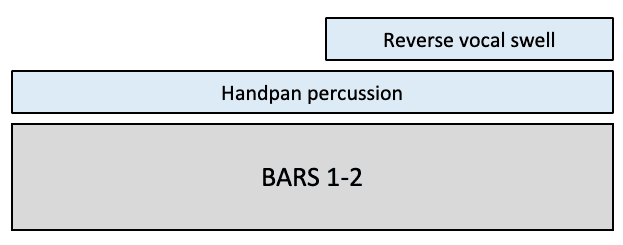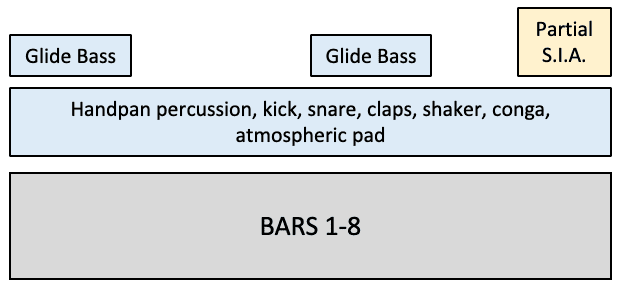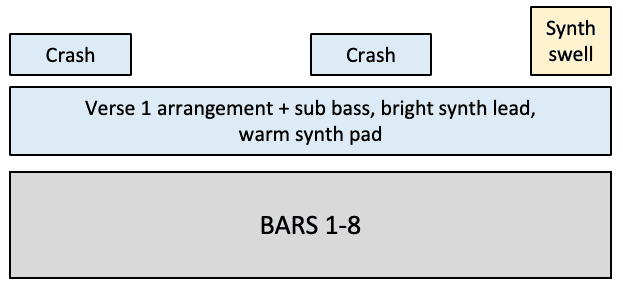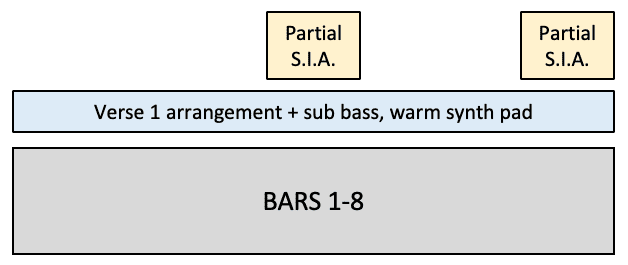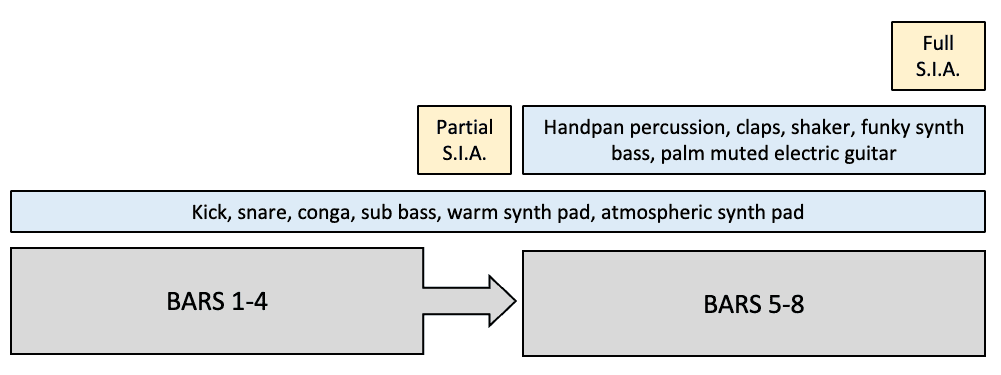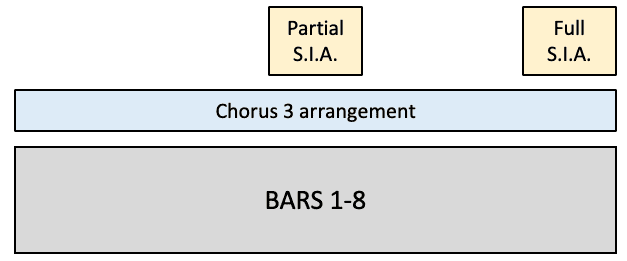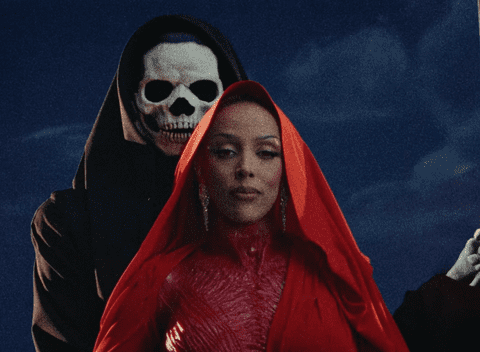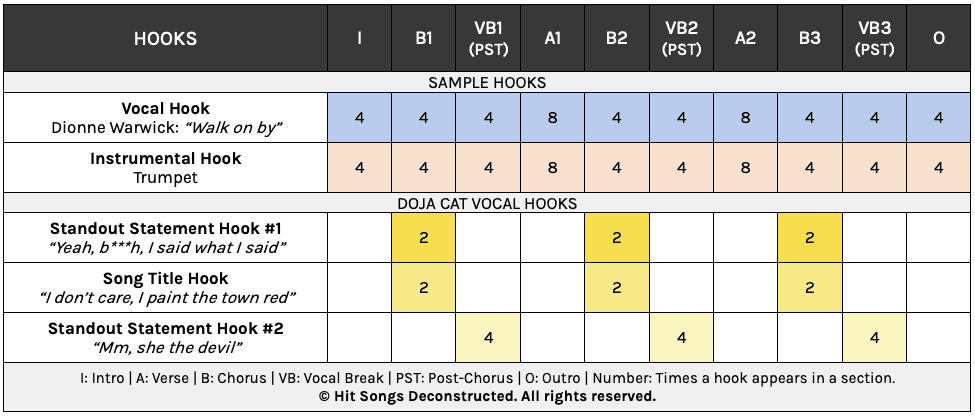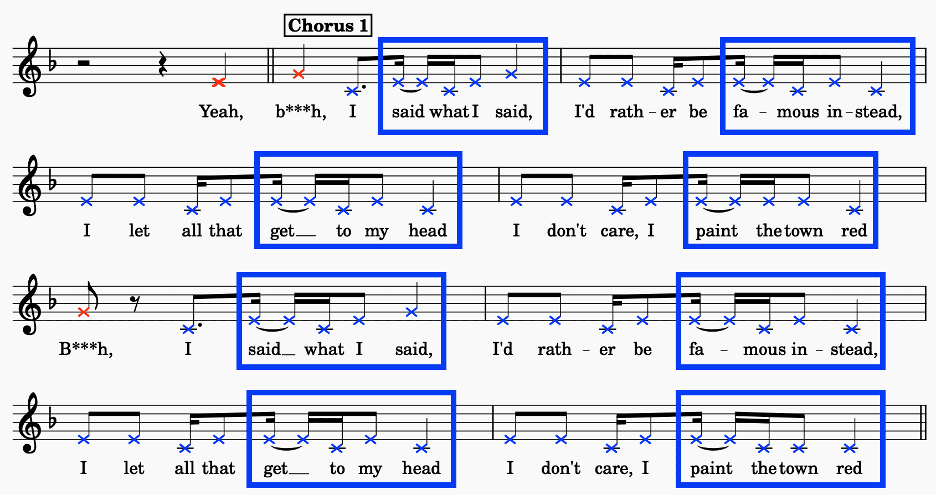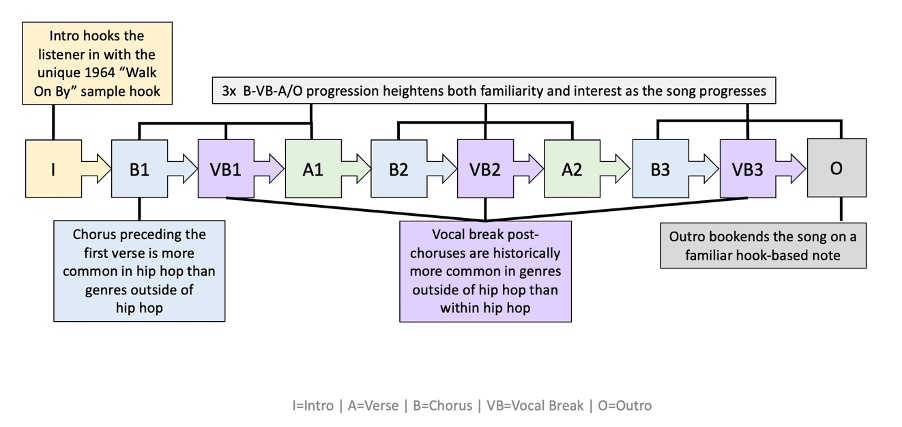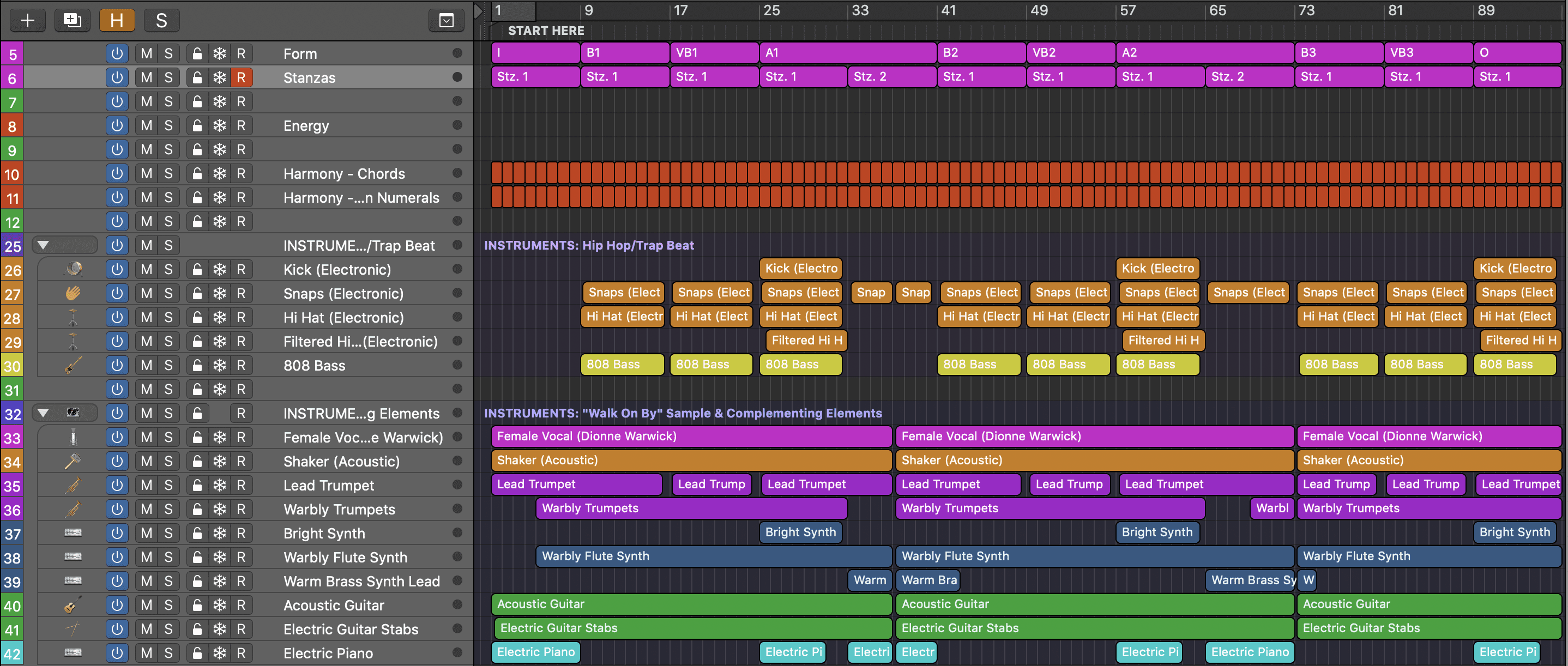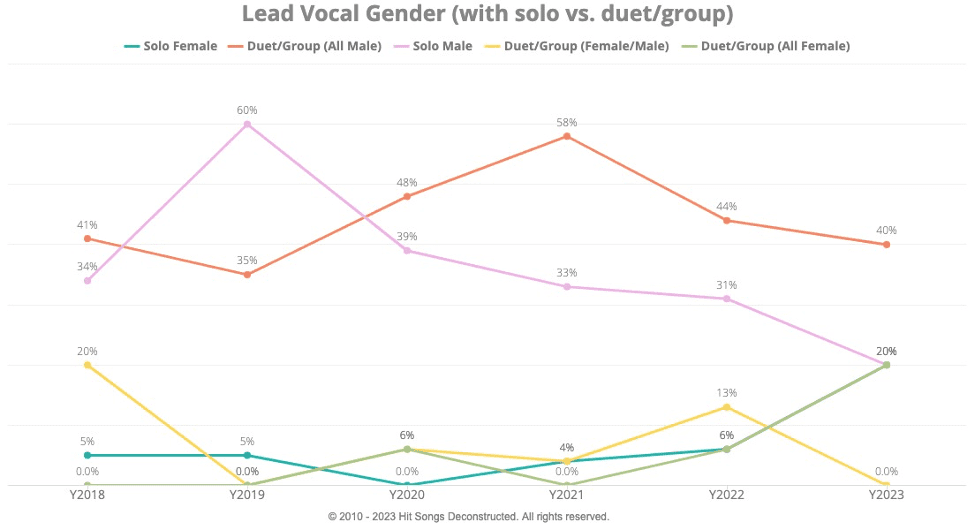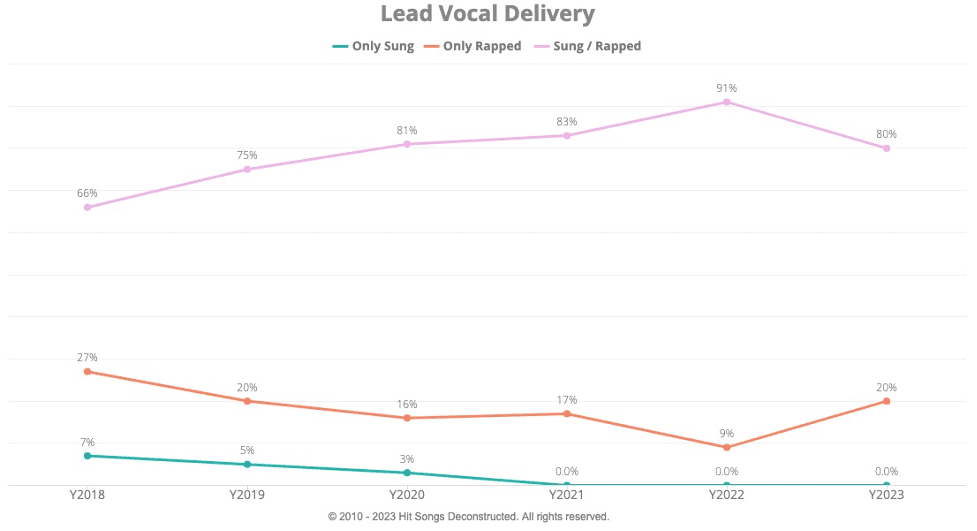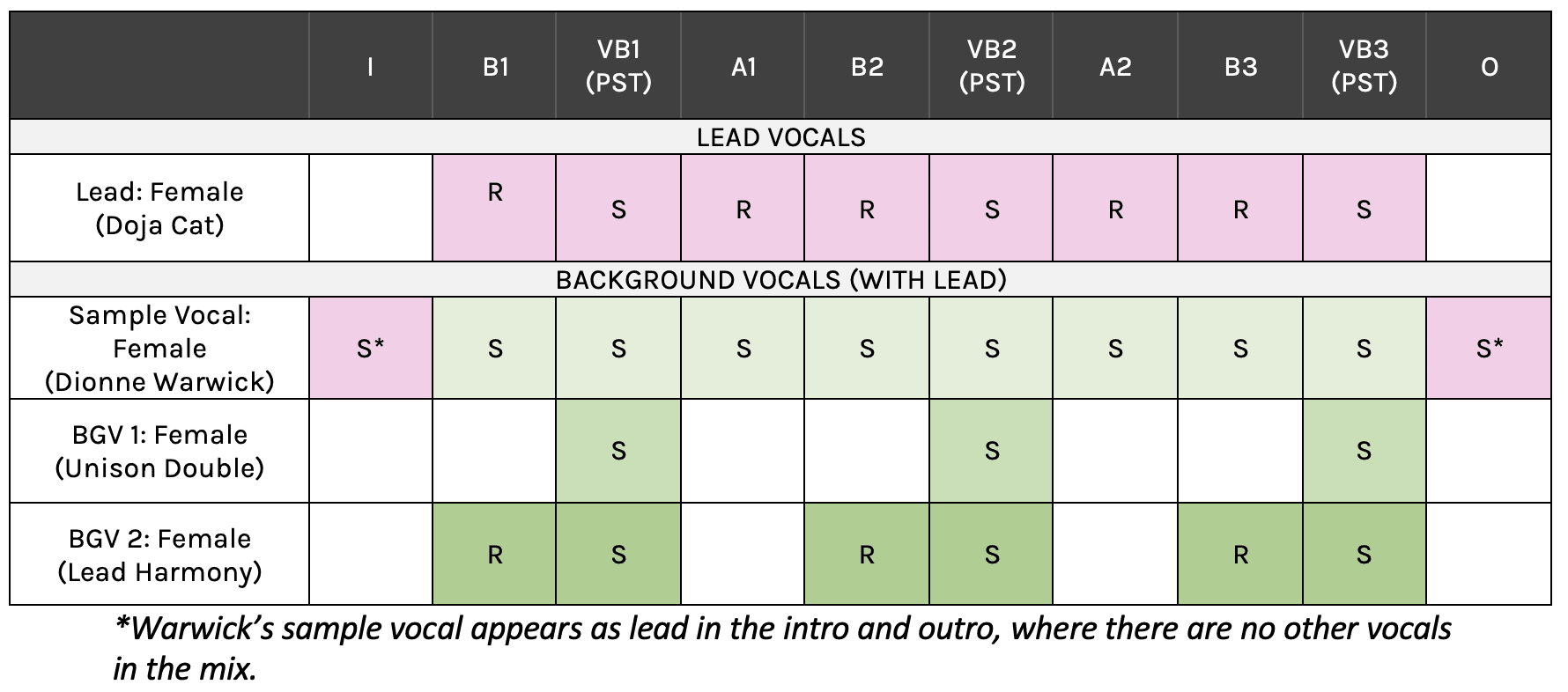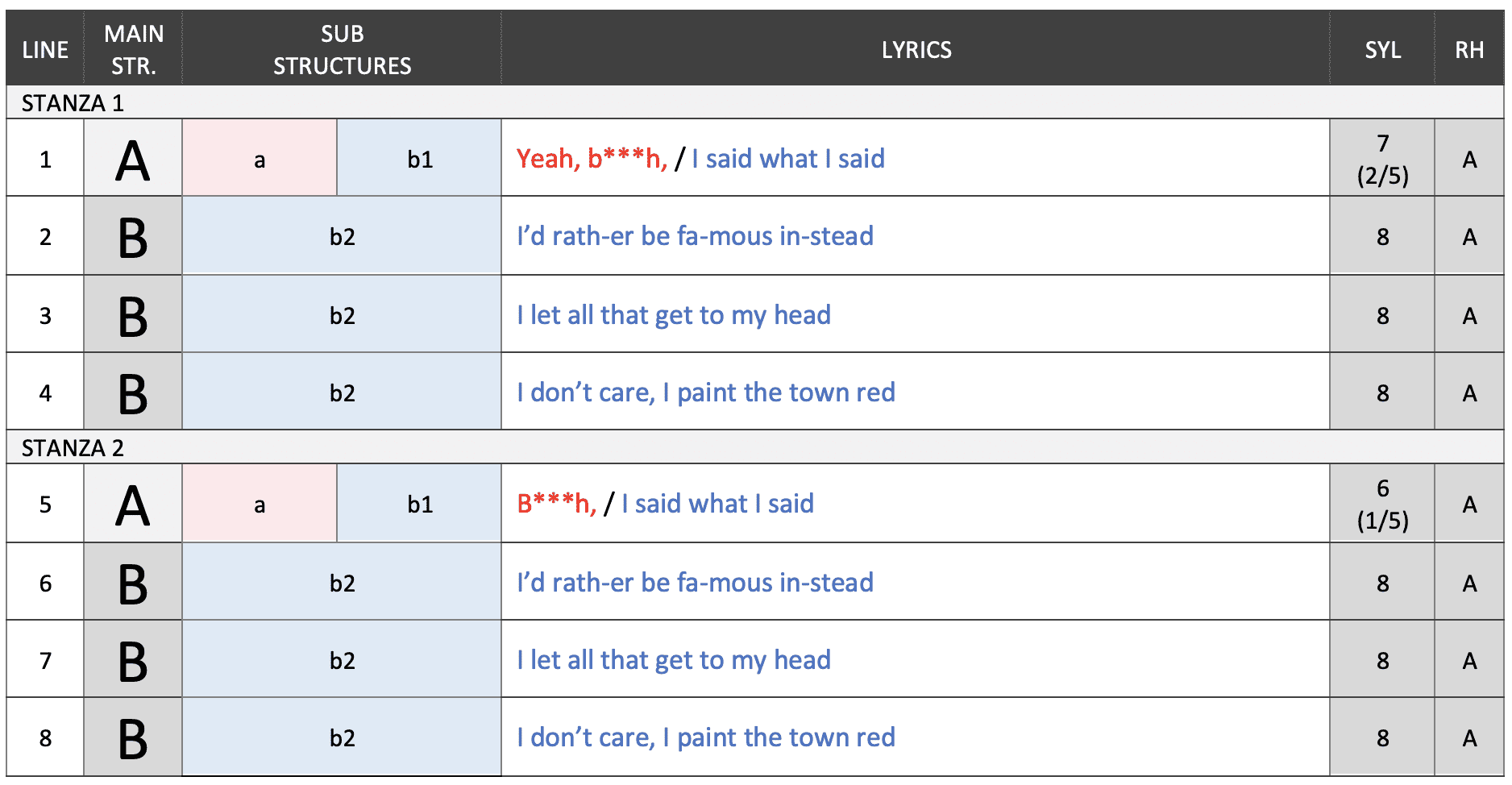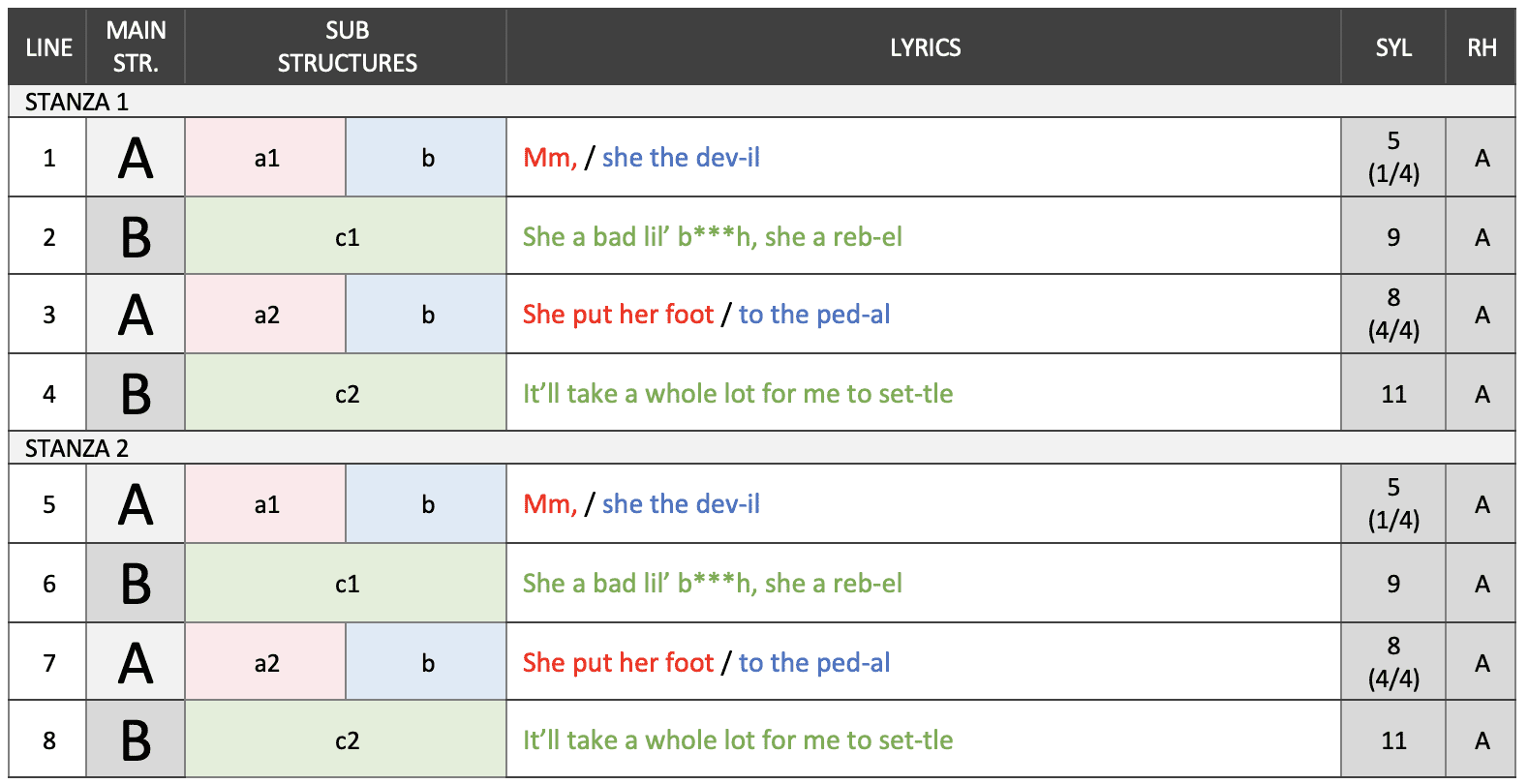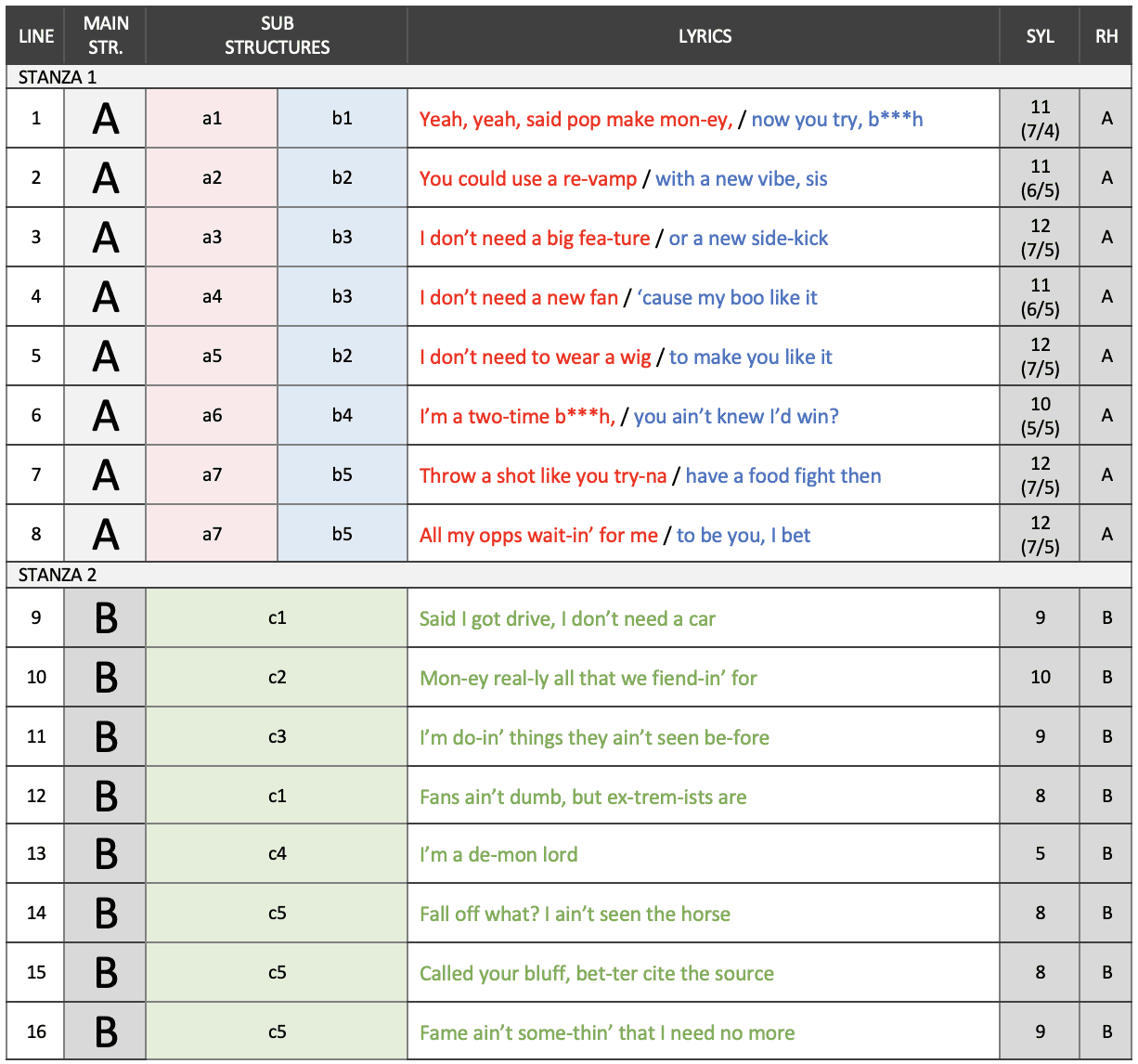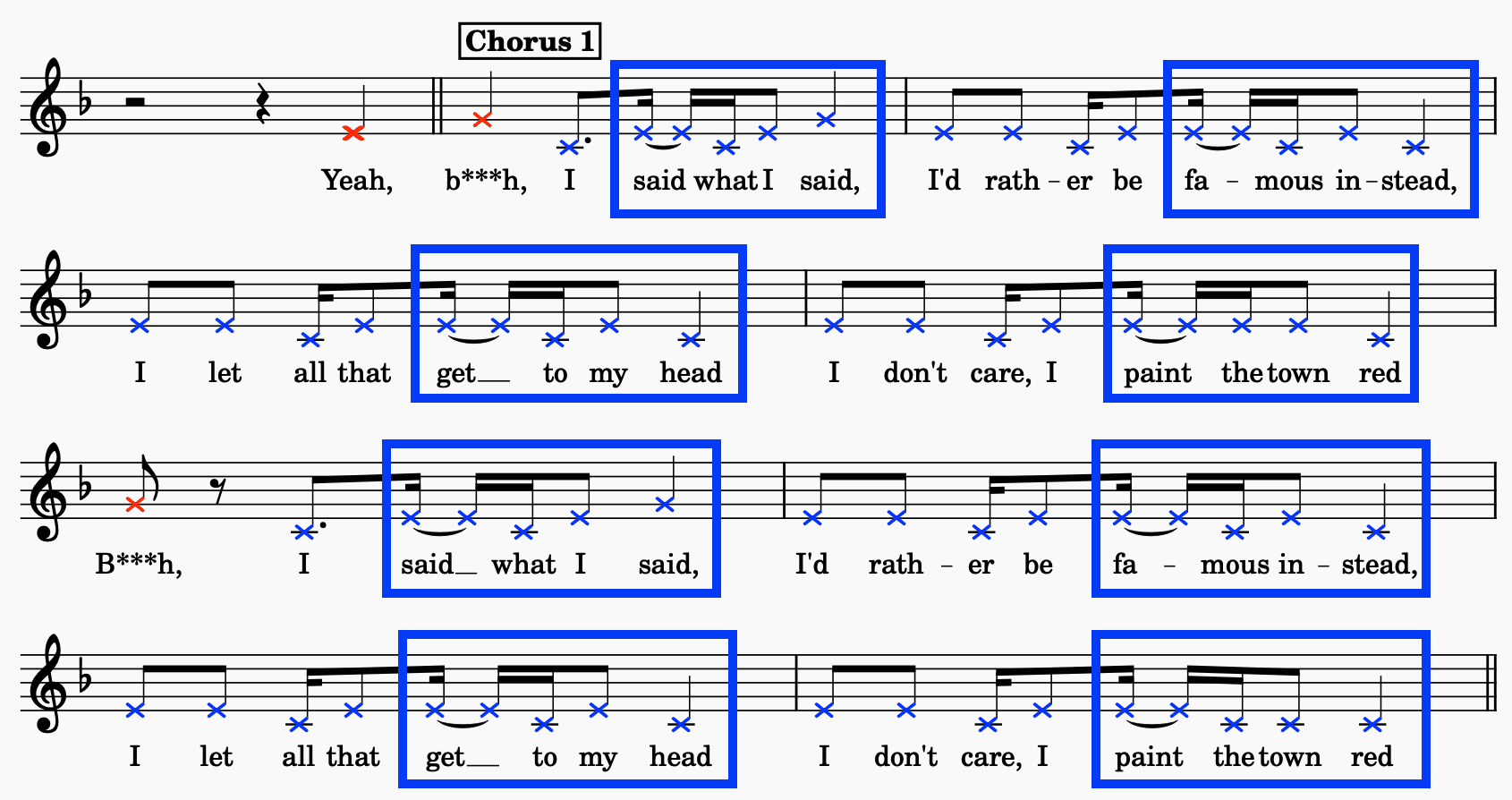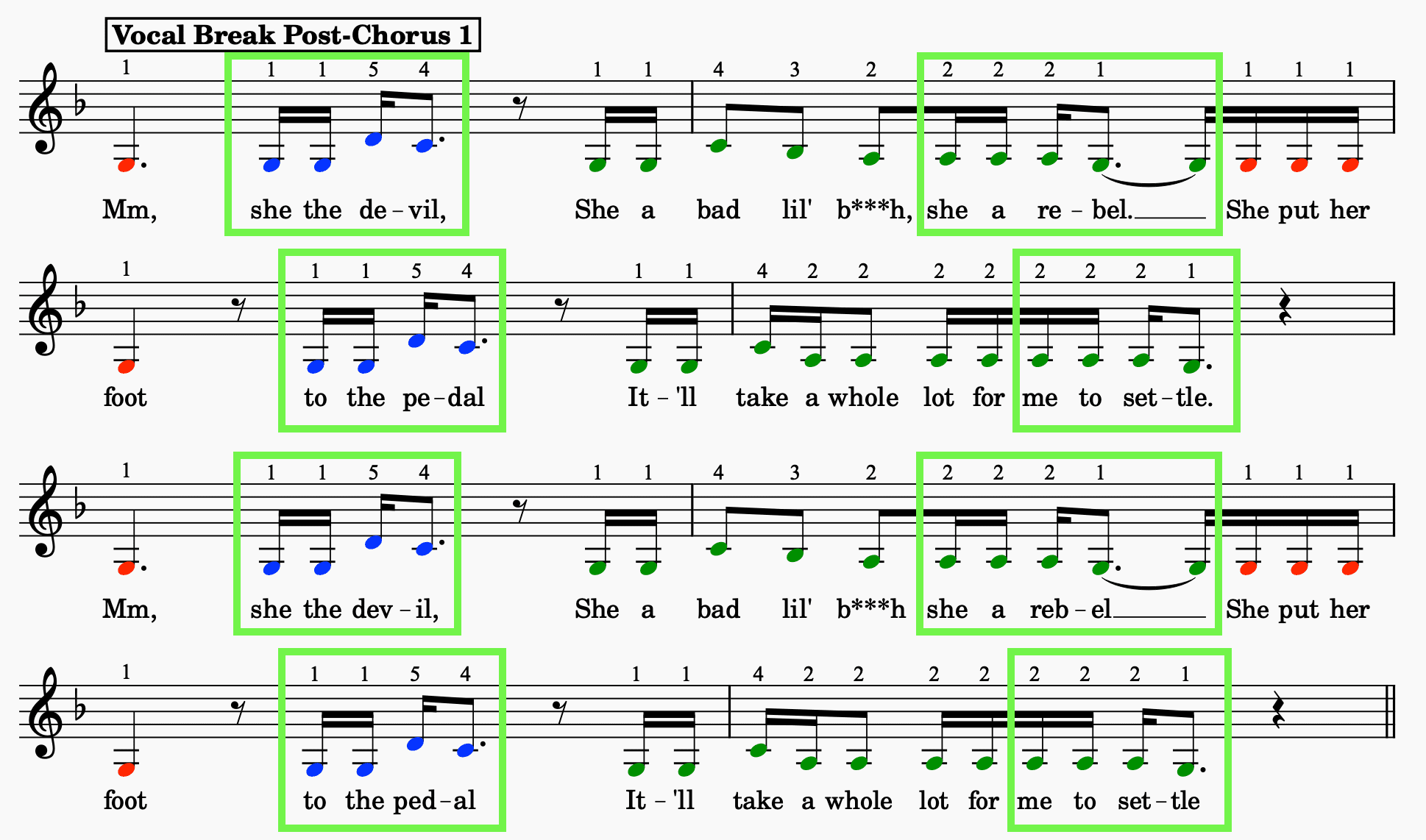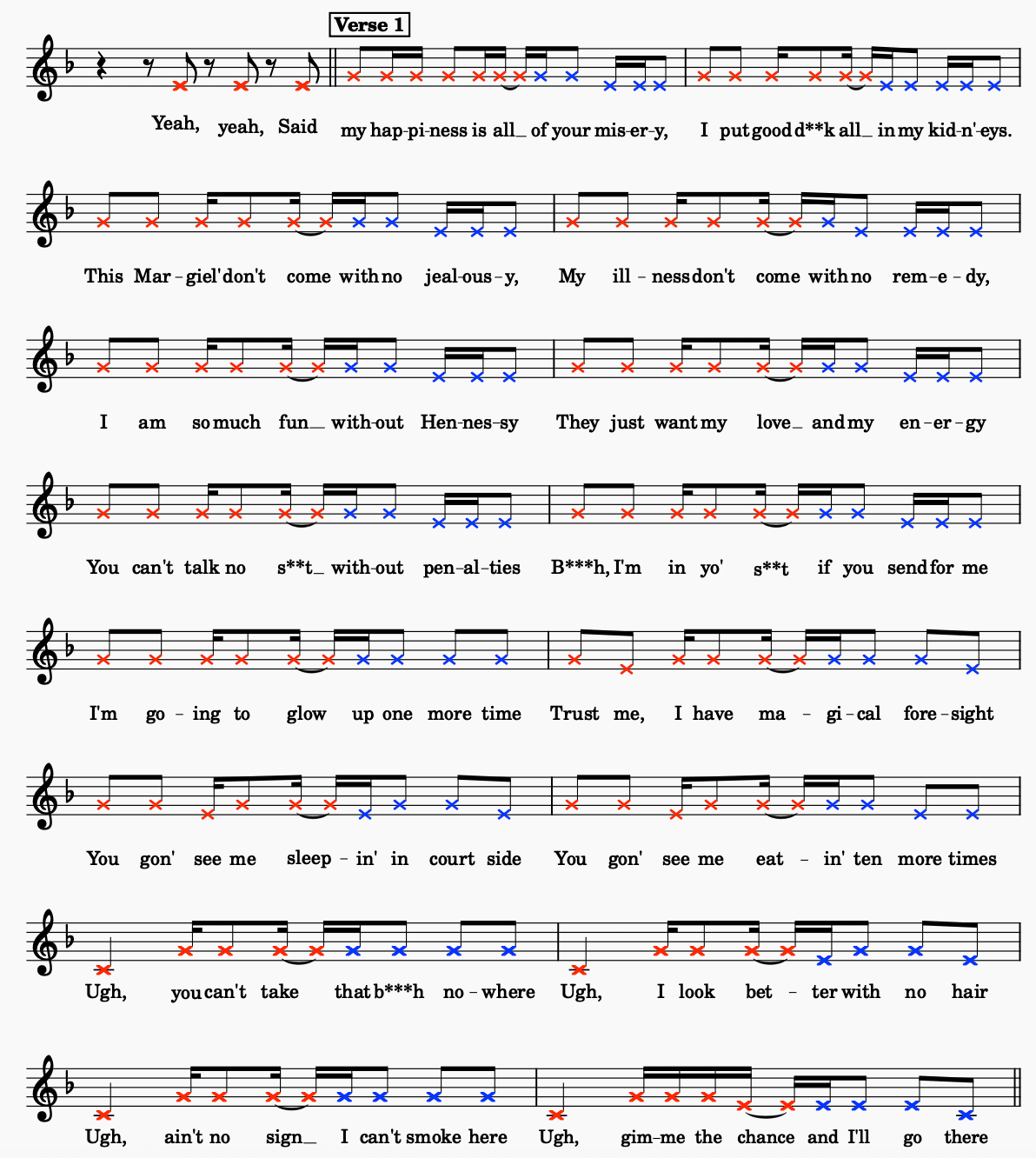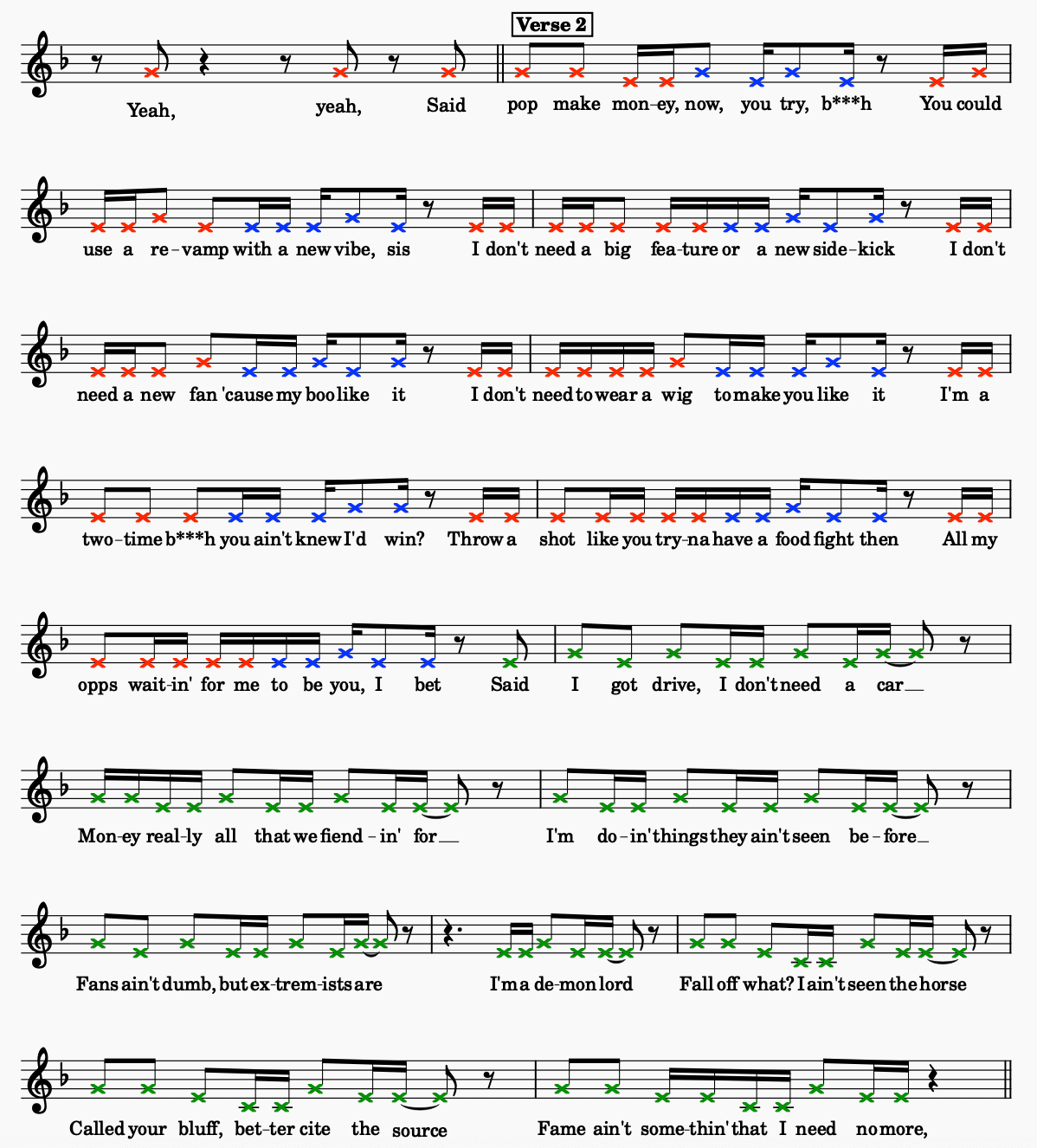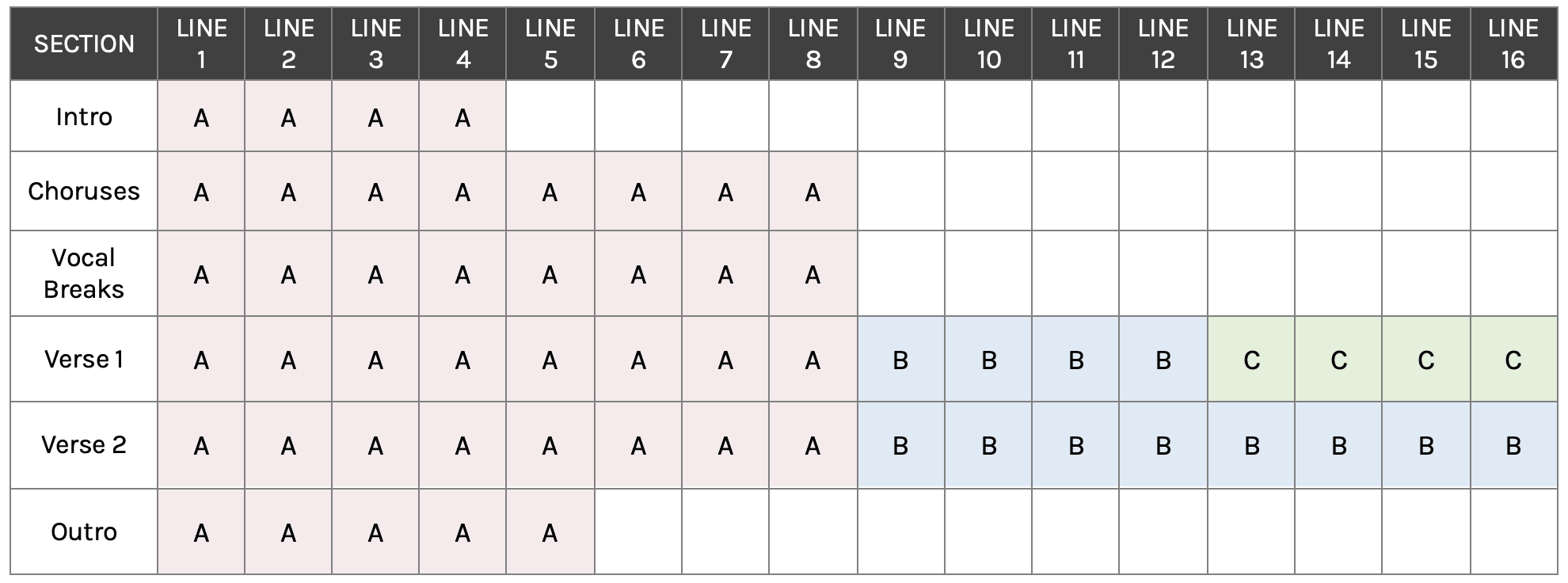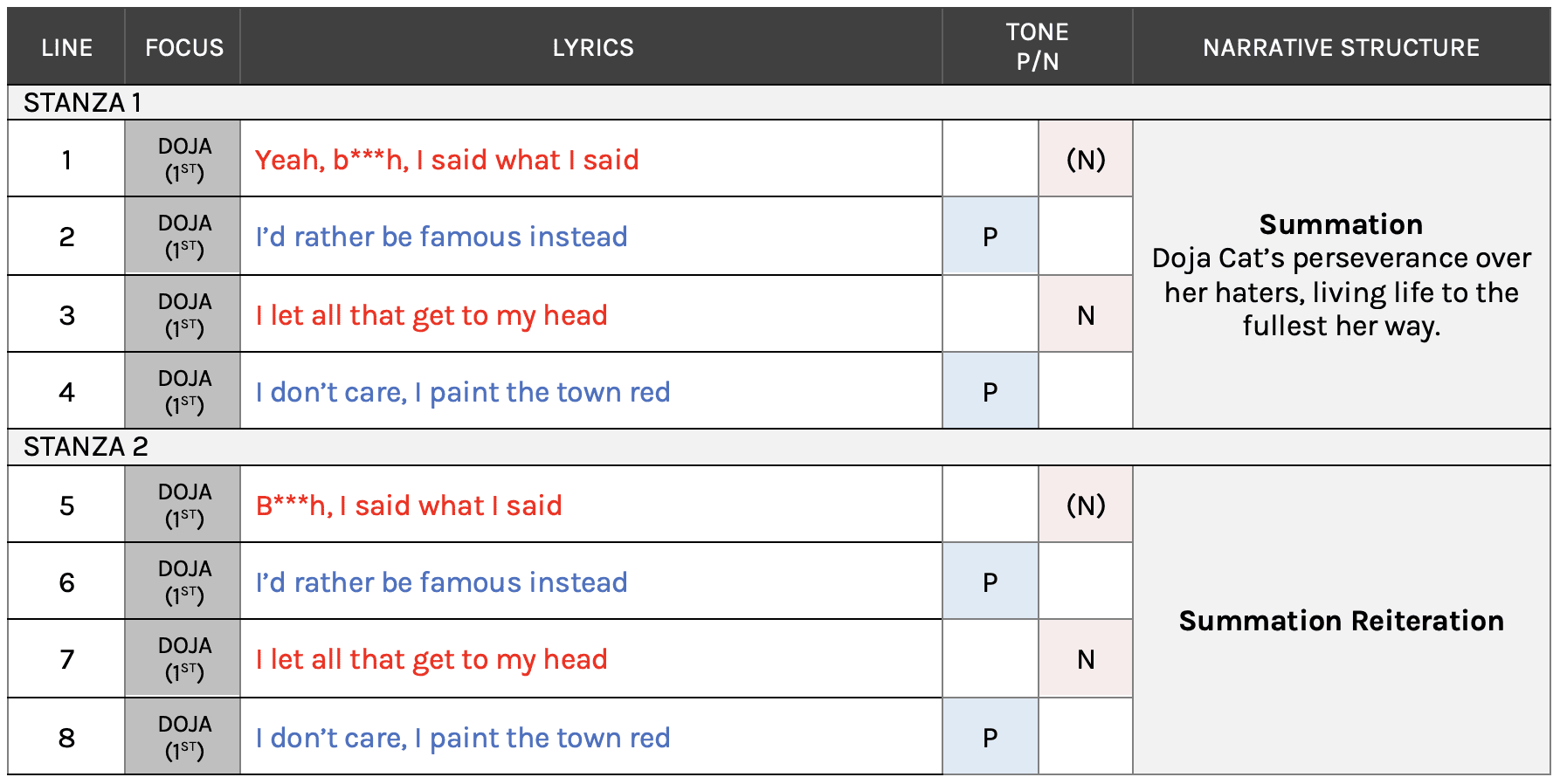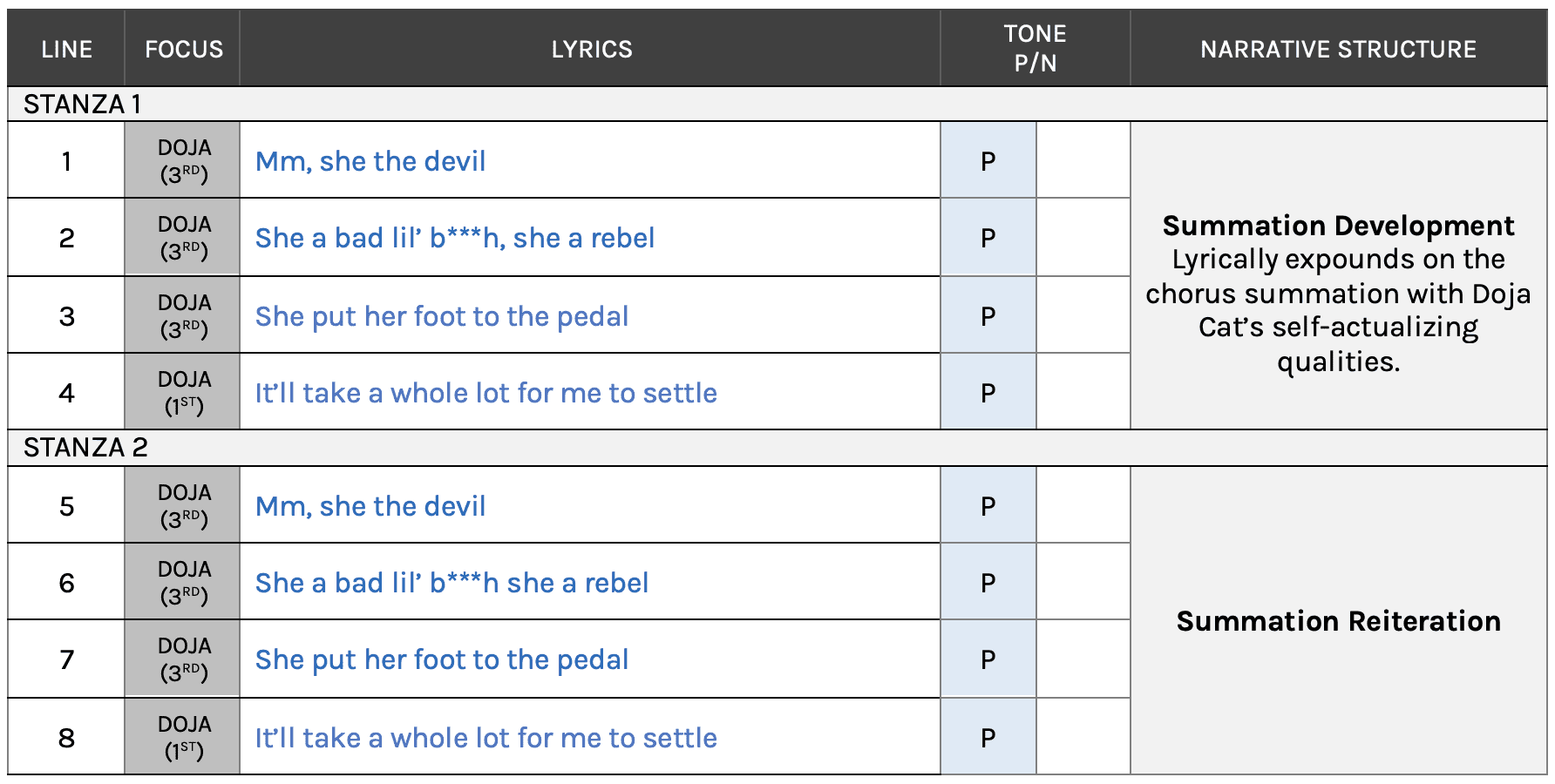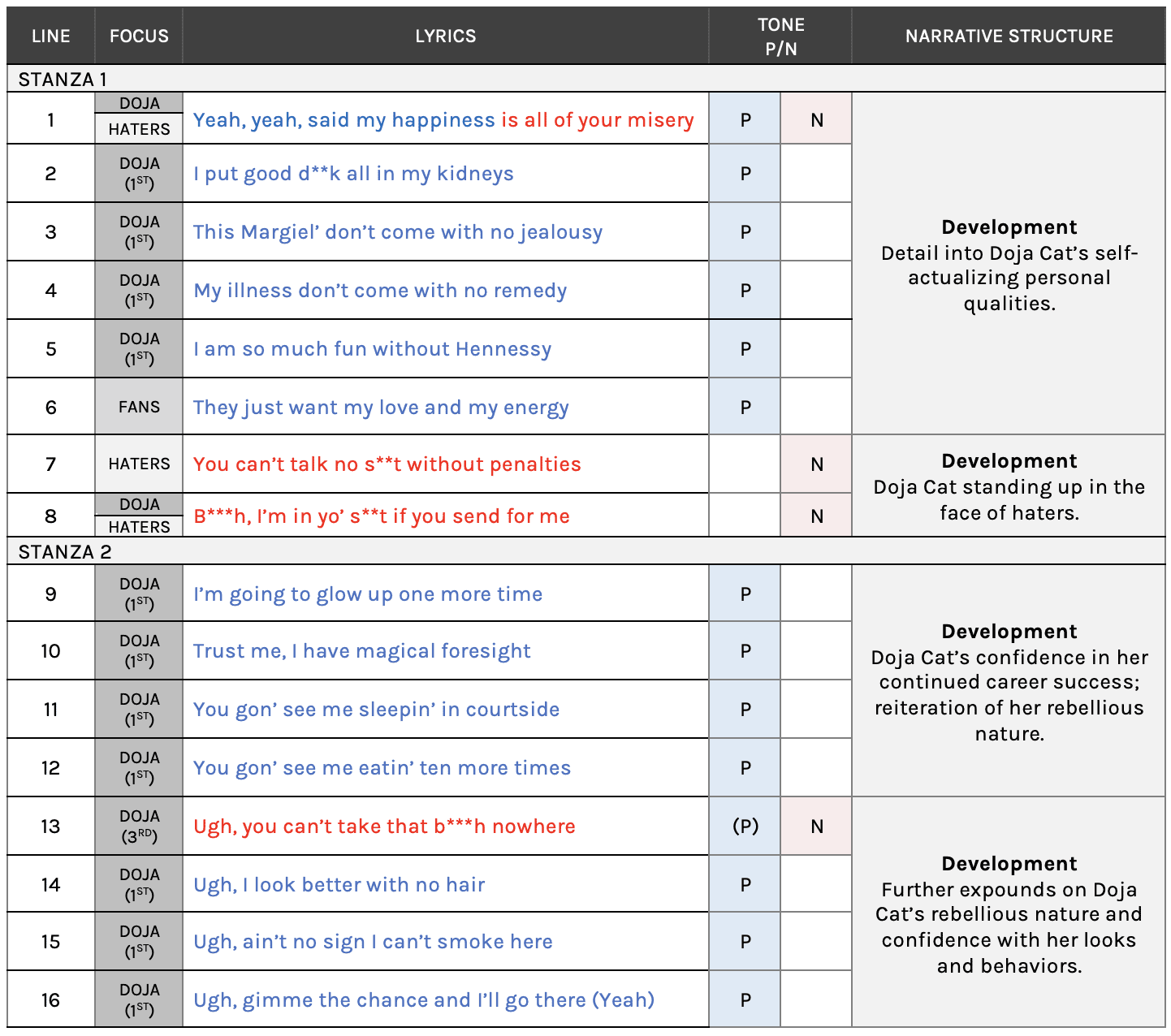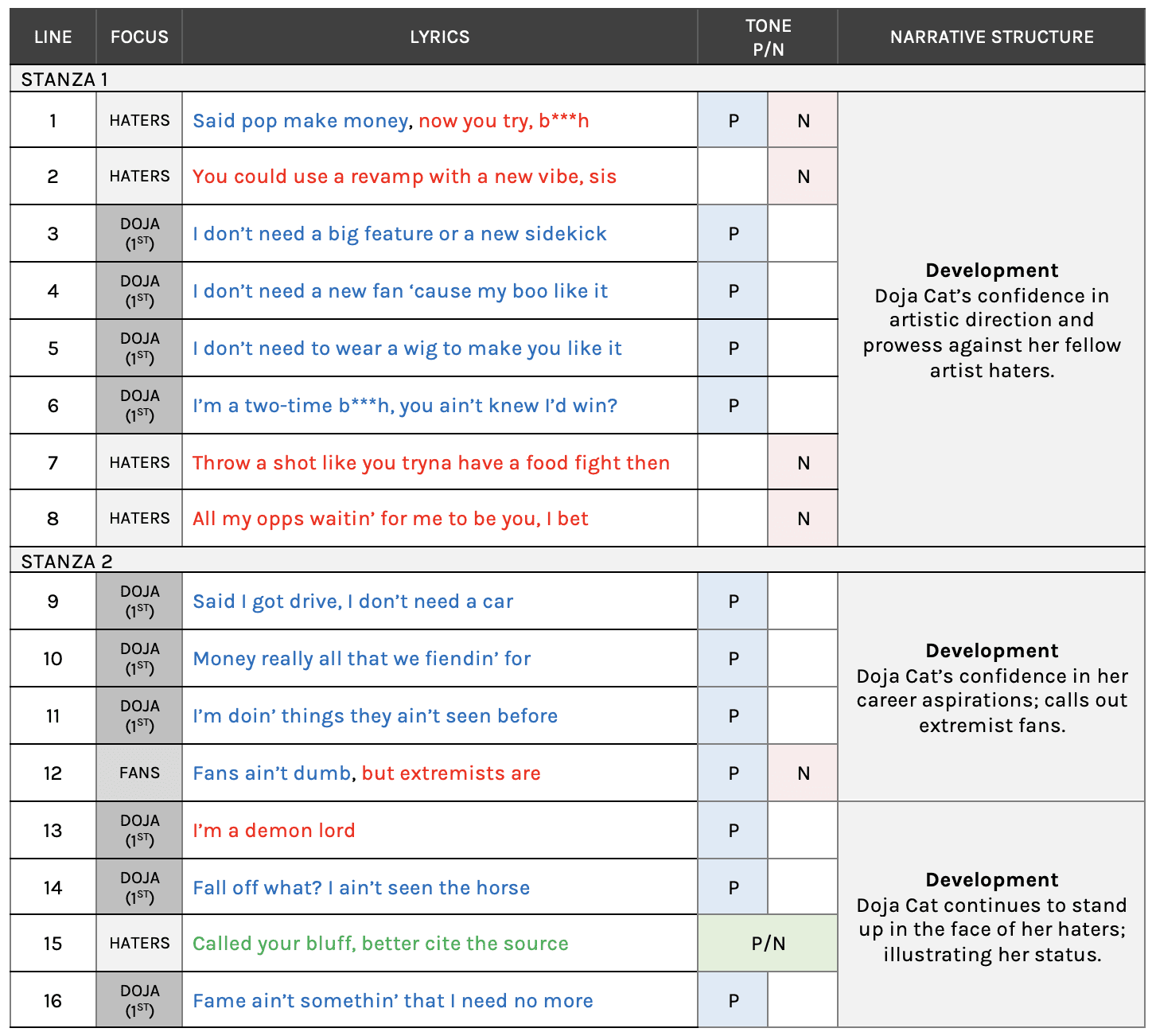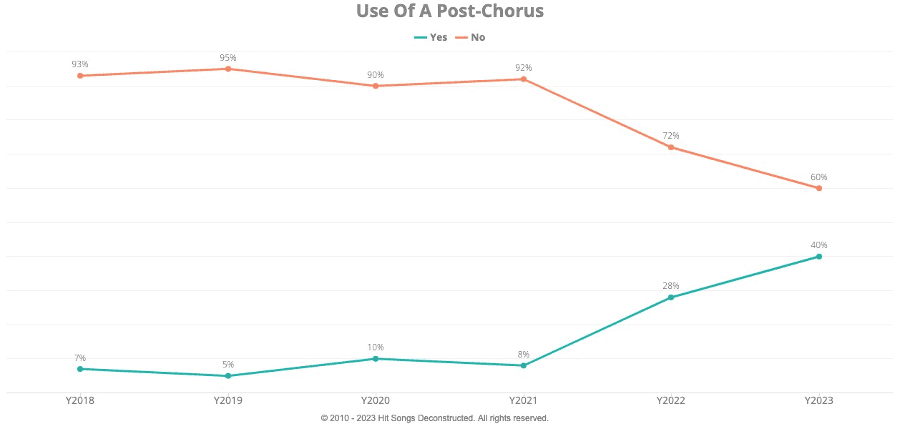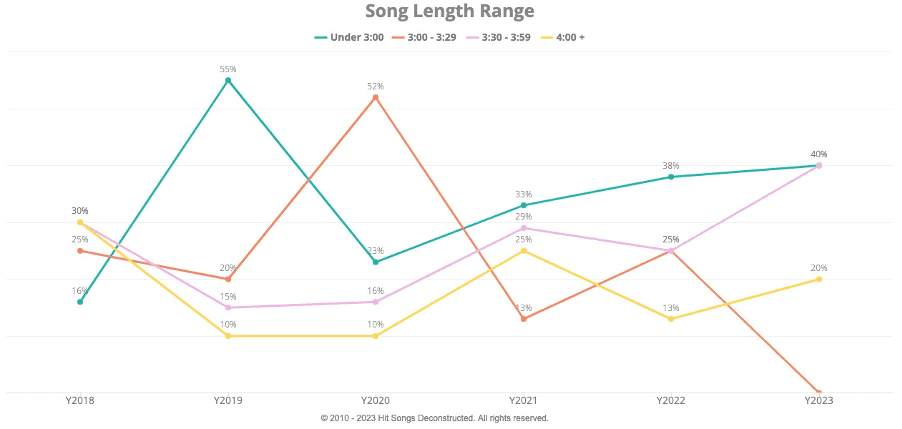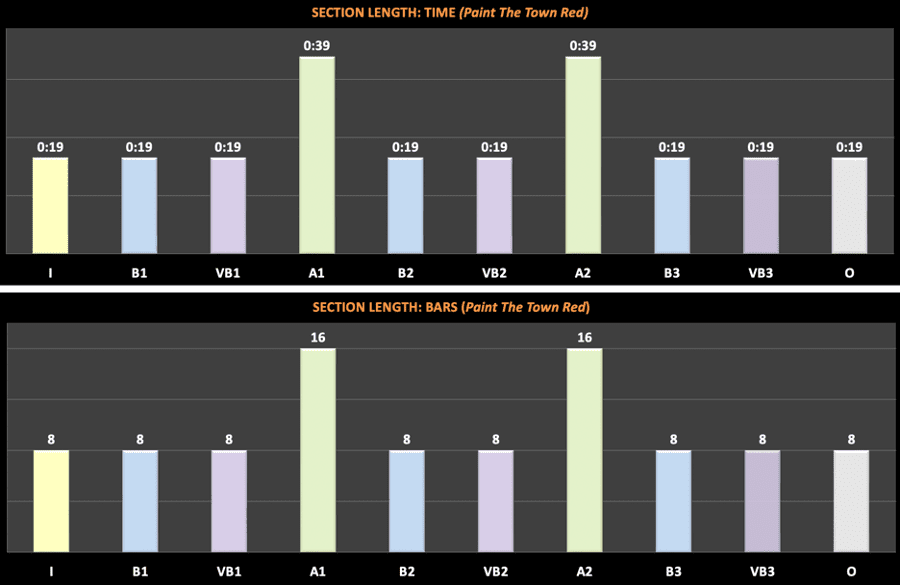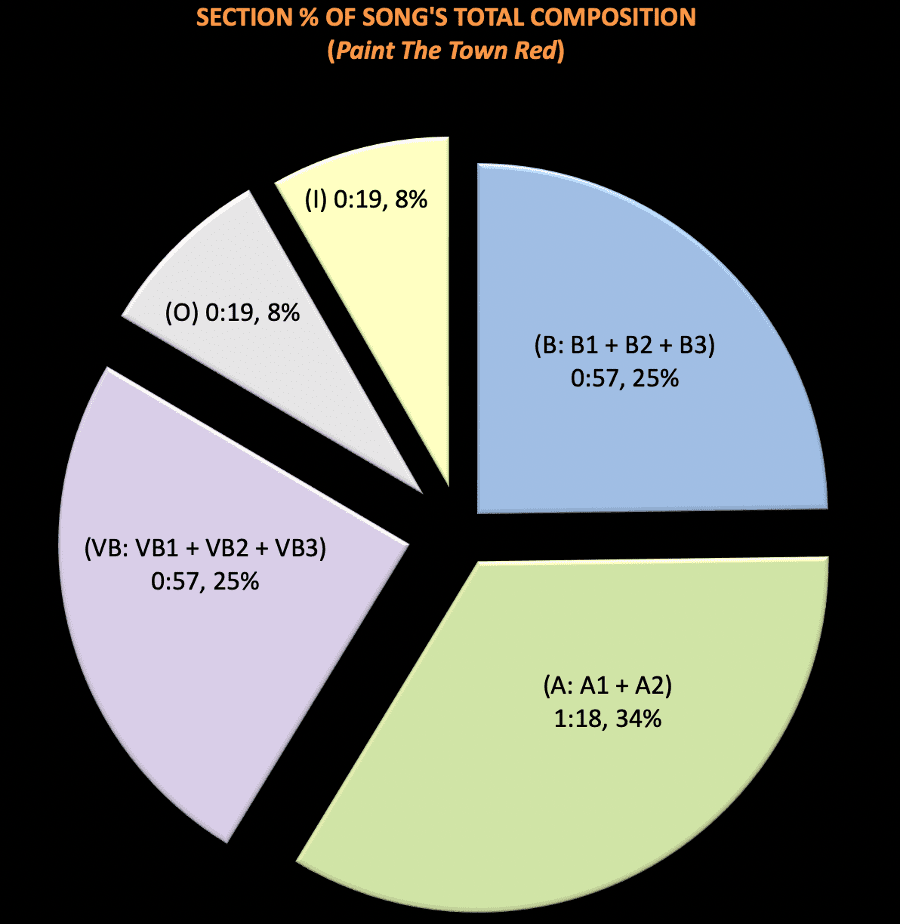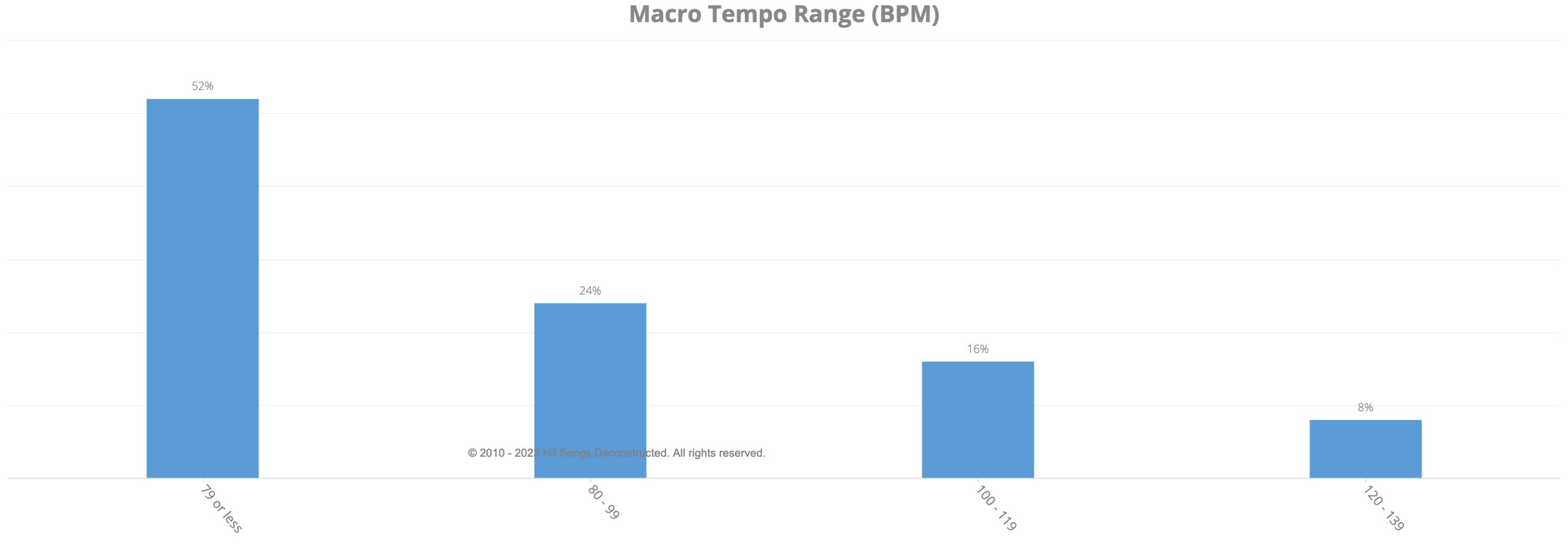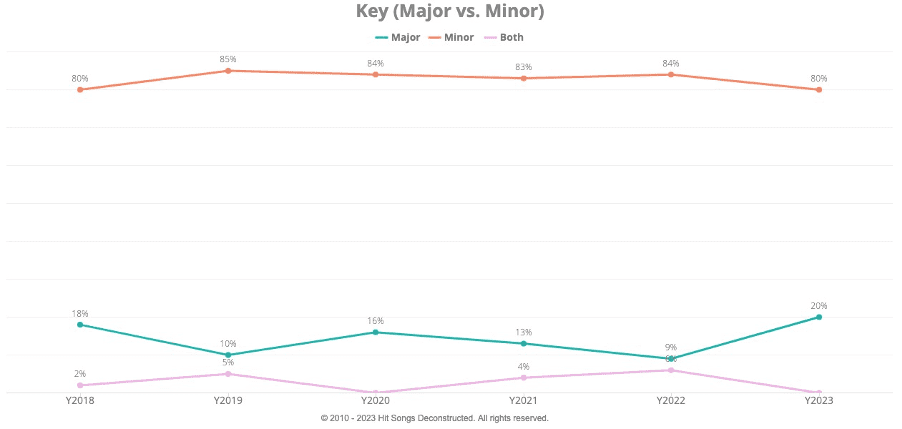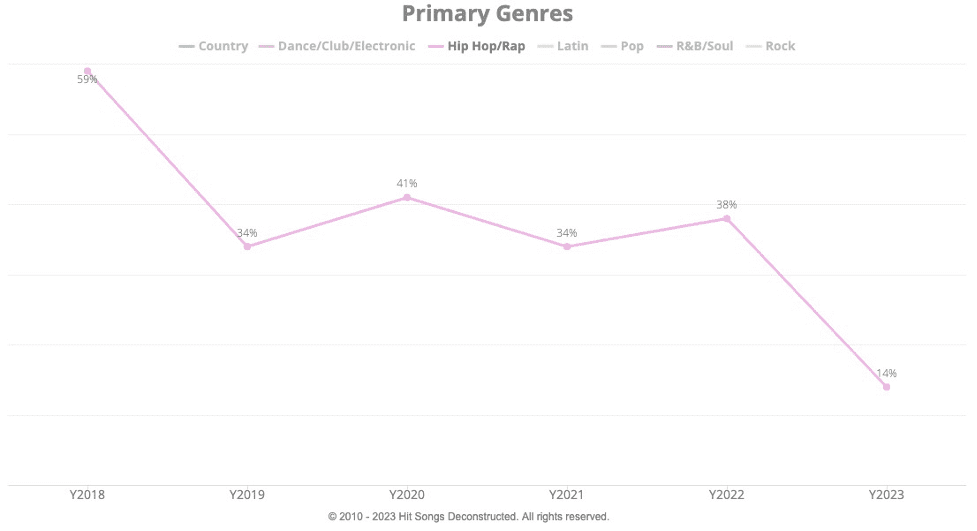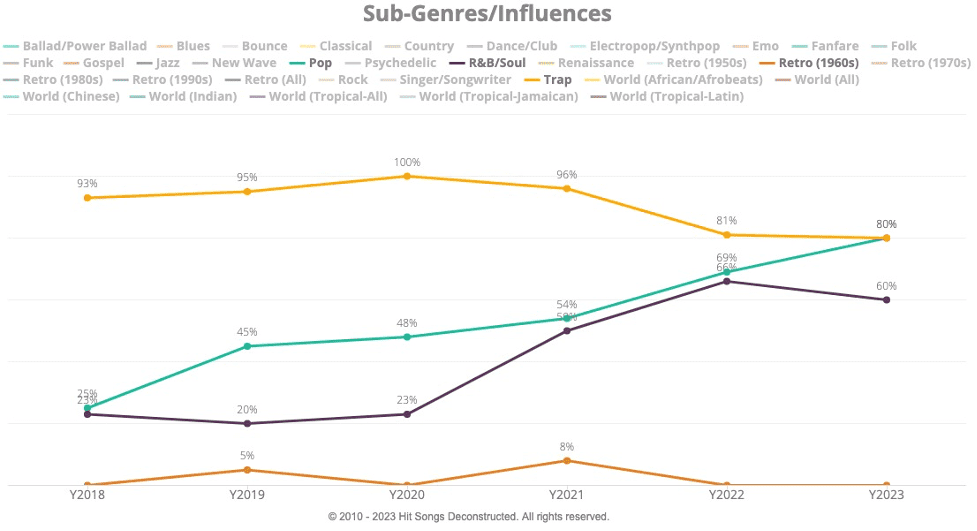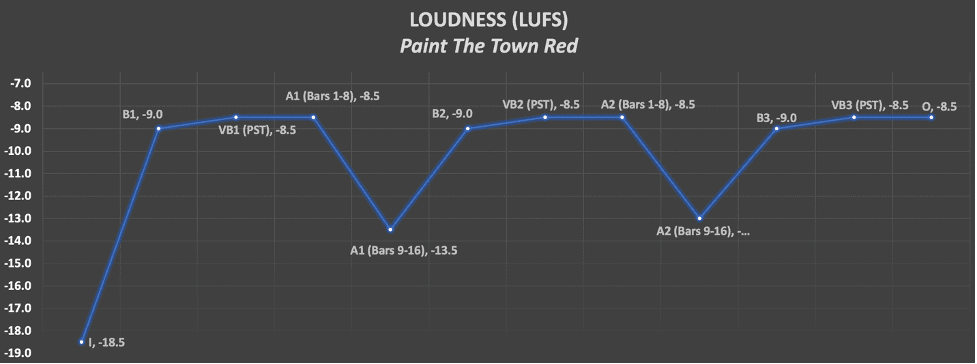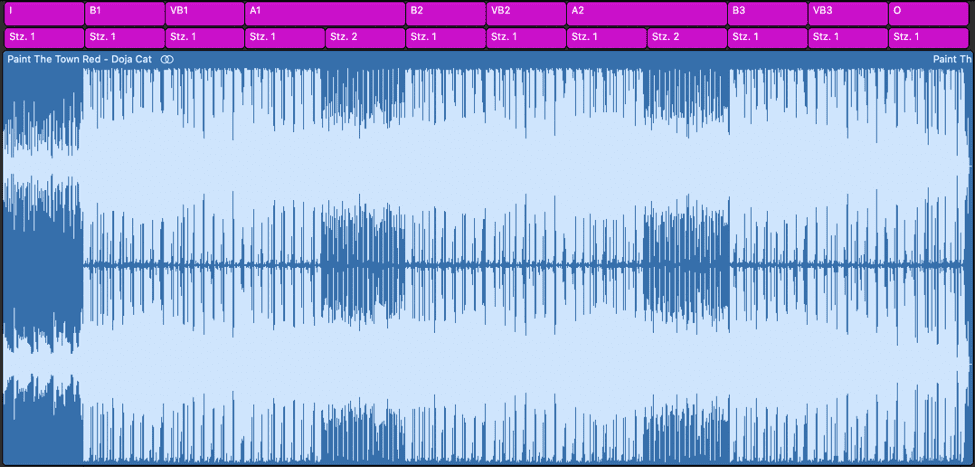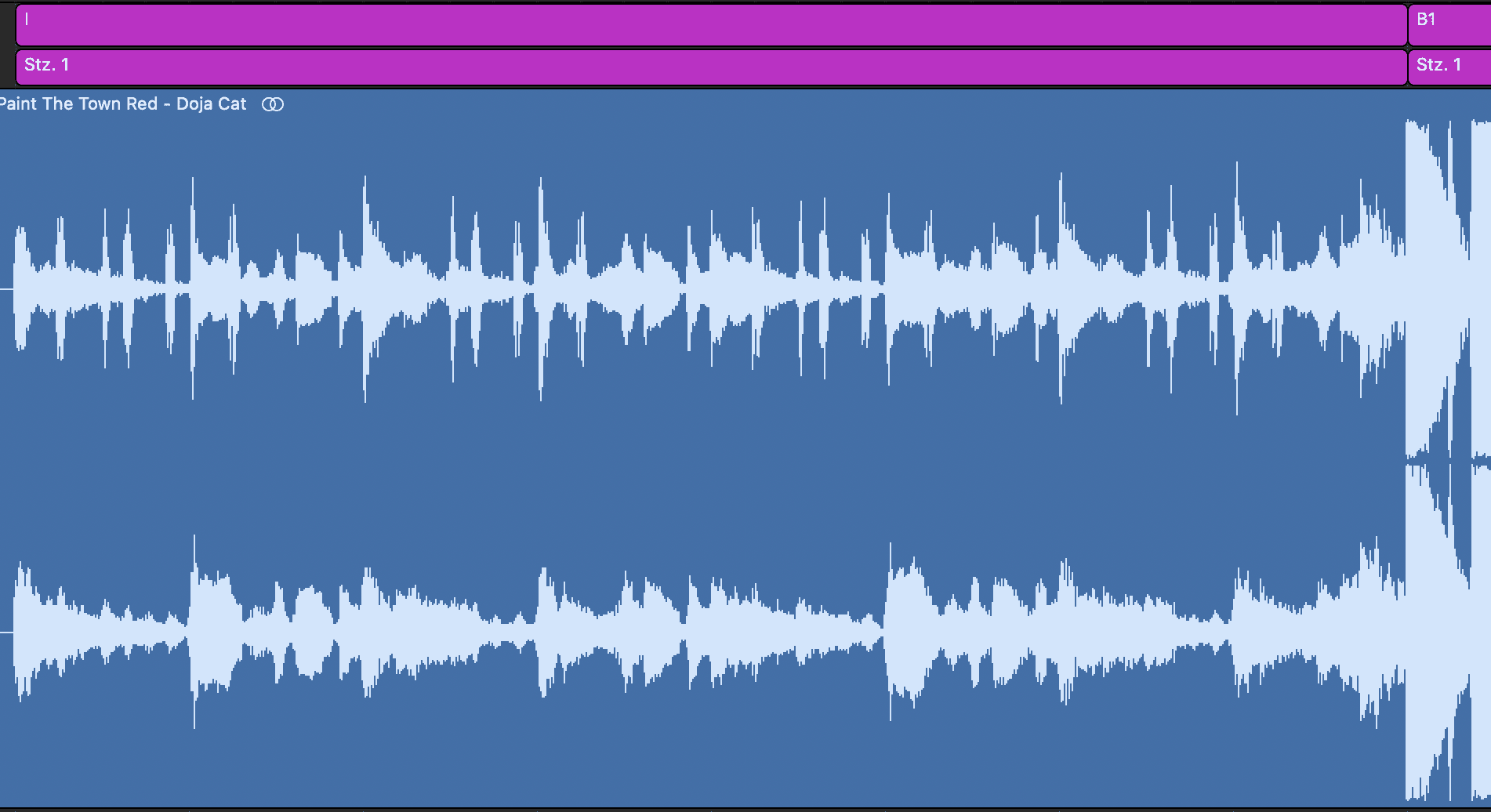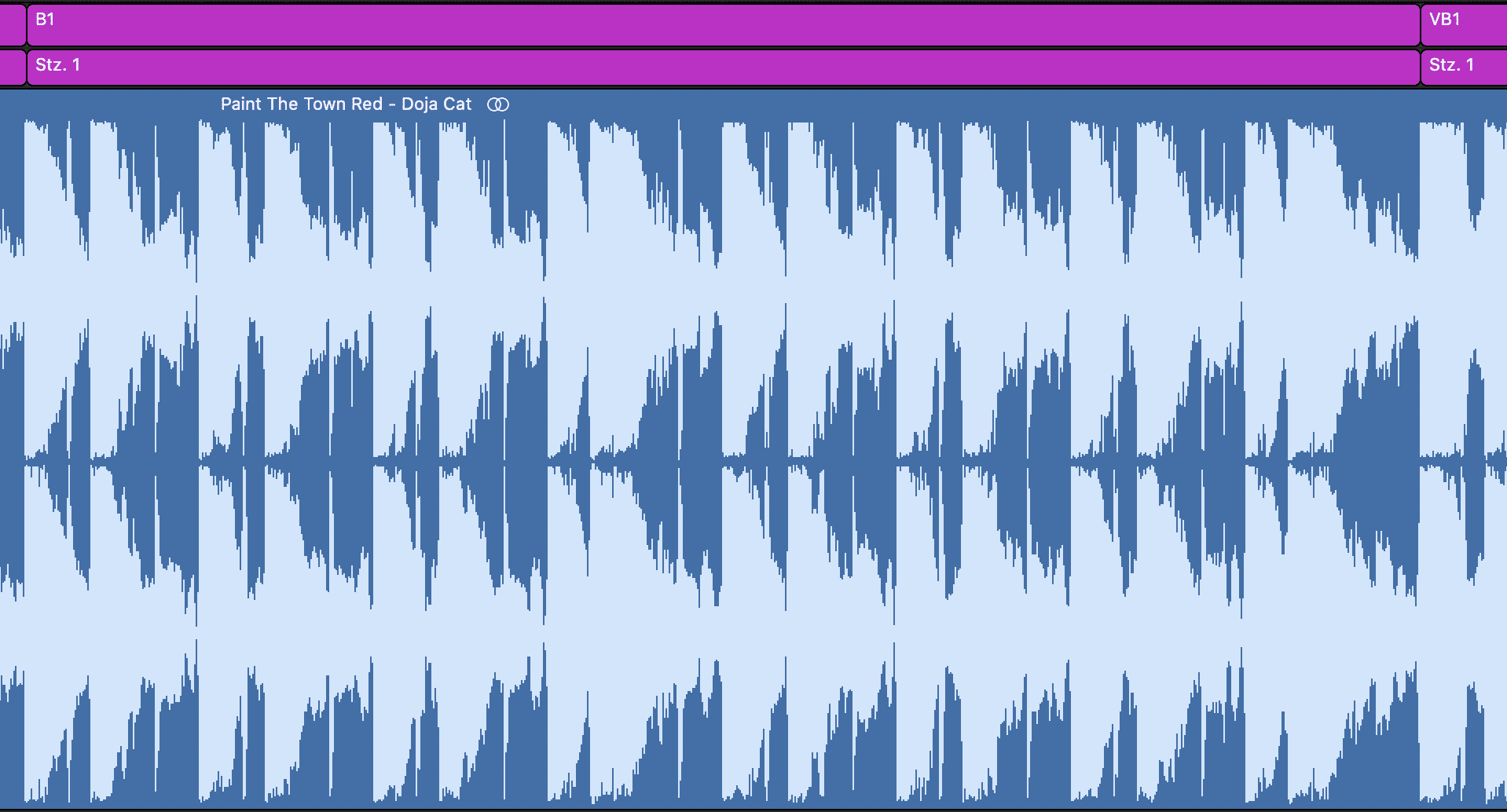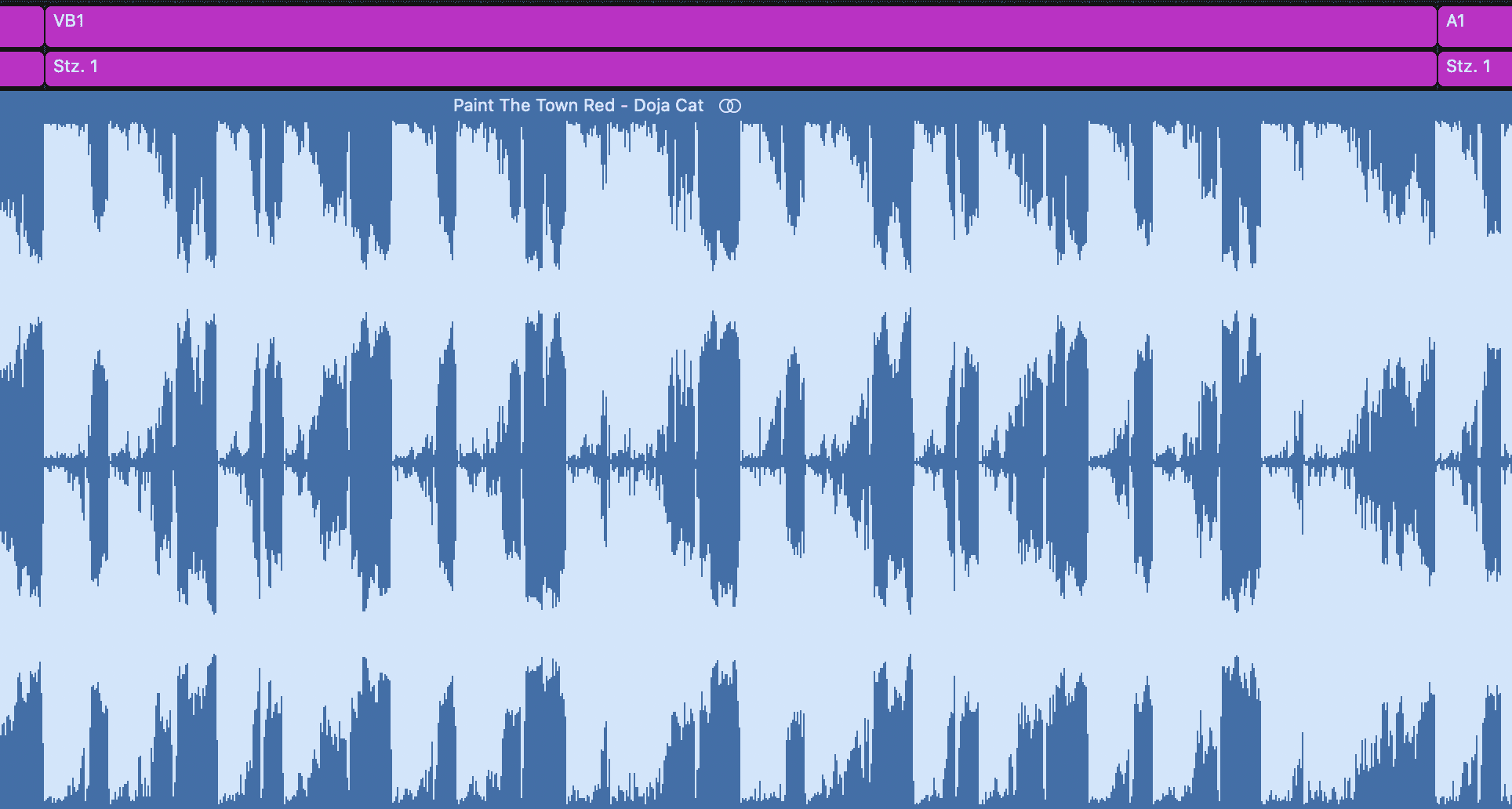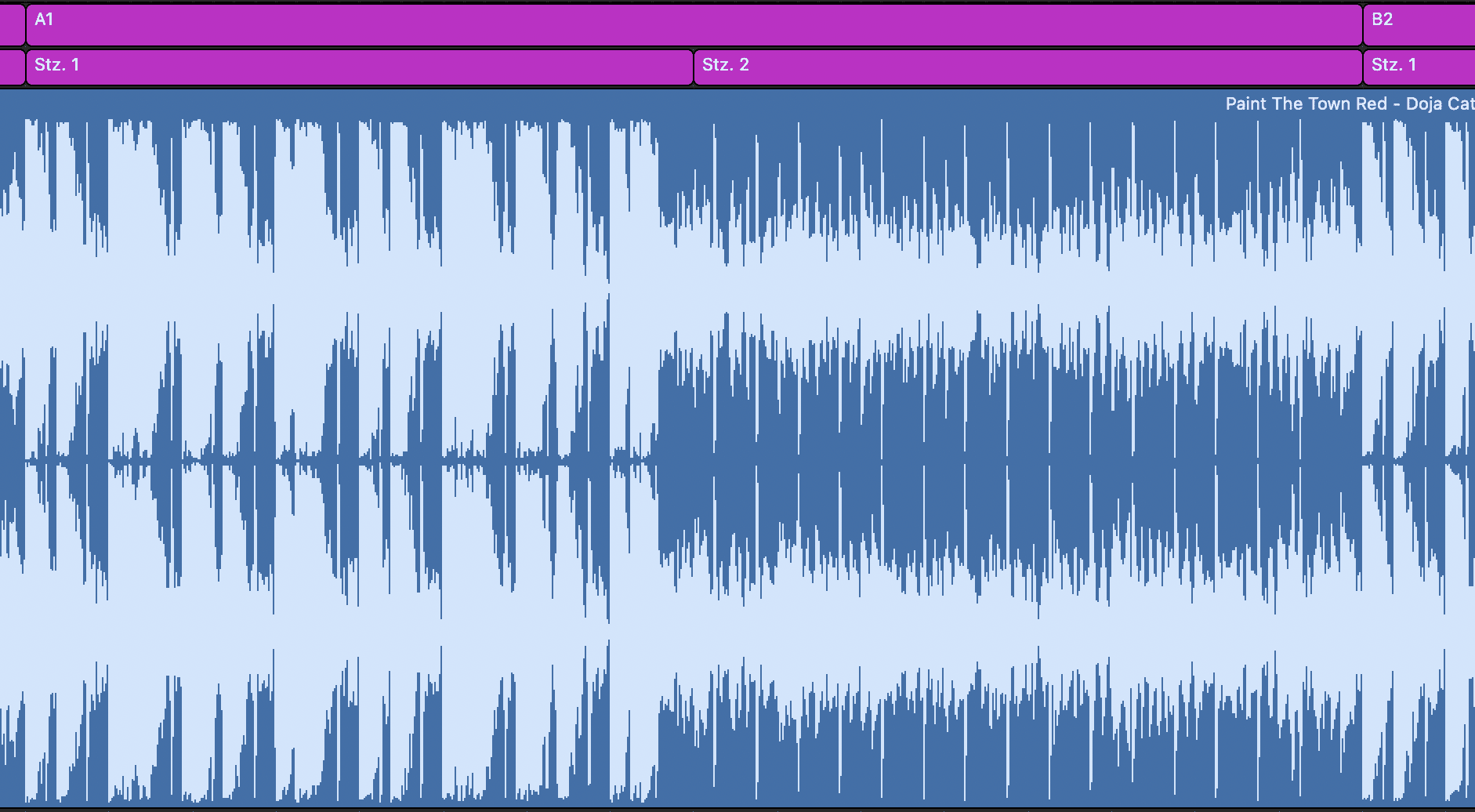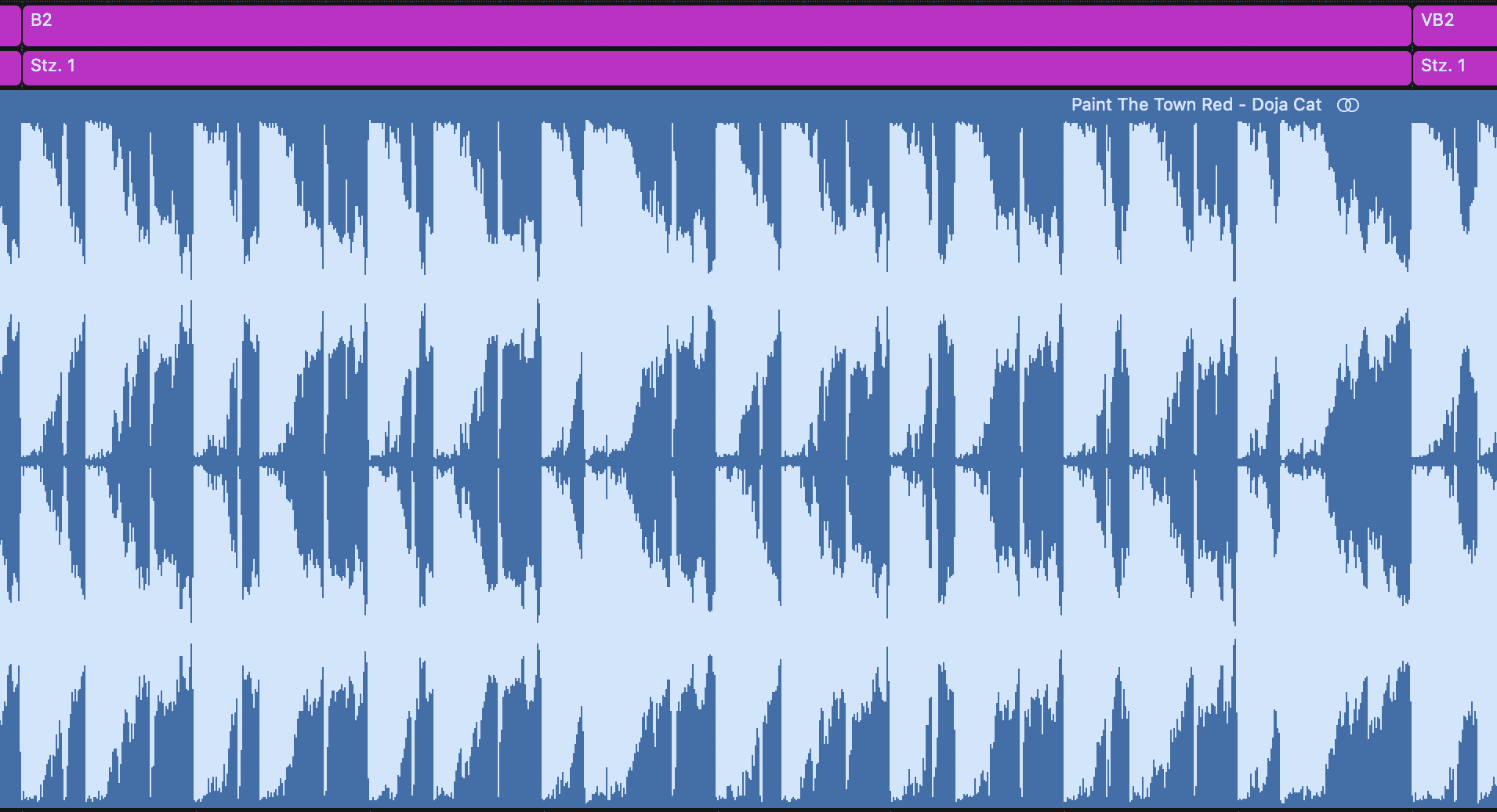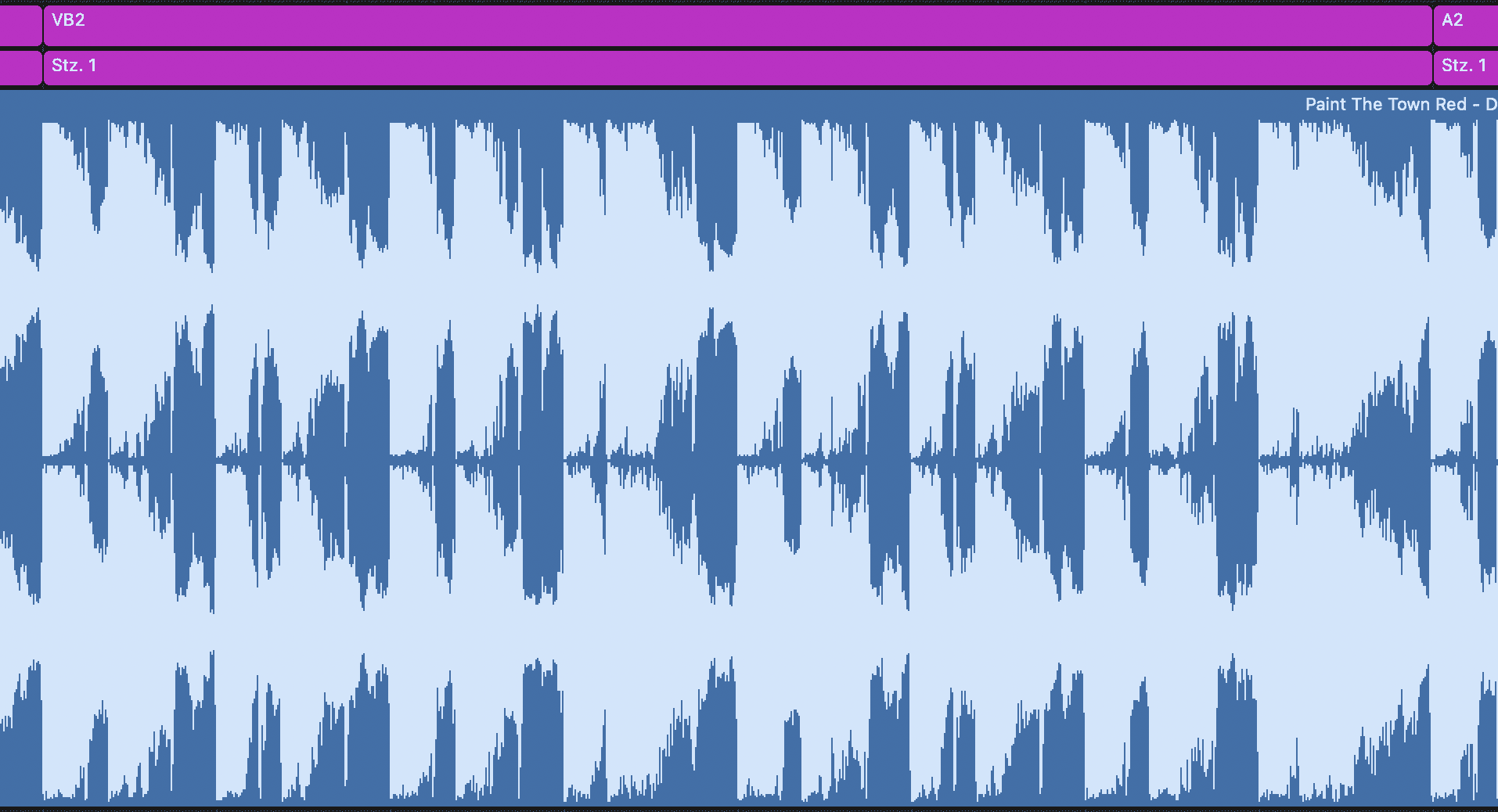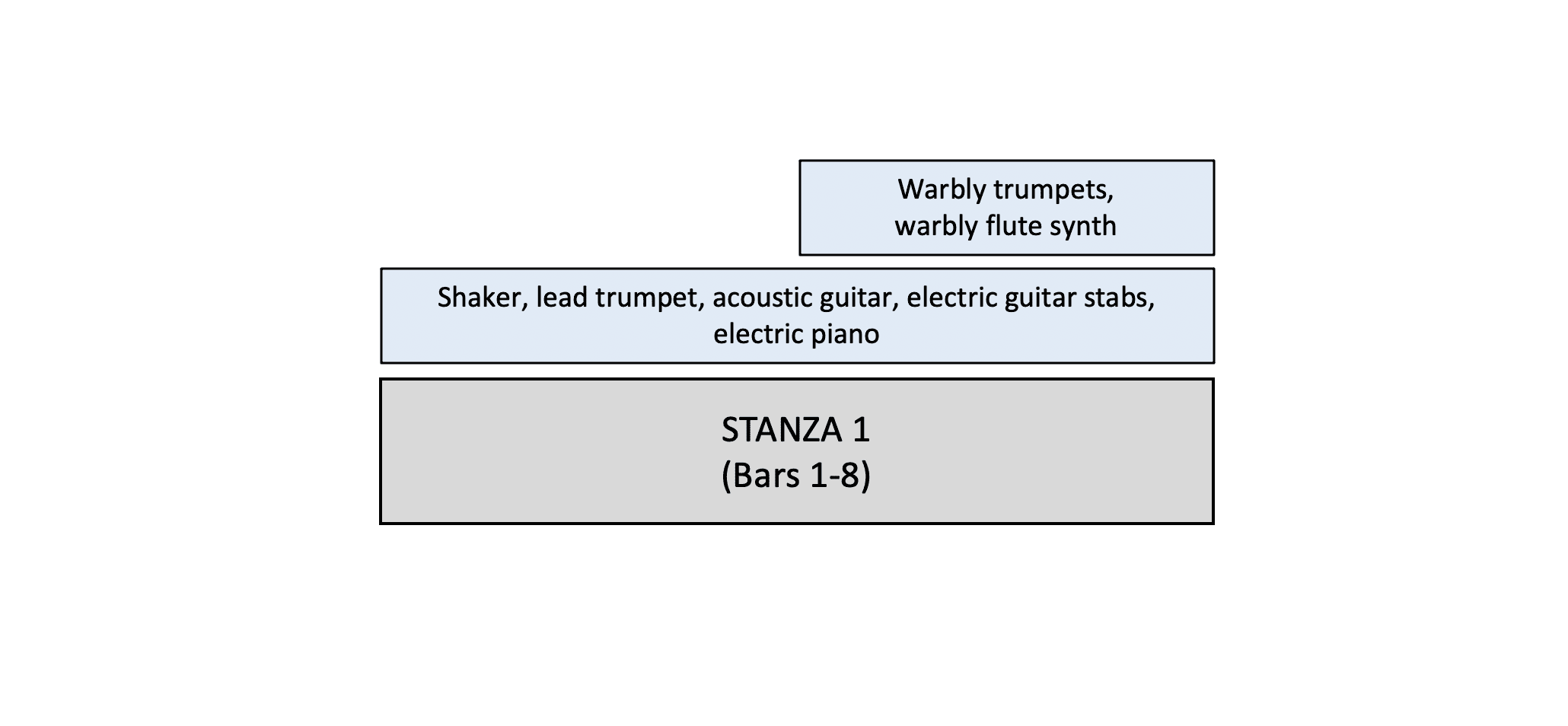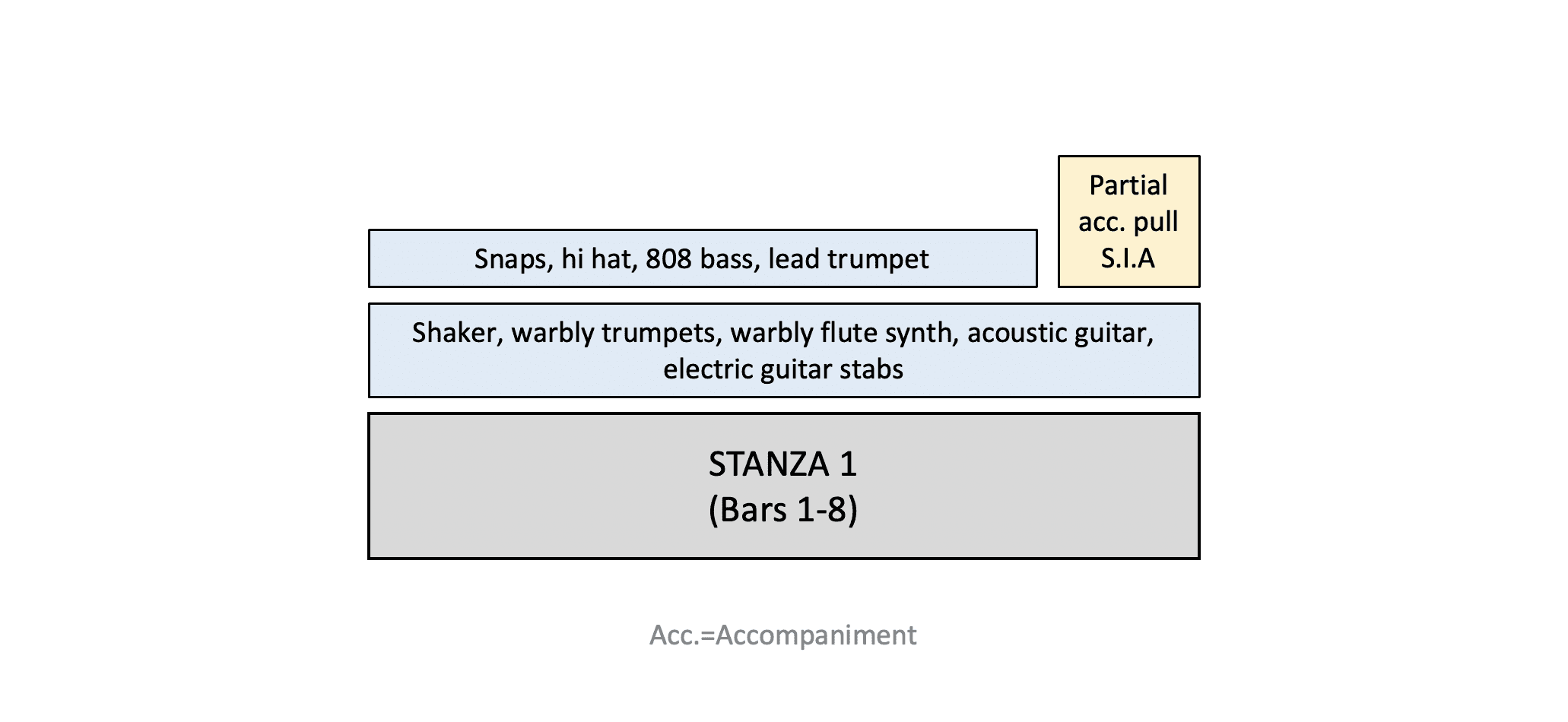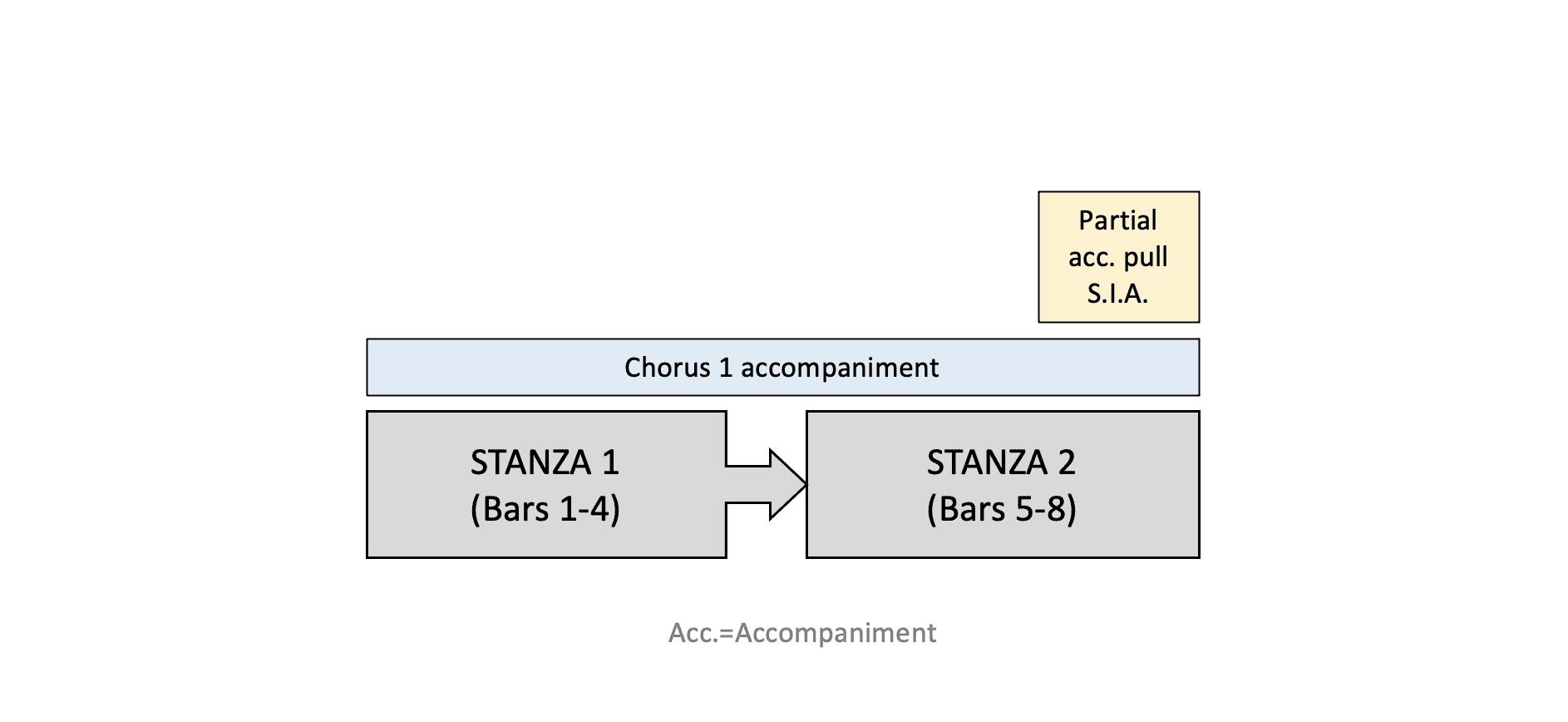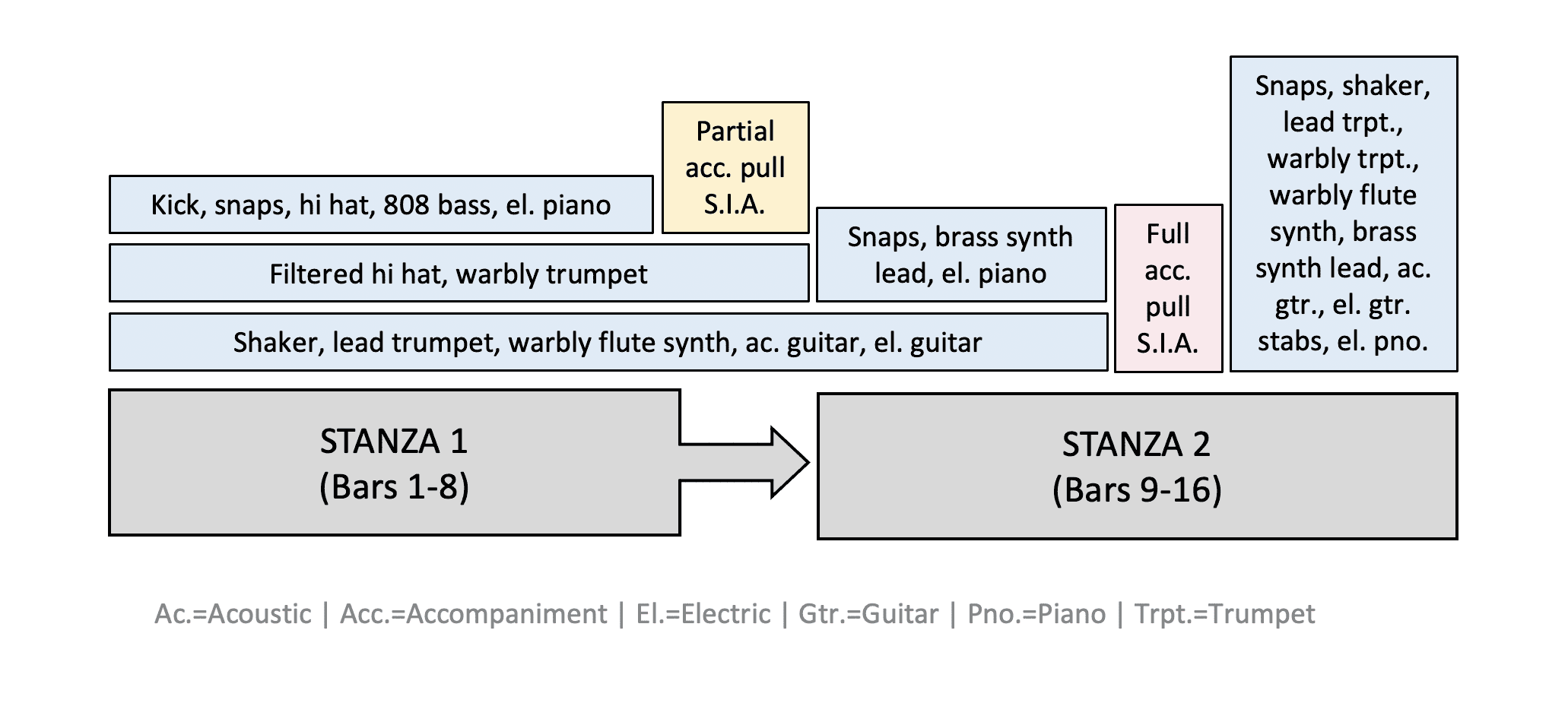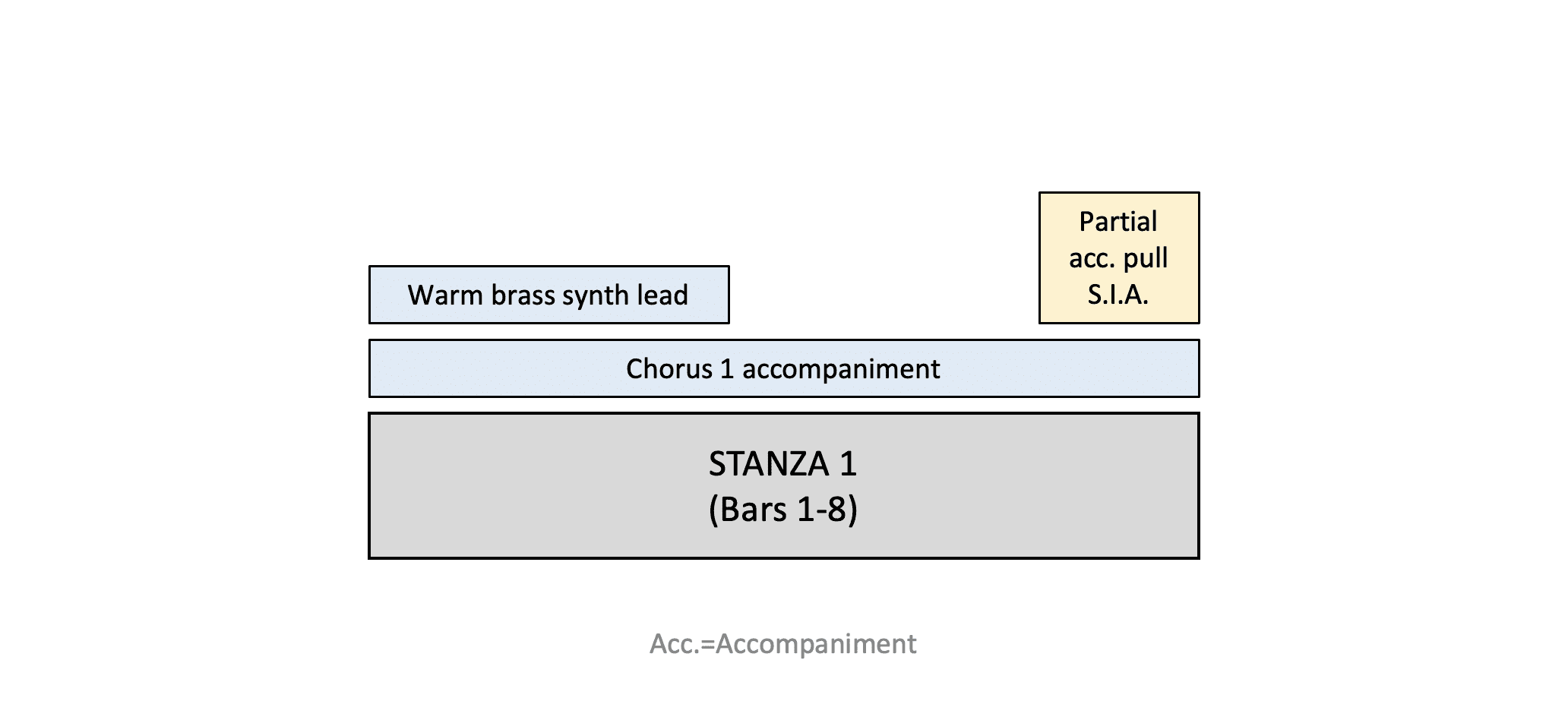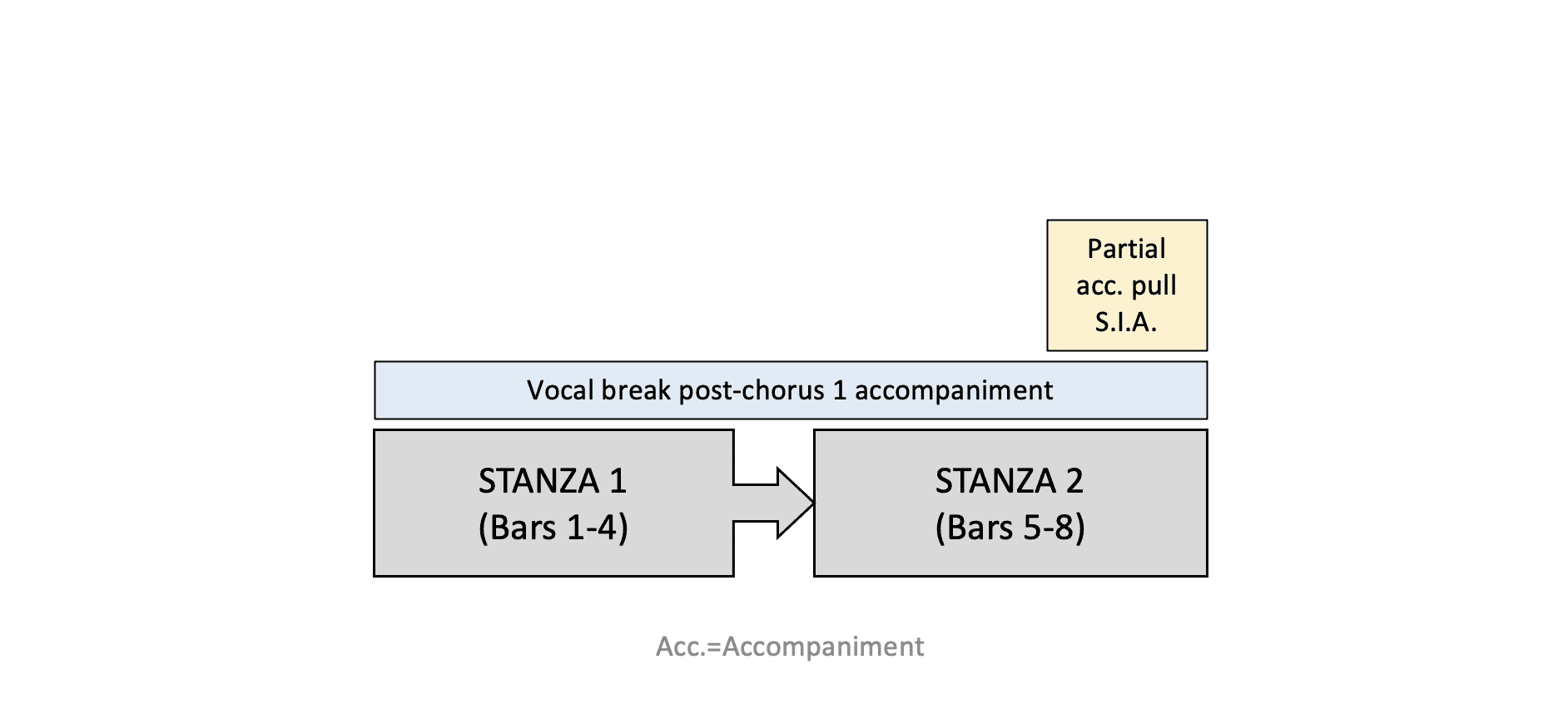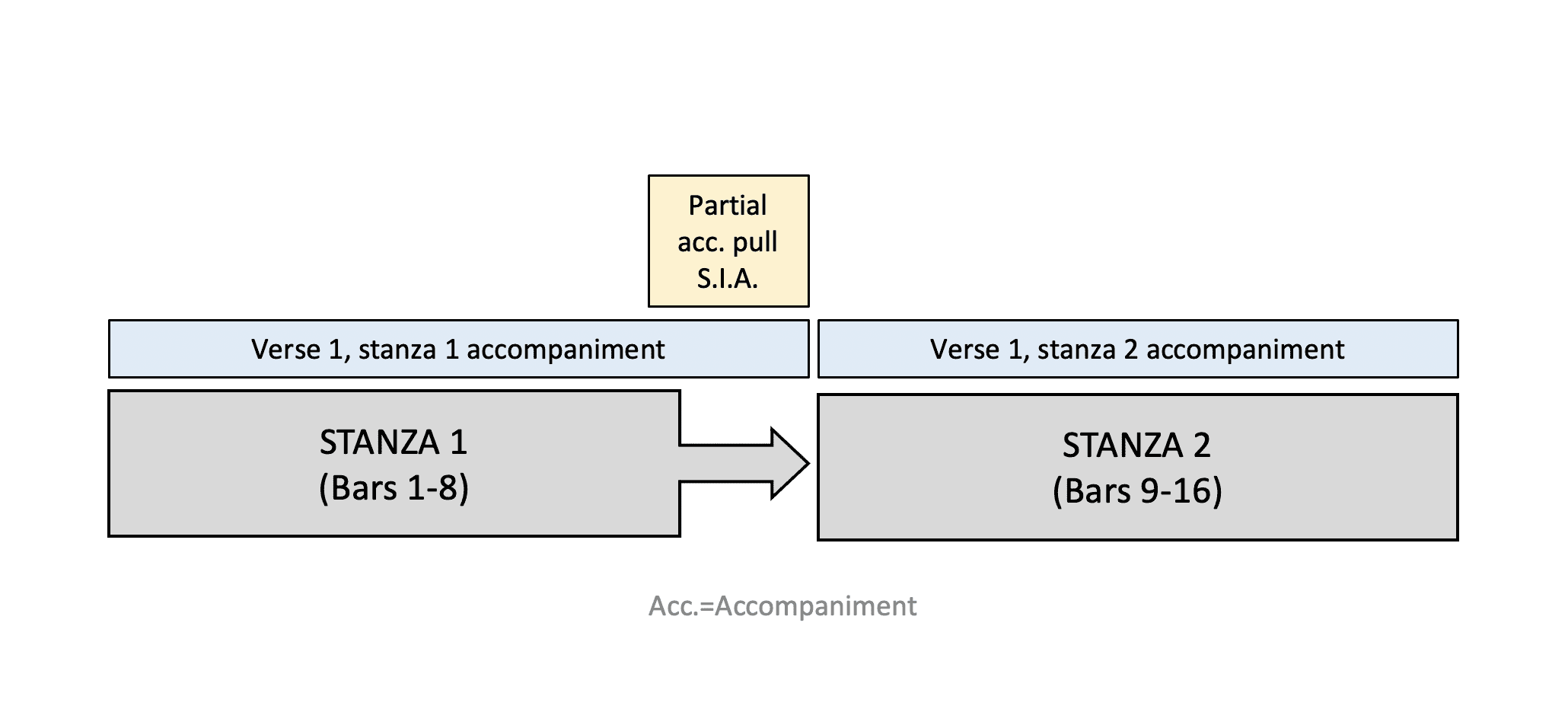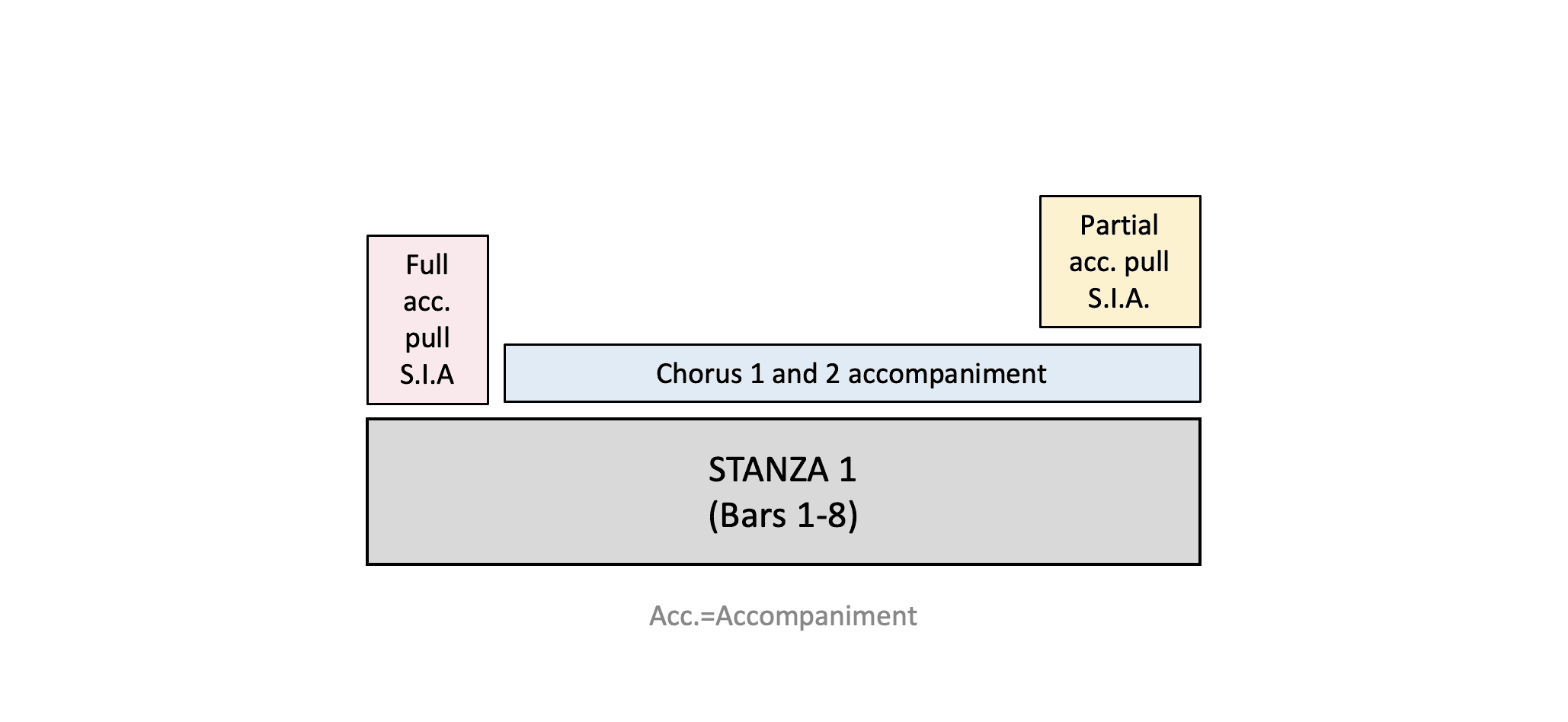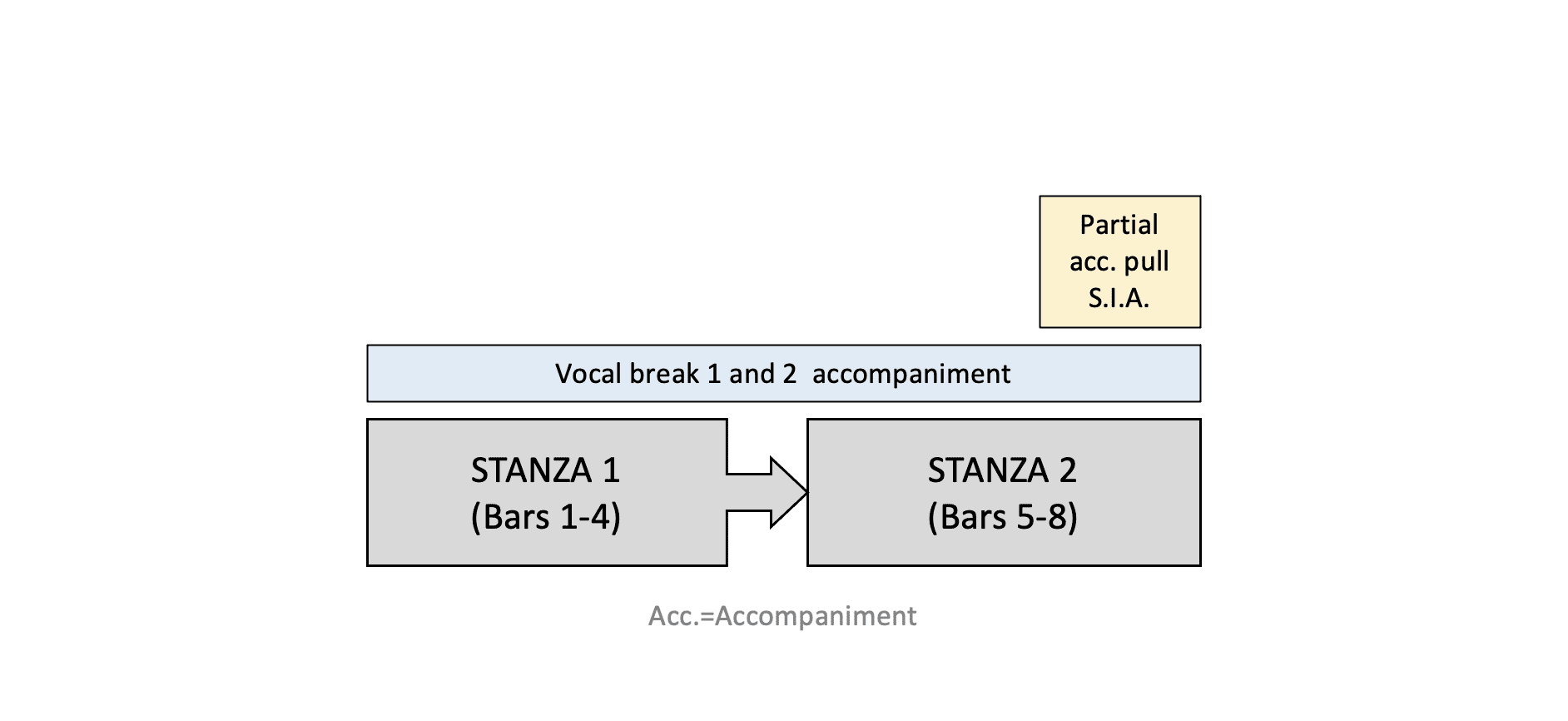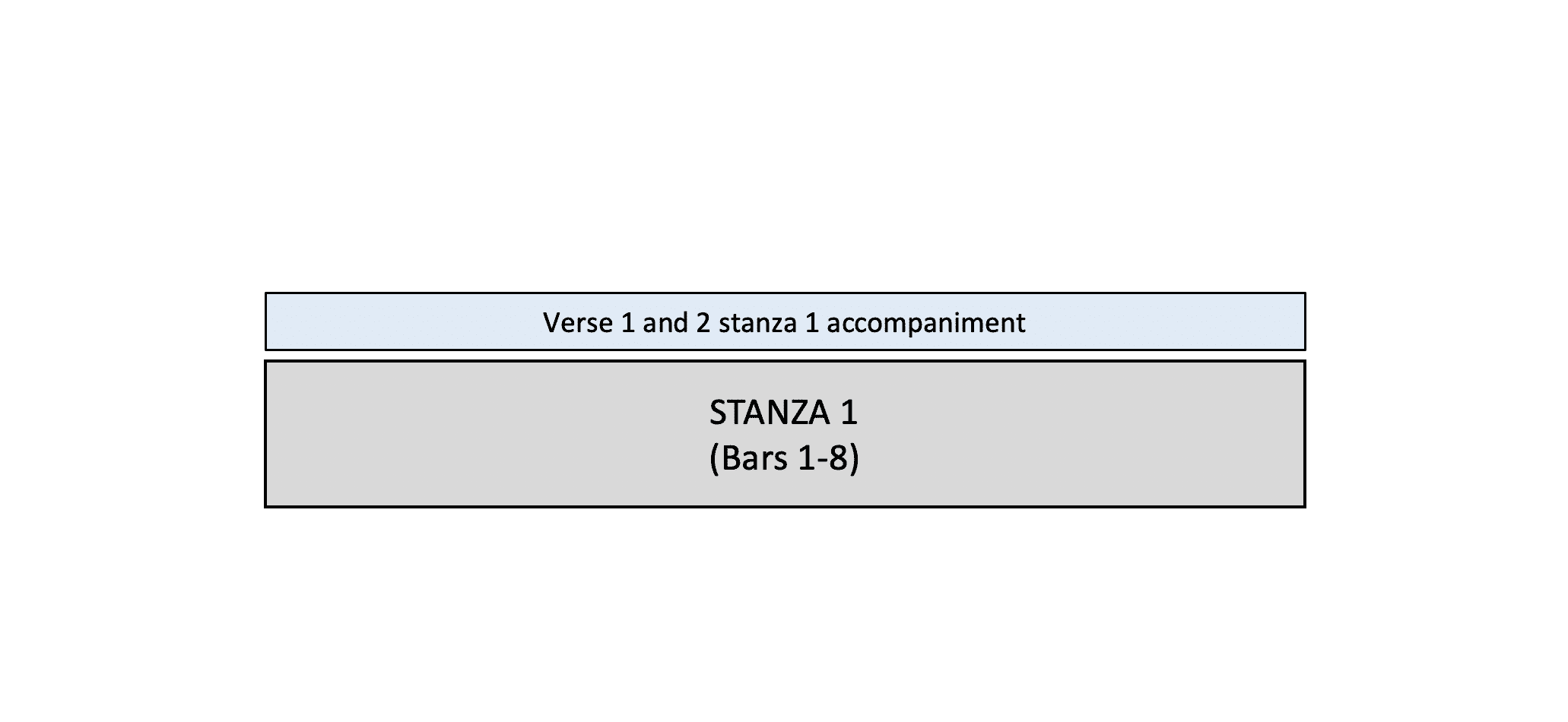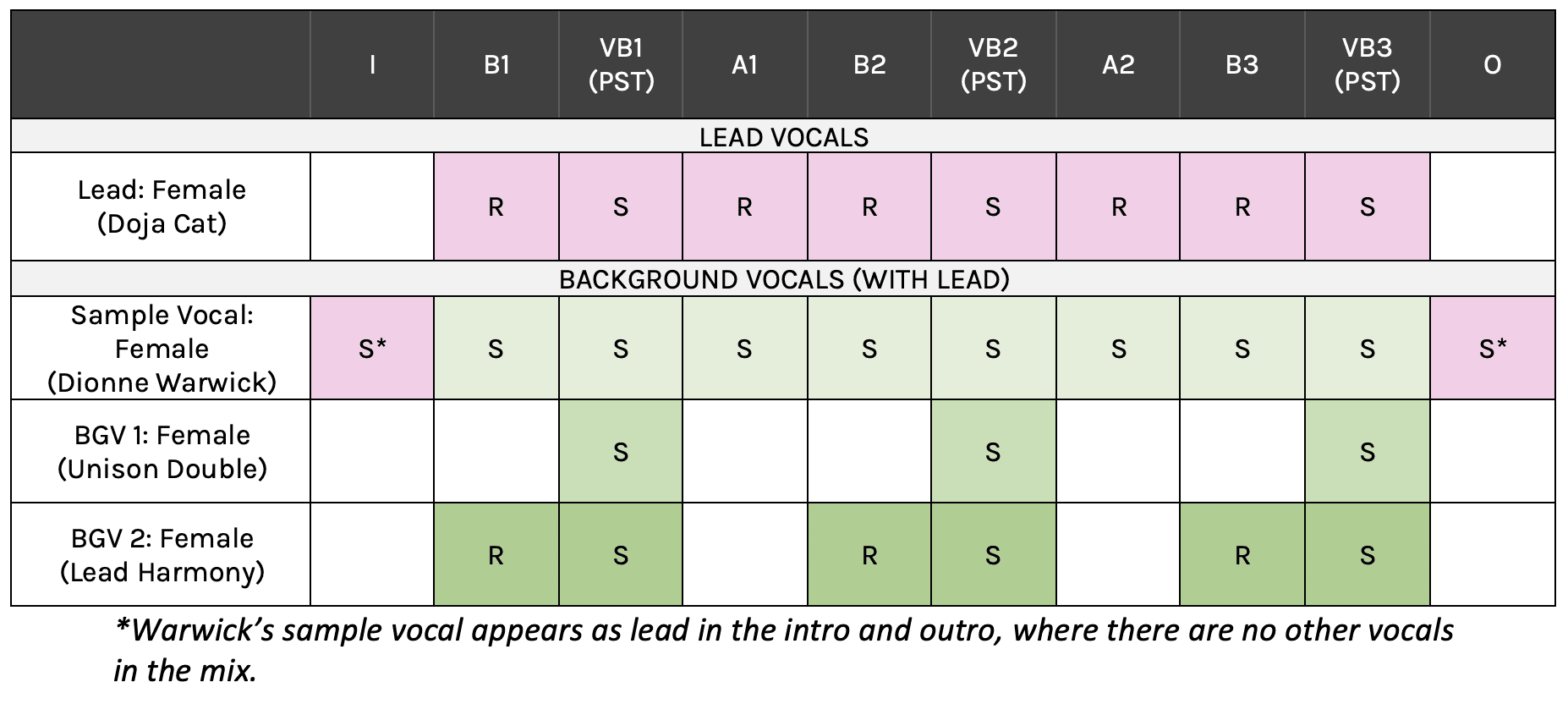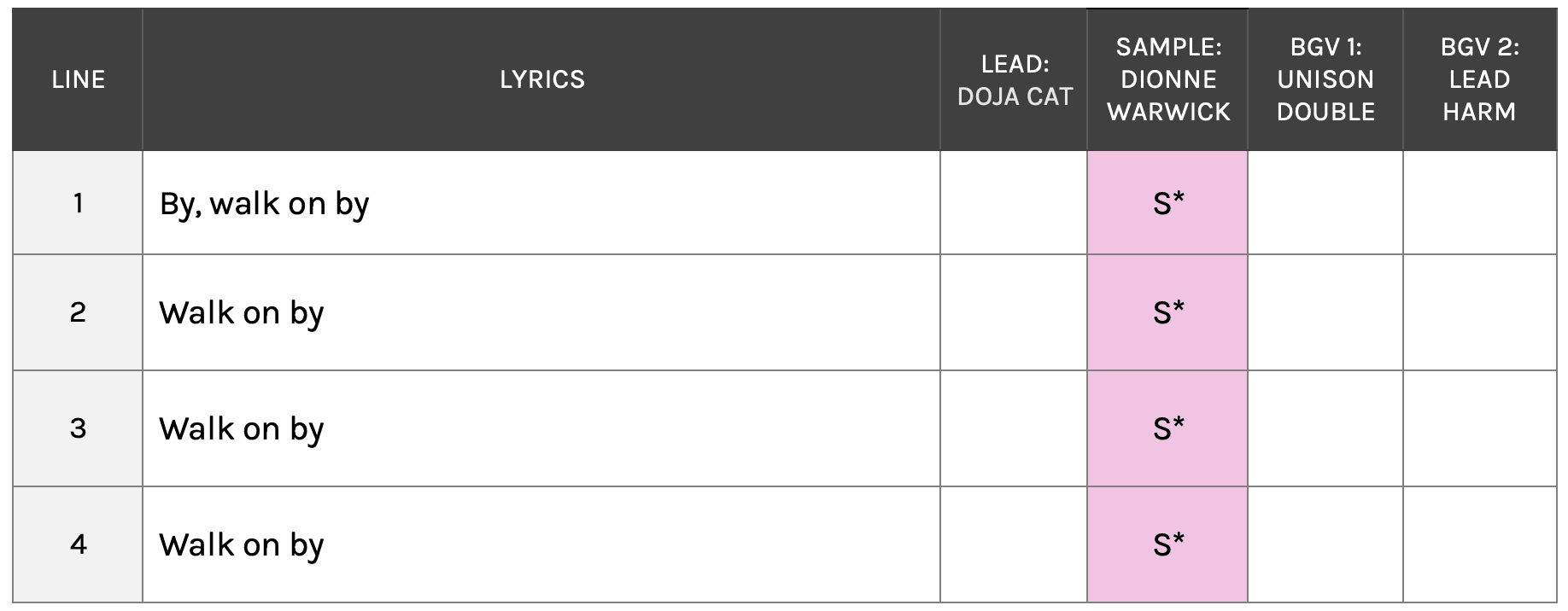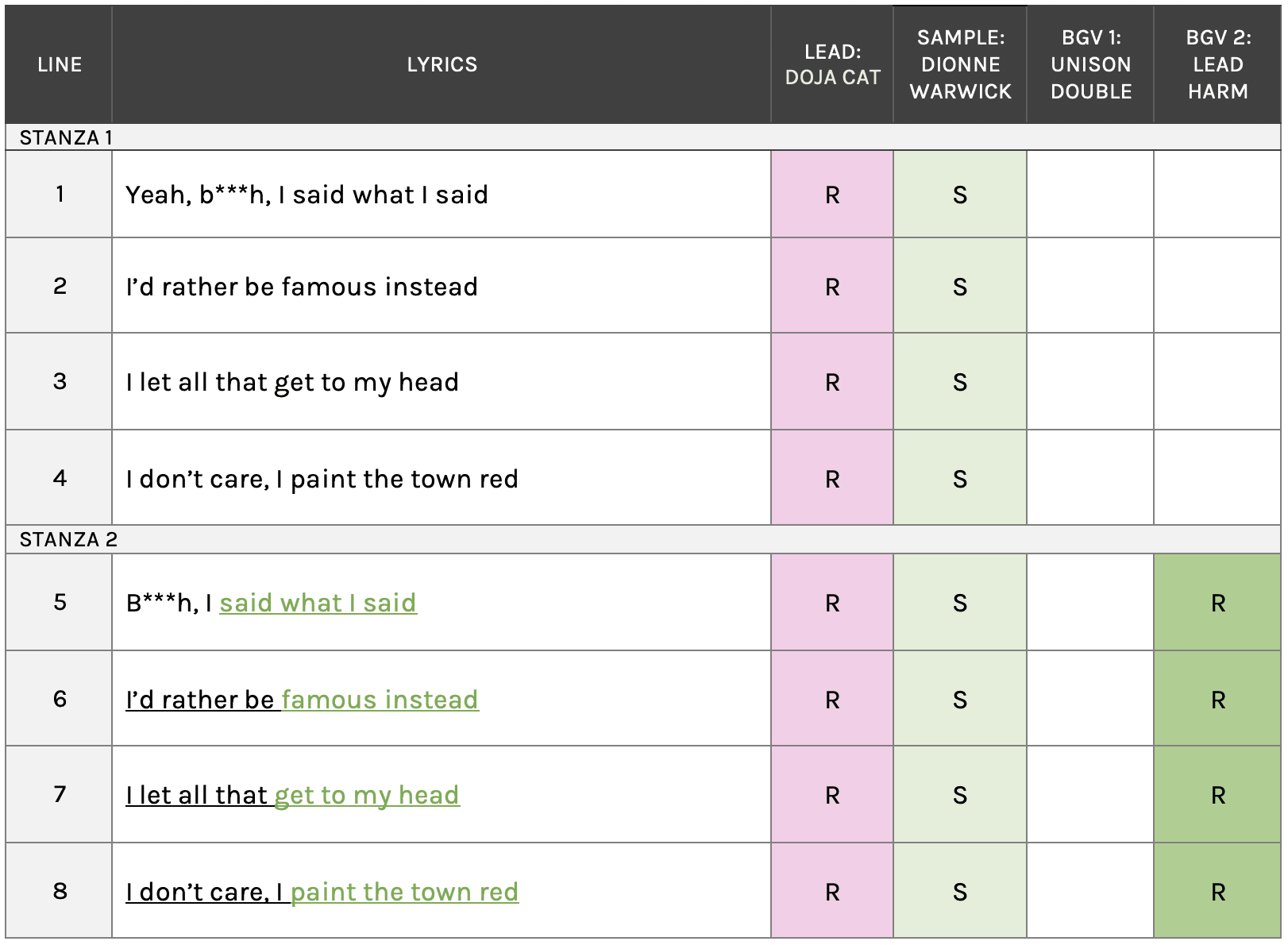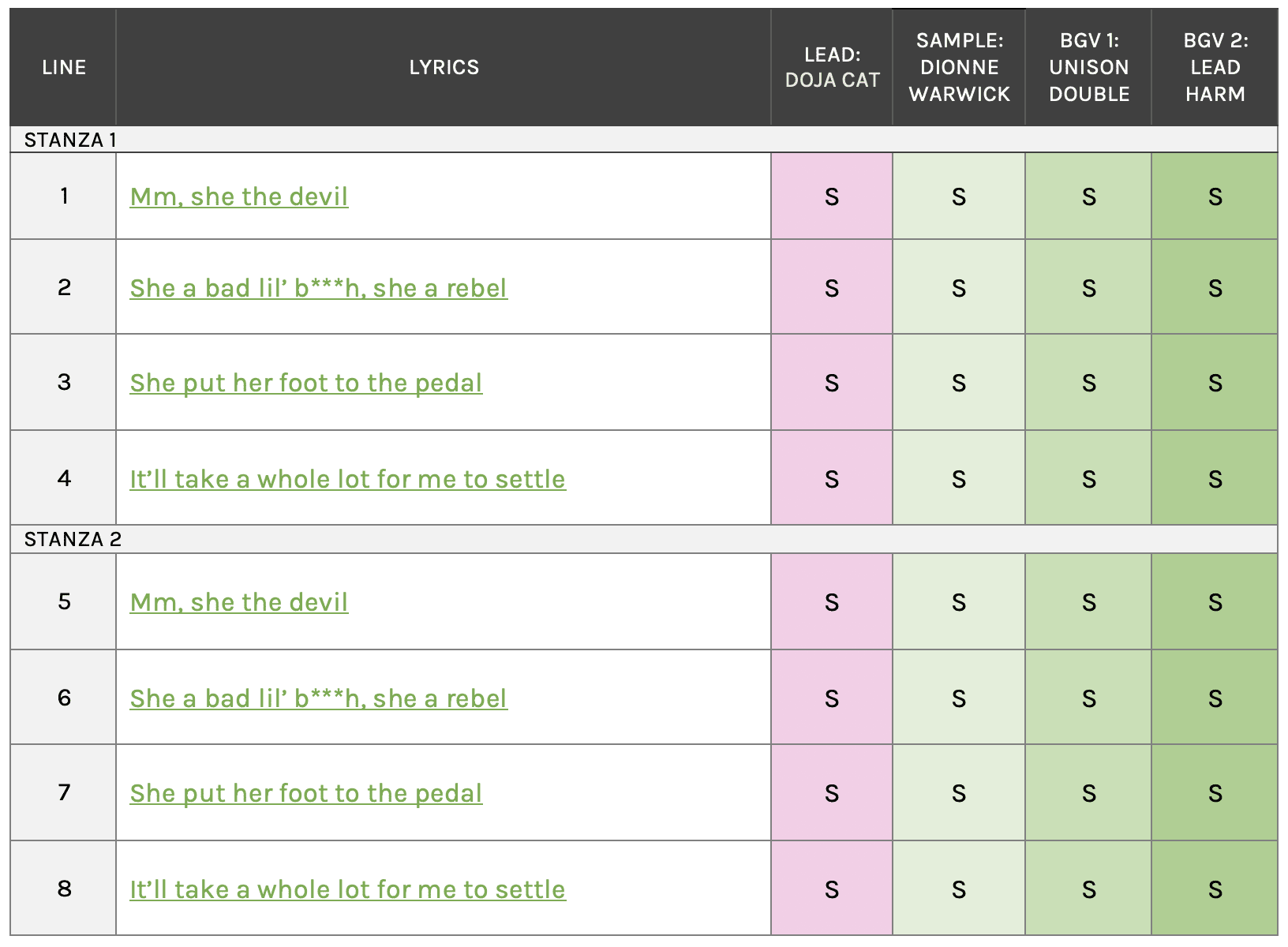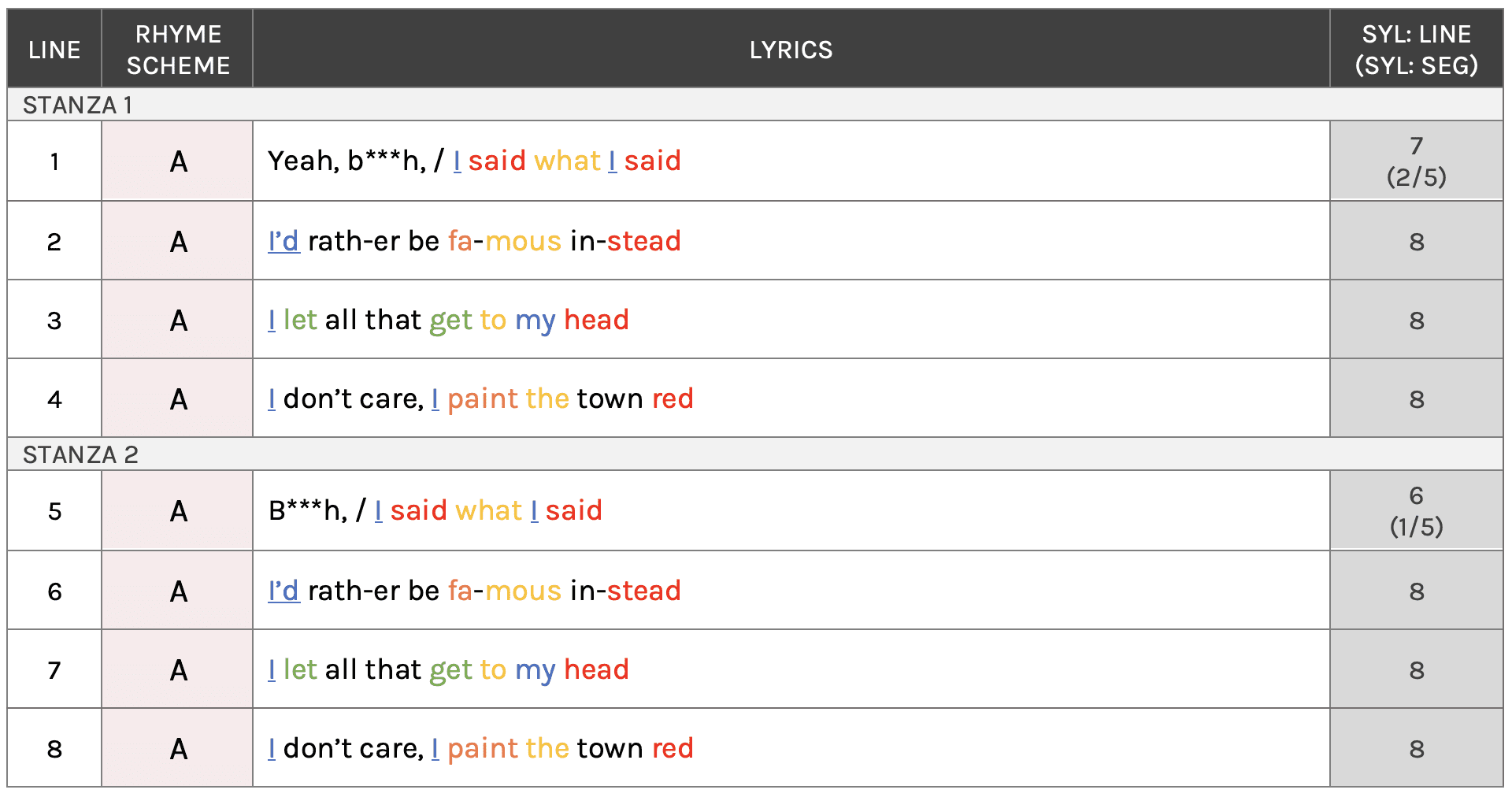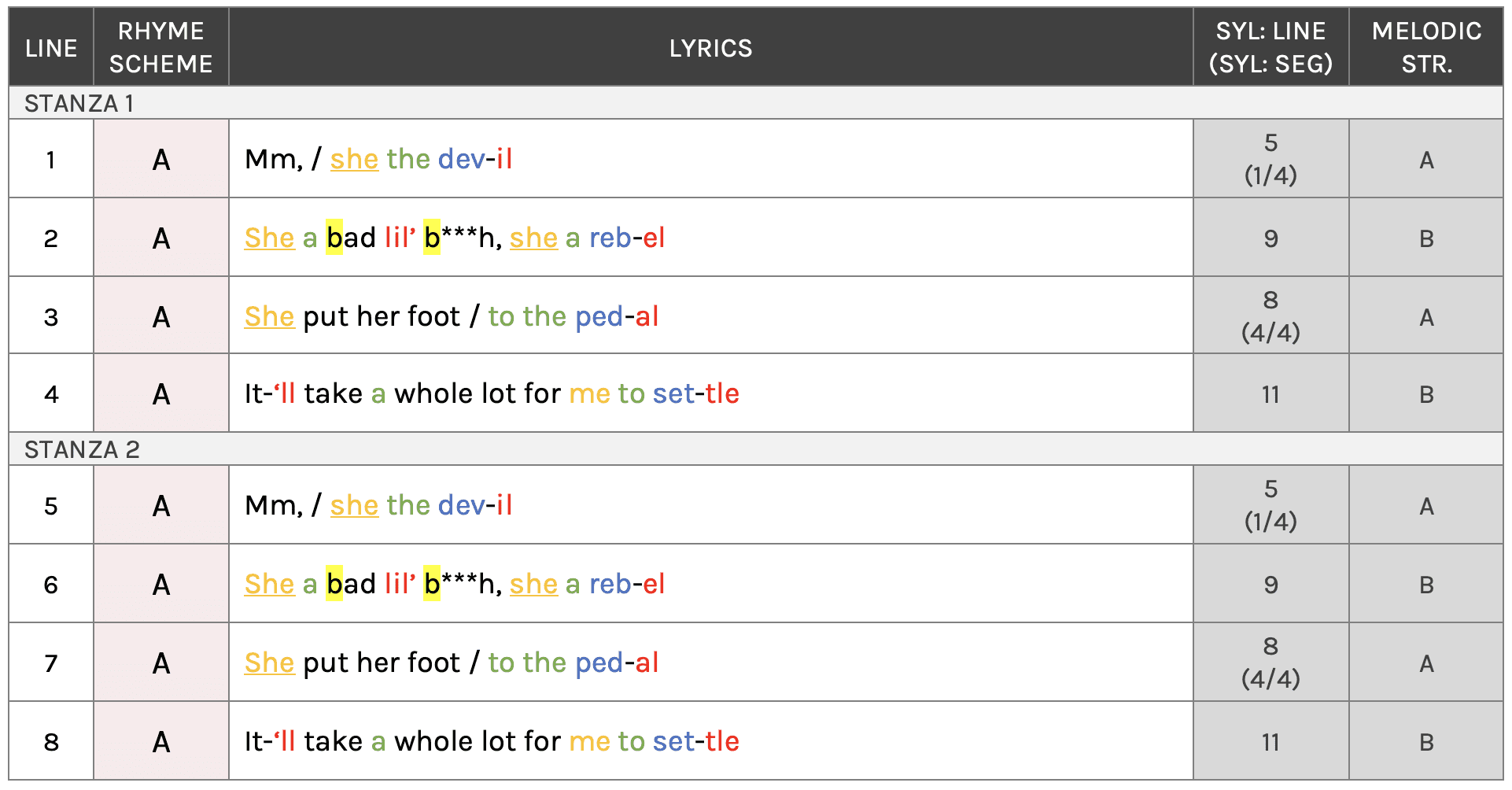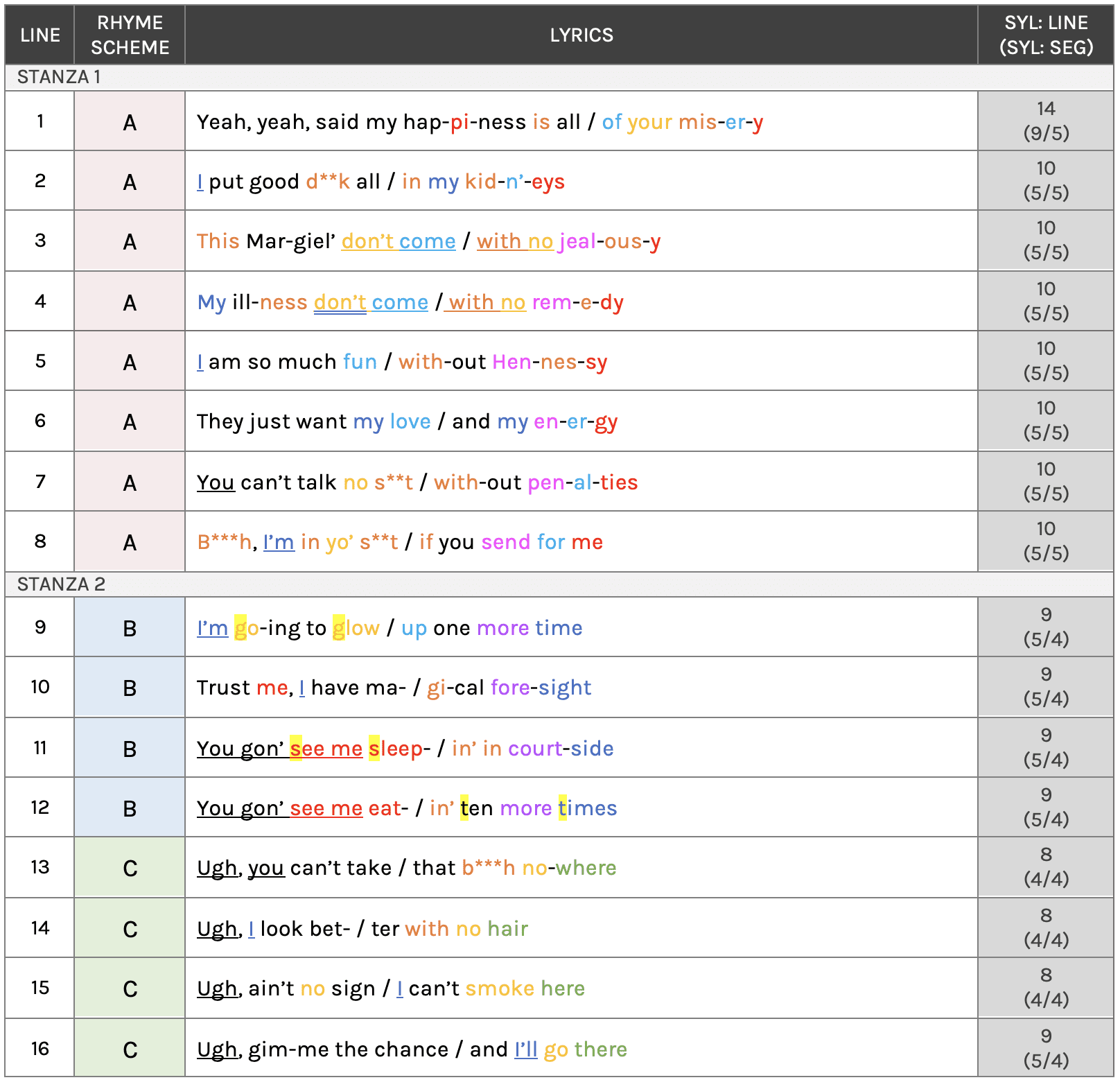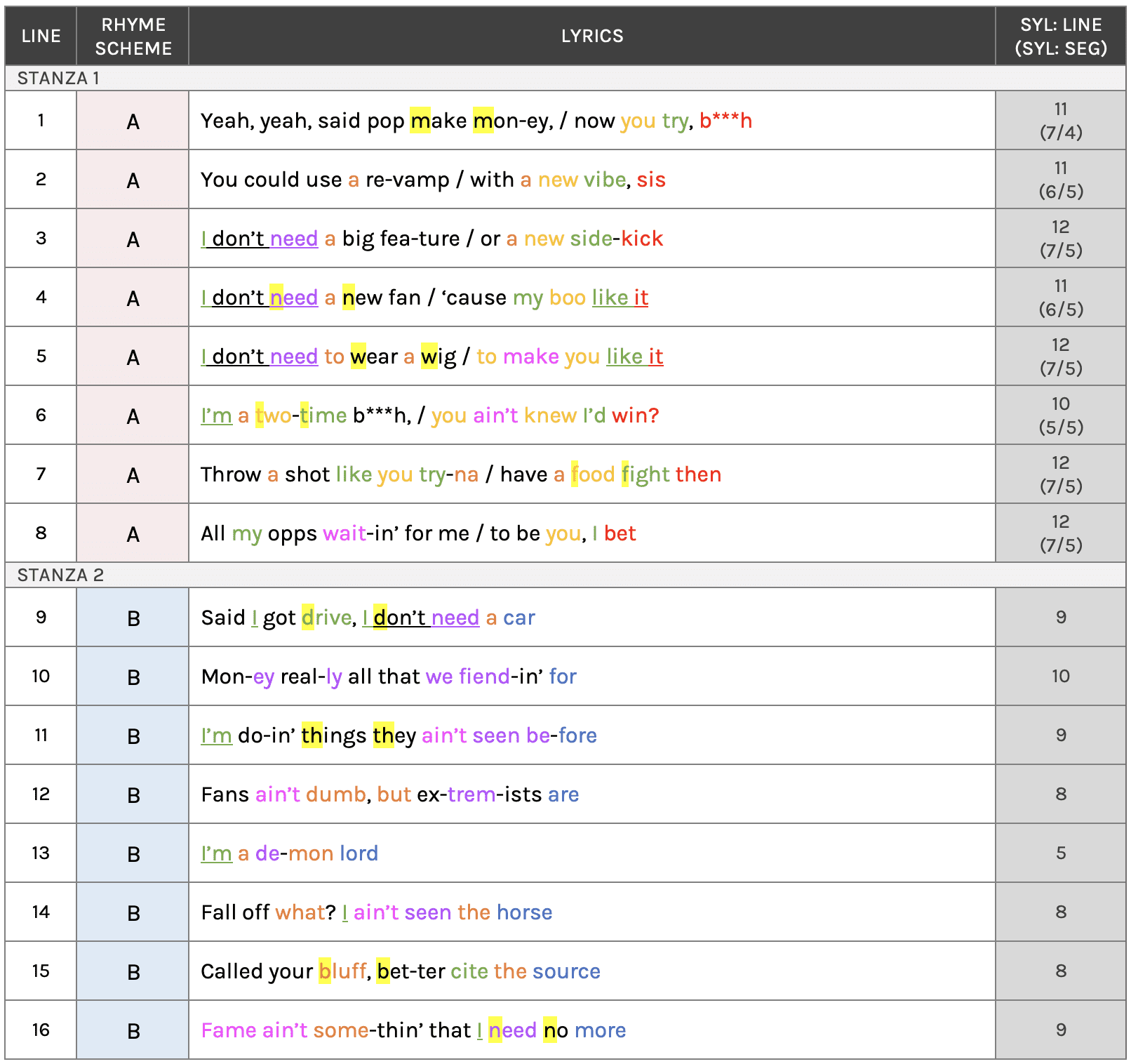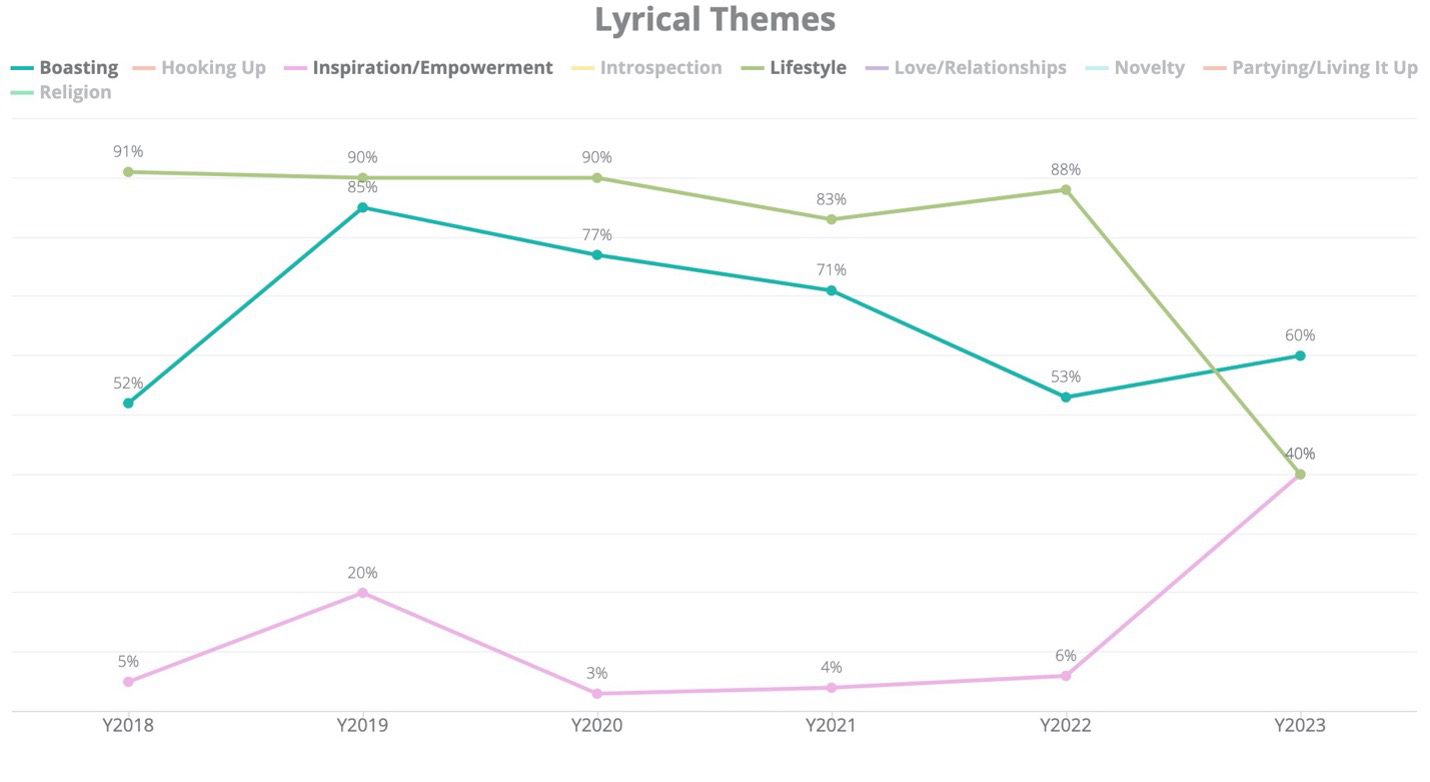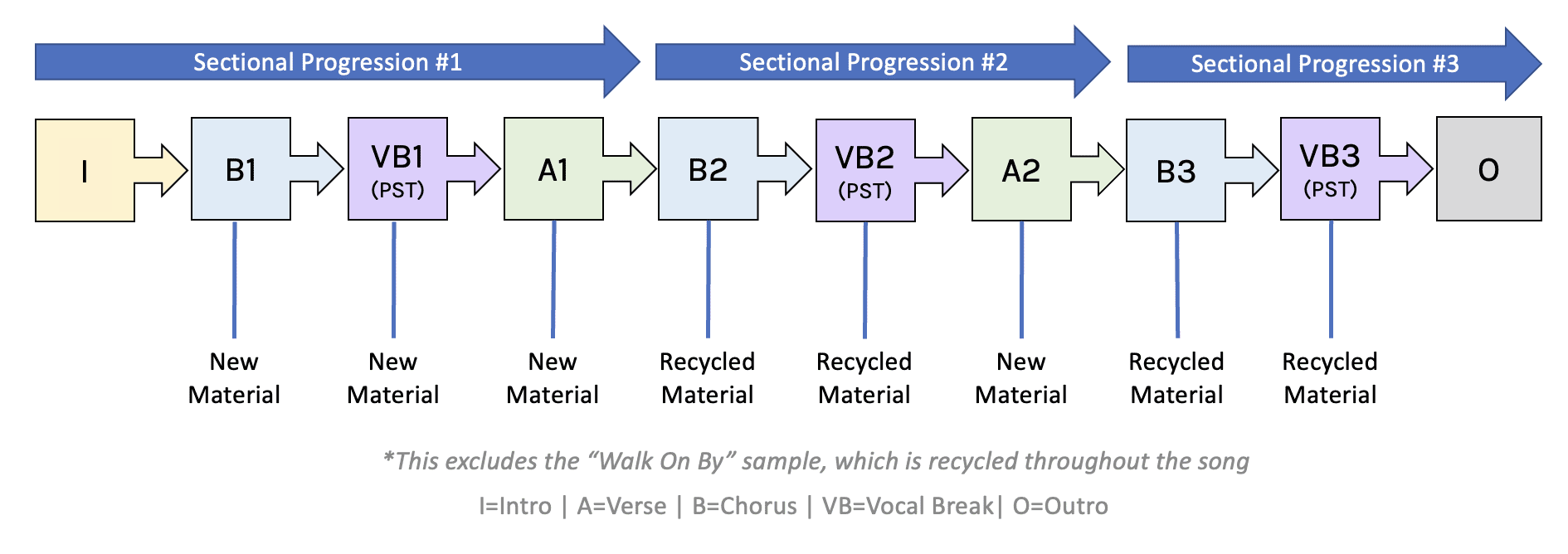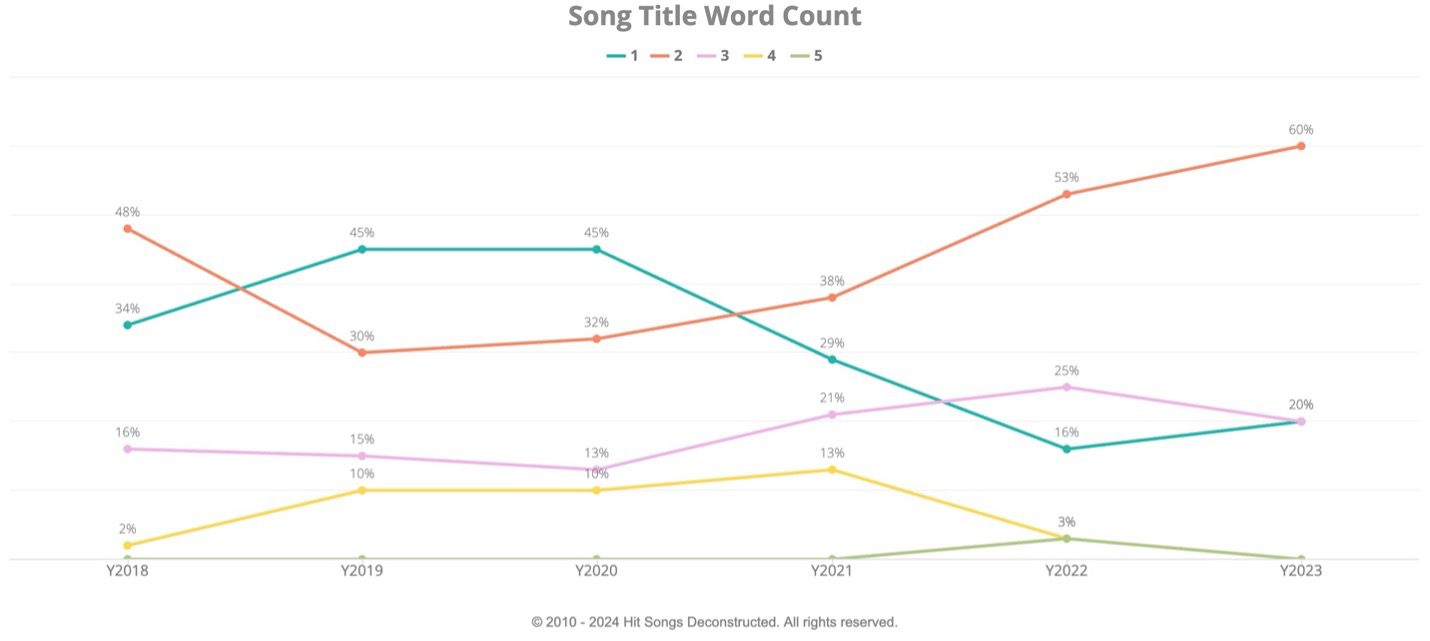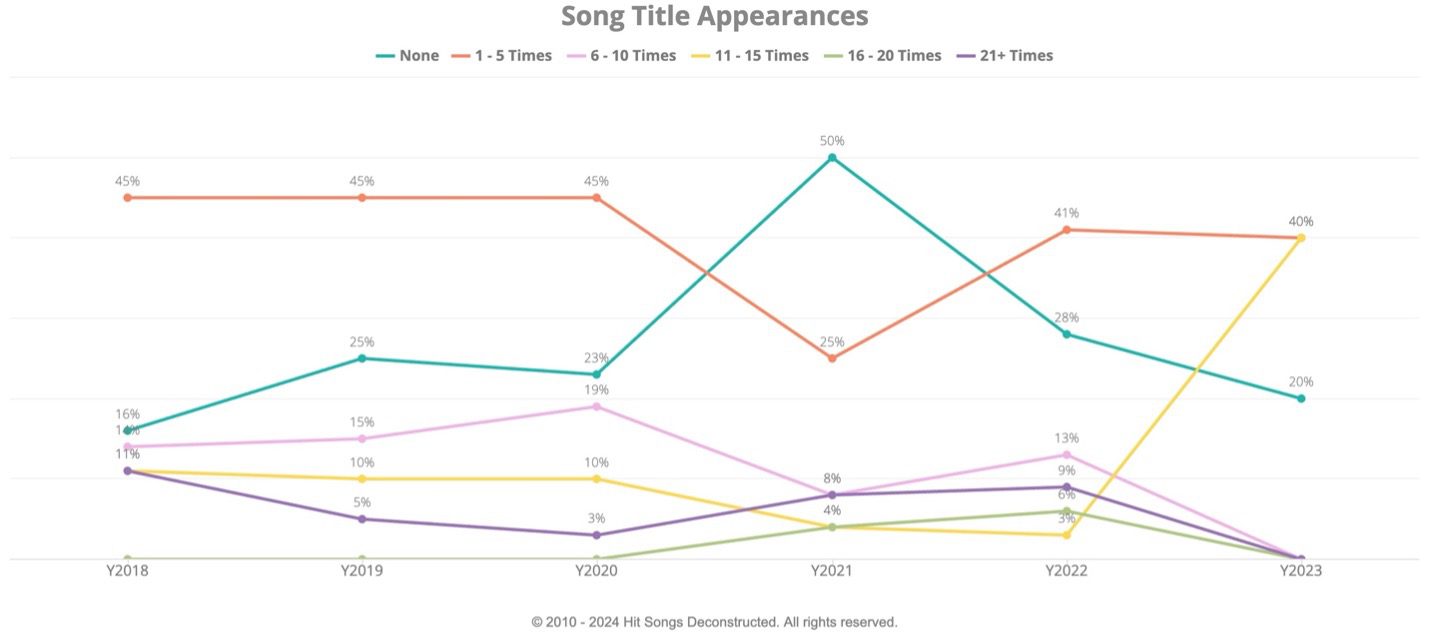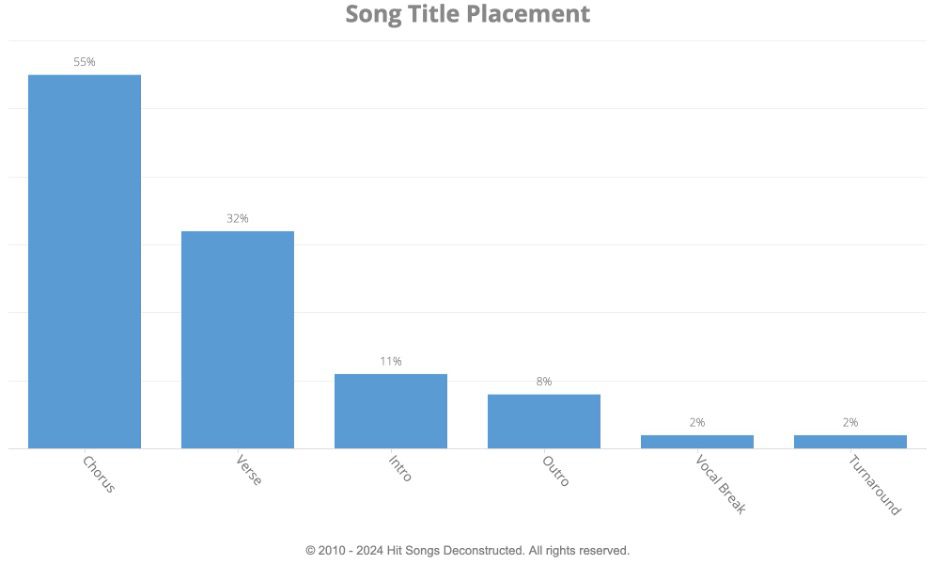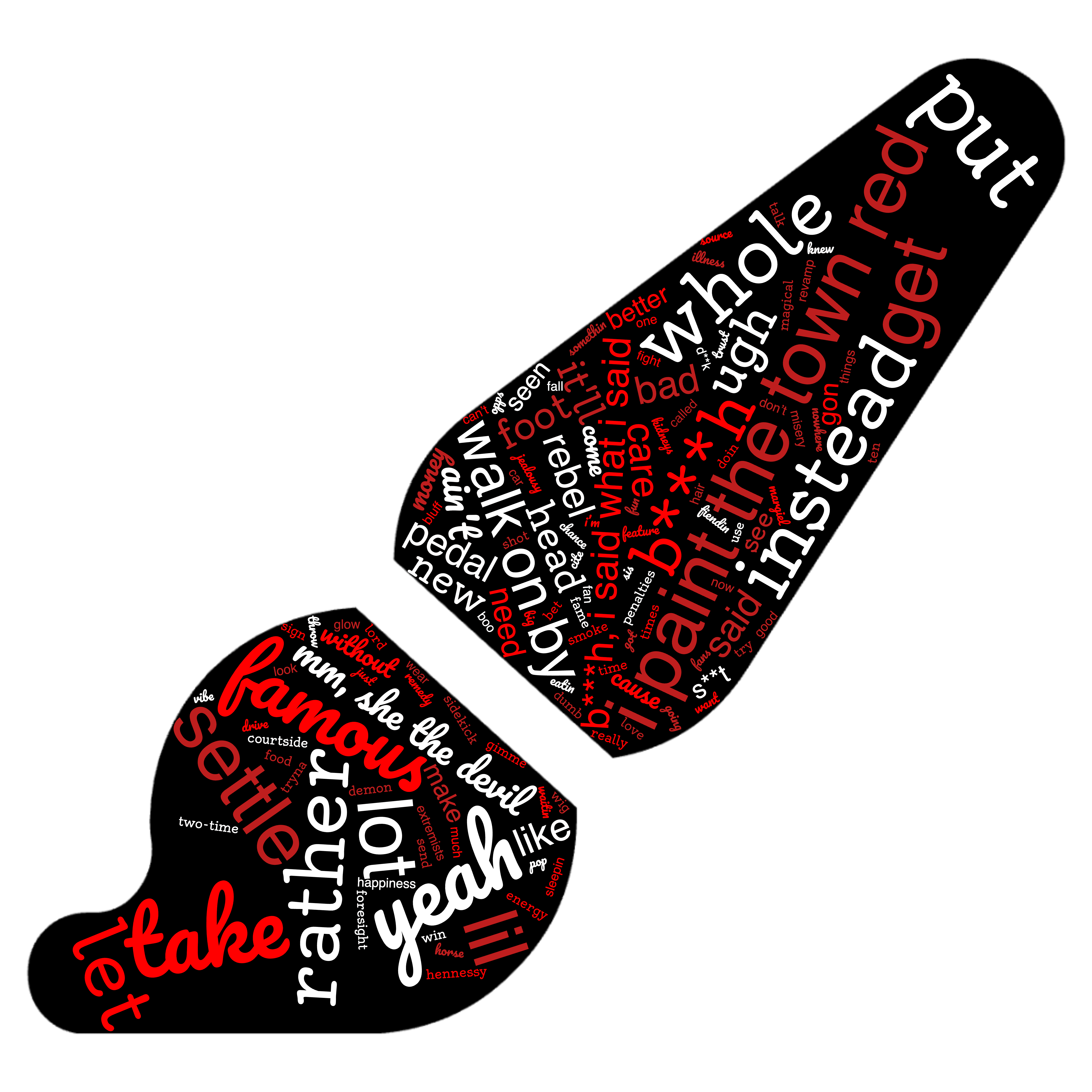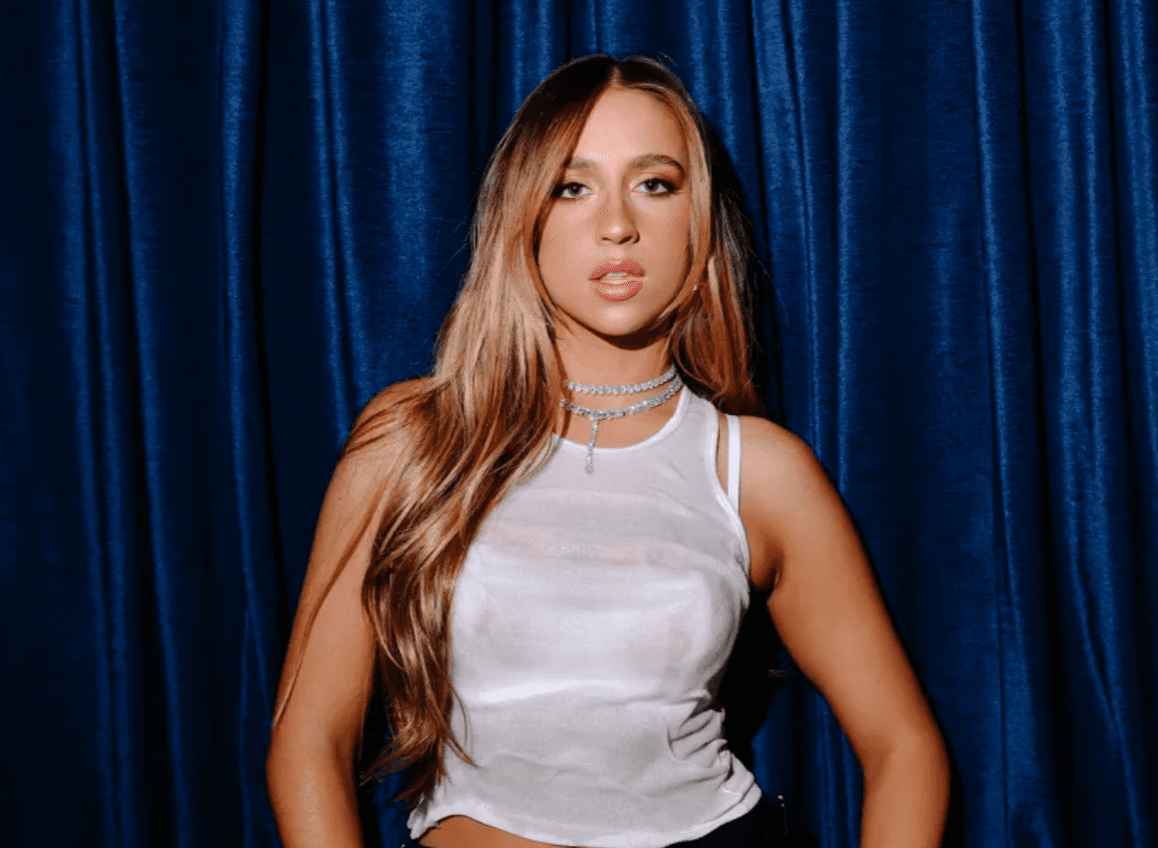

Tate McRae
This powerhouse lineup of writers alongside producers Grant Boutin, Harris, and Tedder, meticulously crafted "greedy" into a song poised for global acclaim. Noteworthy qualities include its irresistibly catchy melodies, expertly arranged vocal and instrumental hooks, and McRae's emotive delivery, breathing life into relatable themes of love, relationships, and self-empowerment. Also notable is the delicate balance between familiarity and uniqueness, allowing “greedy” to resonate widely with audiences while carving out its own distinct identity.
Since its release, "greedy" has surged into the top 10 on over 50 charts worldwide, claiming the number one position on more than 20, including the Billboard Mainstream Top 40 and Adult Top 40 charts in the United States.
At-A-Glance
Artist: Tate McRae
Song: "greedy”
Songwriters: Amy Allen, Jasper Harris, Ryan Tedder, Tate McRae
Producers: Grant Boutin, Jasper Harris, Ryan Tedder
Mastering Engineer: Dave Kutch
Mixer: Manny Marroquin
Record Label: RCA
Primary Genre: Pop
Influences: Alt/Indie, Dance/Club, Electropop/Synthpop, Pop, R&B/Soul
Length: 2:09
Form: I-A-B-T-A-B-A-B-O
Key: F# minor
Tempo: 111 BPM
First Chorus: 0:21 / 16% of the way into the song
Intro Length: 0:04
Electronic vs. Acoustic Instrumentation: Electronic/Acoustic Combo
Prominent Instruments: Bass (Synth), Drums/Perc (Acoustic/Electronic Combo), Handpan percussion, Synth (Non-Bass)
Primary Lyrical Theme: Inspiration/Empowerment, Love/Relationships, Love/Relationships (Romantic/Being In Love/Seeking Love)
Title Appearances: "greedy" appears three times in the song
Song Structure
Song Sections
“greedy” contains nine sections within its framework:
- One intro section
- Three verse sections (one functions as a bridge surrogate “D” [departure] section)
- Three chorus sections
- One turnaround post-chorus section
- One outro post-chorus section
Song Section Classifications
“D” (Departure) Section Classification
In lieu of a far more common bridge, “greedy’s” “D” section is its third verse, appearing between choruses 2 and 3, right where one would expect to find it. While it shares melodic commonalities with the other verses, it features a notable changeup in instrumental arrangement and provides additional narrative development. This was a clever, albeit atypical way, to bolster the song’s memorability factor while simultaneously heightening interest on a lyrical, arrangement and energy level, along with setting up the final chorus for maximum perceived impact.
While the use of a “D” section has been highly common among non-hip hop hits over the past five years (despite a notable decrease in the first three quarters of 2023), verse bridge surrogates have been few and far between, comprising only 10% of “D” sections. Other recent hits that have utilized a verse “D” section include “Boy’s a Liar, Pt. 2,” “Bad Decisions” and “Seven.”
Use of a “D” Section in Non-Hip Hop Hot 100 Top 10 Hits: 2018 – Q3 2023
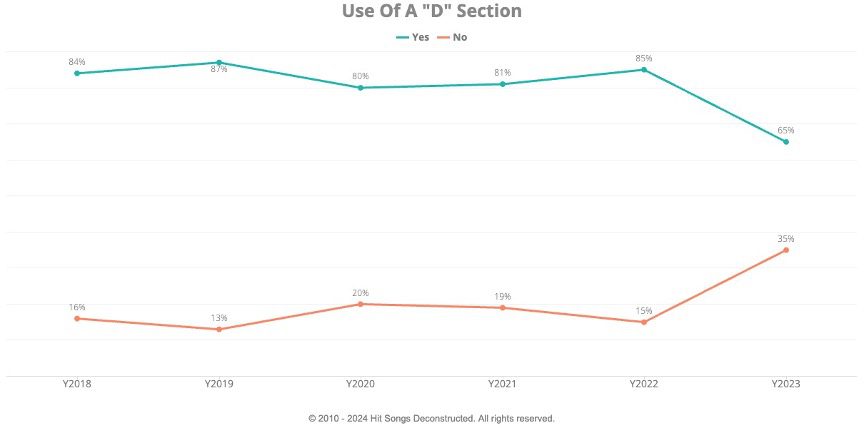

Post-Chorus Section Classification
“greedy’s” post-choruses are the turnaround following the first chorus and the outro following chorus 3. Both feature a nonsense vocal that cleverly reinforces the handpan percussion hook melody, while the outro also includes the “I would want myself” standout statement hook from the preceding chorus.
Post-chorus popularity among non-hip hop Hot 100 top 10 hits has varied over the past five years, from a low of 35% of songs in 2018 up to 65% in the first three quarters of 2023, which is the highest it’s been in over a decade. However, while the outro has been the second most common post-chorus section behind the vocal break, the turnaround post-chorus has been far more elusive at just 3% of songs. Among them are other notable hits such as “Anti-Hero,” “Fast Car,” and “Good As Hell.”
Use of a Post-Chorus in Non-Hip Hop Hot 100 Top 10 Hits: 2018 – Q3 2023
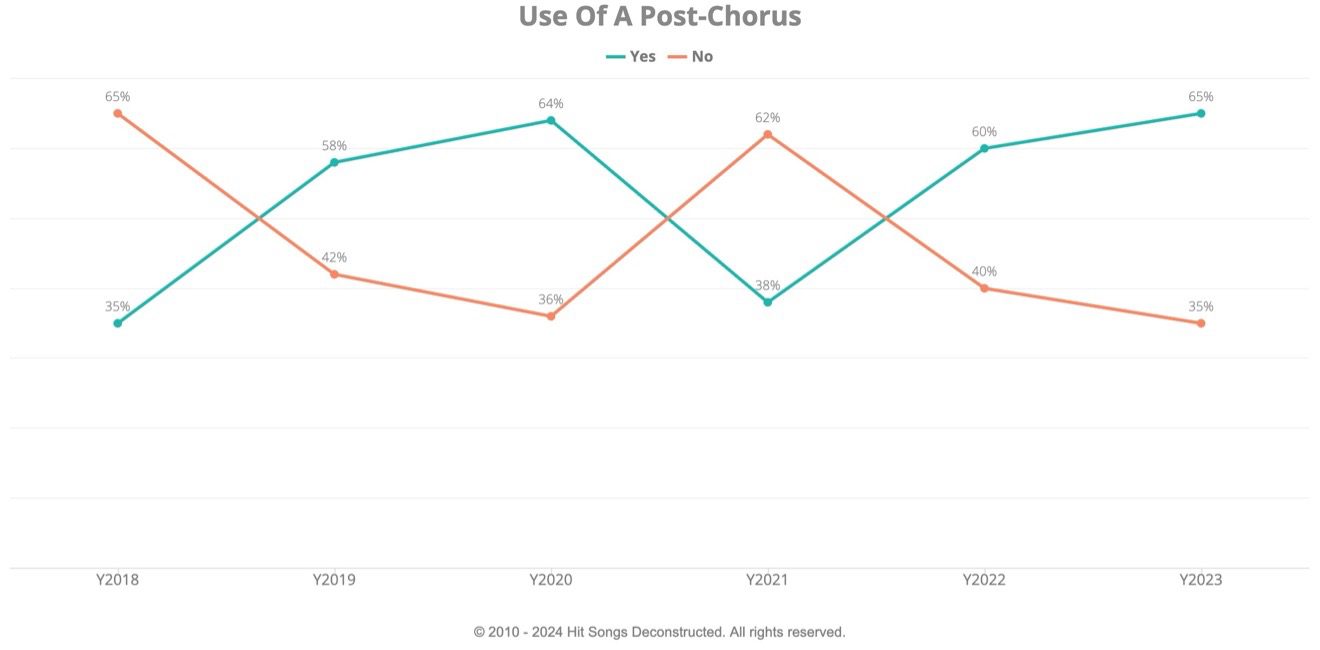

Post-Chorus Sections in Non-Hip Hop Hot 100 Top 10 Hits: 2018 – Q3 2023
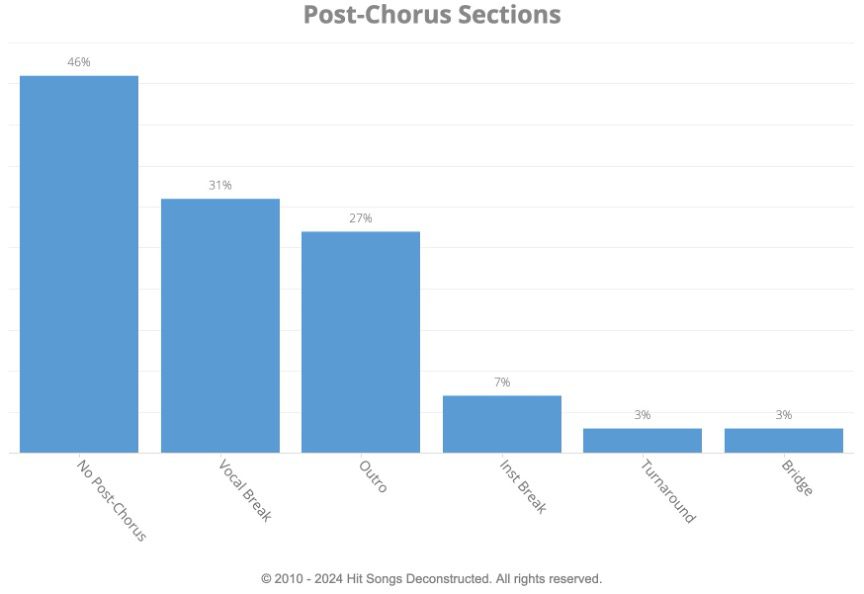

Form
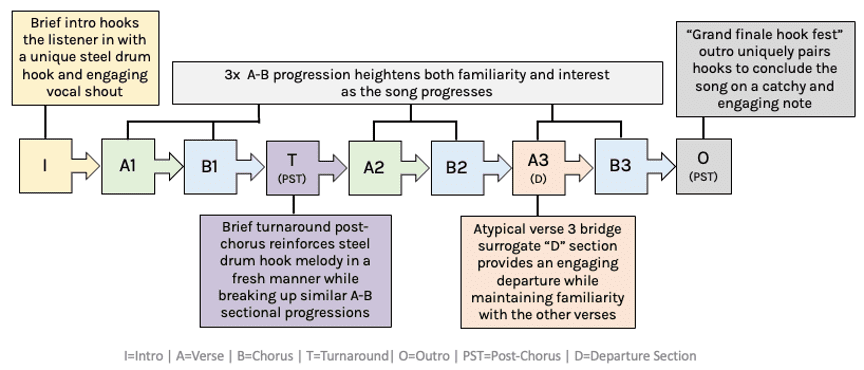

Time and Percent into the Song When Core Sections Occur
“greedy”


Core A-B-A-B-D-B Form in Hot 100 Top 10 Hits (Q4 2022 – Q3 2023)


The percentage into the song when “greedy’s” core sections (verse, chorus and “D” section) occur is slightly to moderately earlier than non-hip hop Hot 100 top 10 averages in the year prior to its release. This is due in part to characteristics that contributed to its short runtime as detailed below.
Song & Section Length
Song Length
“greedy” clocks in at just 2:09, 1:12 shorter than the Hot 100 top 10 average of 3:21 in the year prior to the song’s release. In fact, “greedy” is the second-shortest non-hip hop top 10 during this time period, right behind Lil Uzi Vert’s “Just Wanna Rock” (2:02). This is in-tune with the top 10’s gravitation towards shorter run times, led by the general rising prominence of the under 3:00 song length range.
Contributing to “greedy’s” short run time are its vibrant 111 BPM tempo, shorter than average section lengths (see below for details), and compact nine section framework, due in part to its exclusion of a pre-chorus and vocal break post-chorus on either end of the first two choruses.
Song Length Ranges of Non-Hip Hop Hot 100 Top 10 Hits: 2018 – Q3 2023
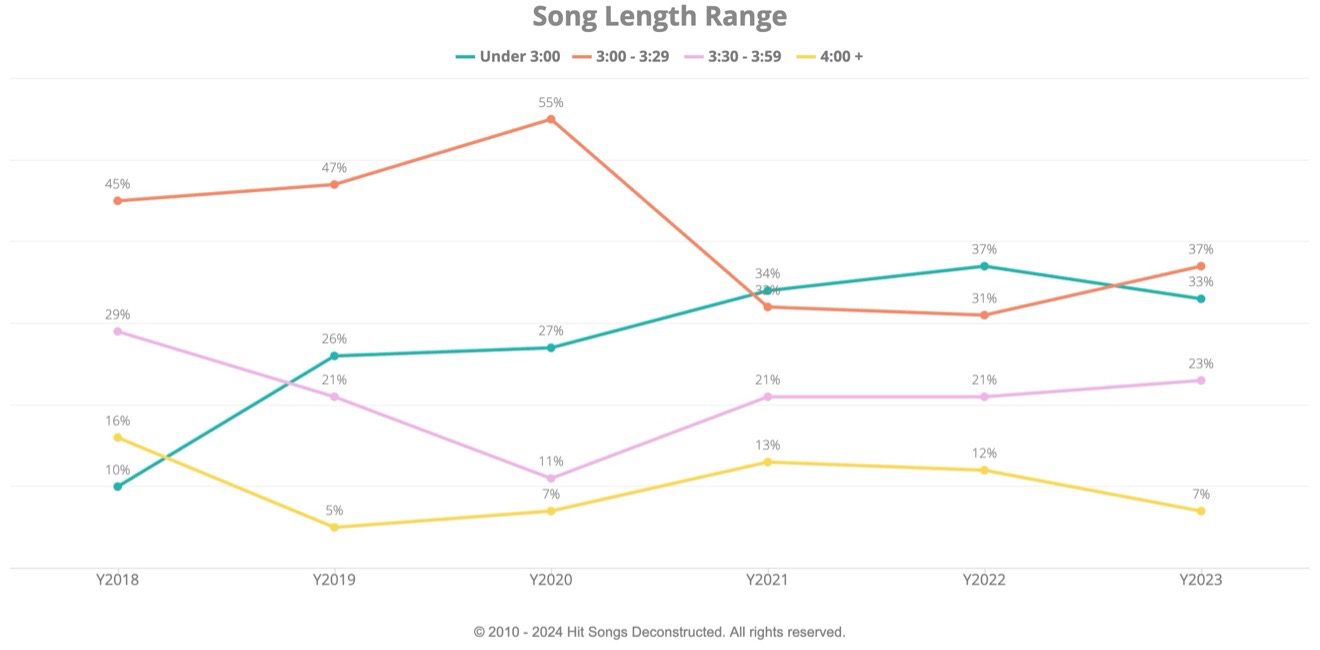

Section Length
“greedy” features relatively uniform section lengths, all landing at 17 seconds save for the slightly longer 19-second outro, the notably shorter 4-second intro, and 2-second turnaround. In terms of bars, this translates to 8, 9, 2, and 1, respectively.
Compared to the average section length of non-hip hop Hot 100 top 10 hits in the year prior to the song’s release, “greedy’s” intro averaged 9 seconds shorter, the verse 10 seconds shorter, the chorus 6 seconds shorter, and the outro 2 seconds shorter.
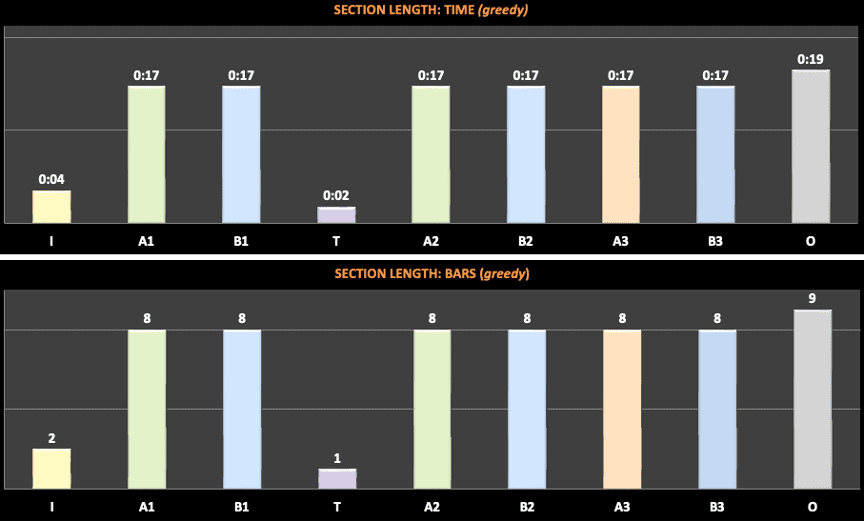

*Note: Section lengths are rounded.
Total Section Breakdown
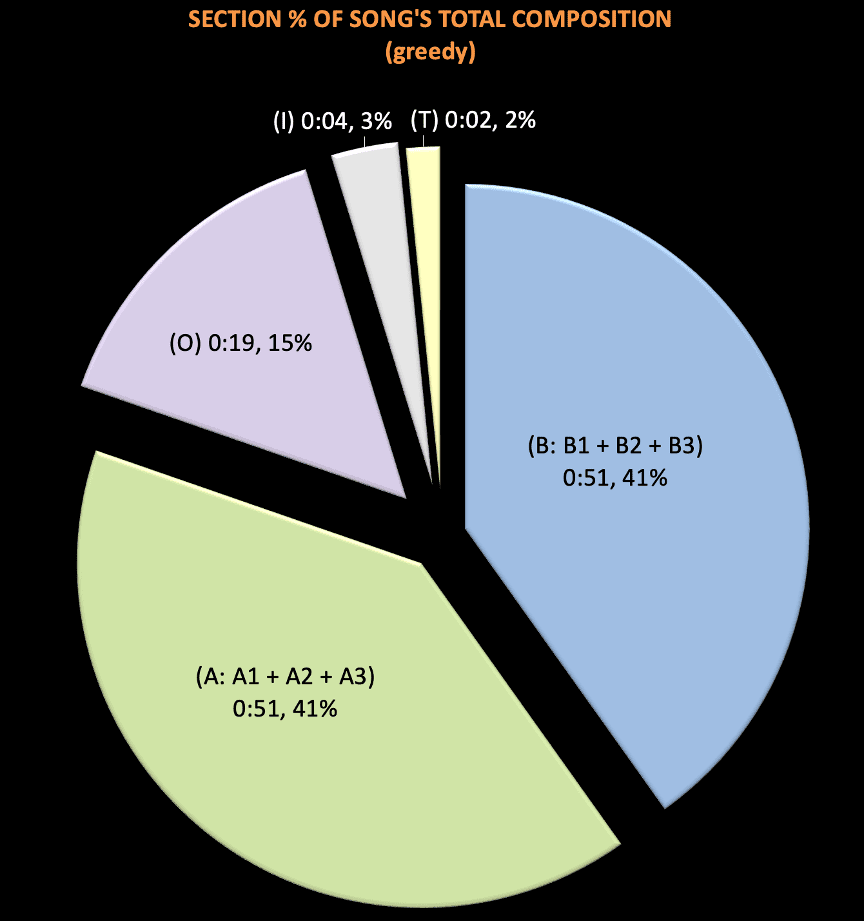

*Note that numbers may be rounded, resulting in slightly more or less than 100% of the song’s total composition
“greedy” allocates an equal amount of time to the choruses and verses, each comprising 41% of the song’s total composition. Note that the atypically higher verse allocation is due to the song’s inclusion of a verse 3 “D” section as opposed to a more common bridge (most non-hip hop hits contain two verses in their framework). The outro follows distantly at just 15%, and the intro and turnaround account for the least amount of time at just 3% and 2%, respectively.
In terms of trends in the year prior to its release, “greedy” allocates notably more time to its verses and choruses, slightly more time to its outro, and less time to its turnaround and intro.
“greedy” / Q4 2022 – Q3 2023 Non-Hip Hop Hot 100 Top 10 Average Time Allocation
- Intro: 3% / 7
- Verse: 41% / 30%
- Chorus: 41% / 34%
- Turnaround: 2% / 4%
- Outro: 15% / 10%
Tempo and Key
Tempo
“greedy’s” tempo lands at 111 BPM, 10 BPM faster than the non-hip hop top 10 average of 101 BPM in the first three quarters of the year. This is in line with the mainstream’s gravitation towards faster tempos and contributes both to its short runtime and dance influence. Other notable recent dance-influenced top 10s that fall within this tempo range are “Cuff It,” “Dance The Night,” and “Flowers.”
Average Tempo in Non-Hip Hop Hot 100 Top 10 Hits: 2018 – Q3 2023 (Top 5)
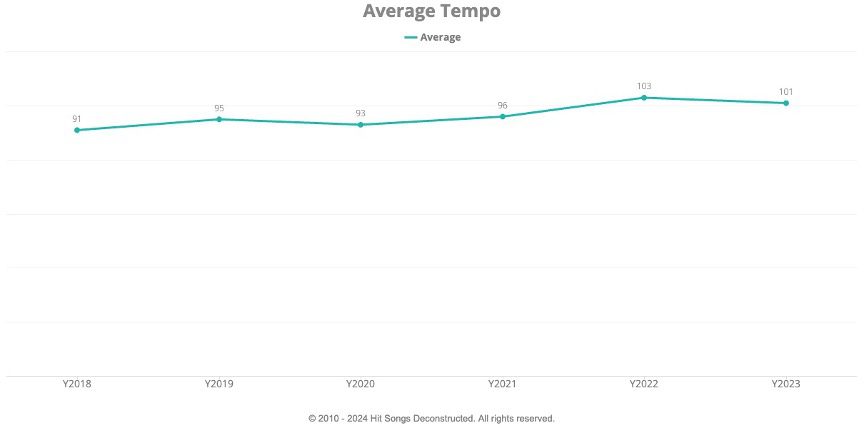

Key
“greedy” is in the key of F# minor. While minor tonalities in non-hip hop songs have been in the minority since 2019, the gap has generally been closing, culminating in a close 49%/51% split in the first three quarters of 2023.
Major vs. Minor Keys in Non-Hip Hop Hot 100 Top 10 Hits: 2018 – Q3 2023
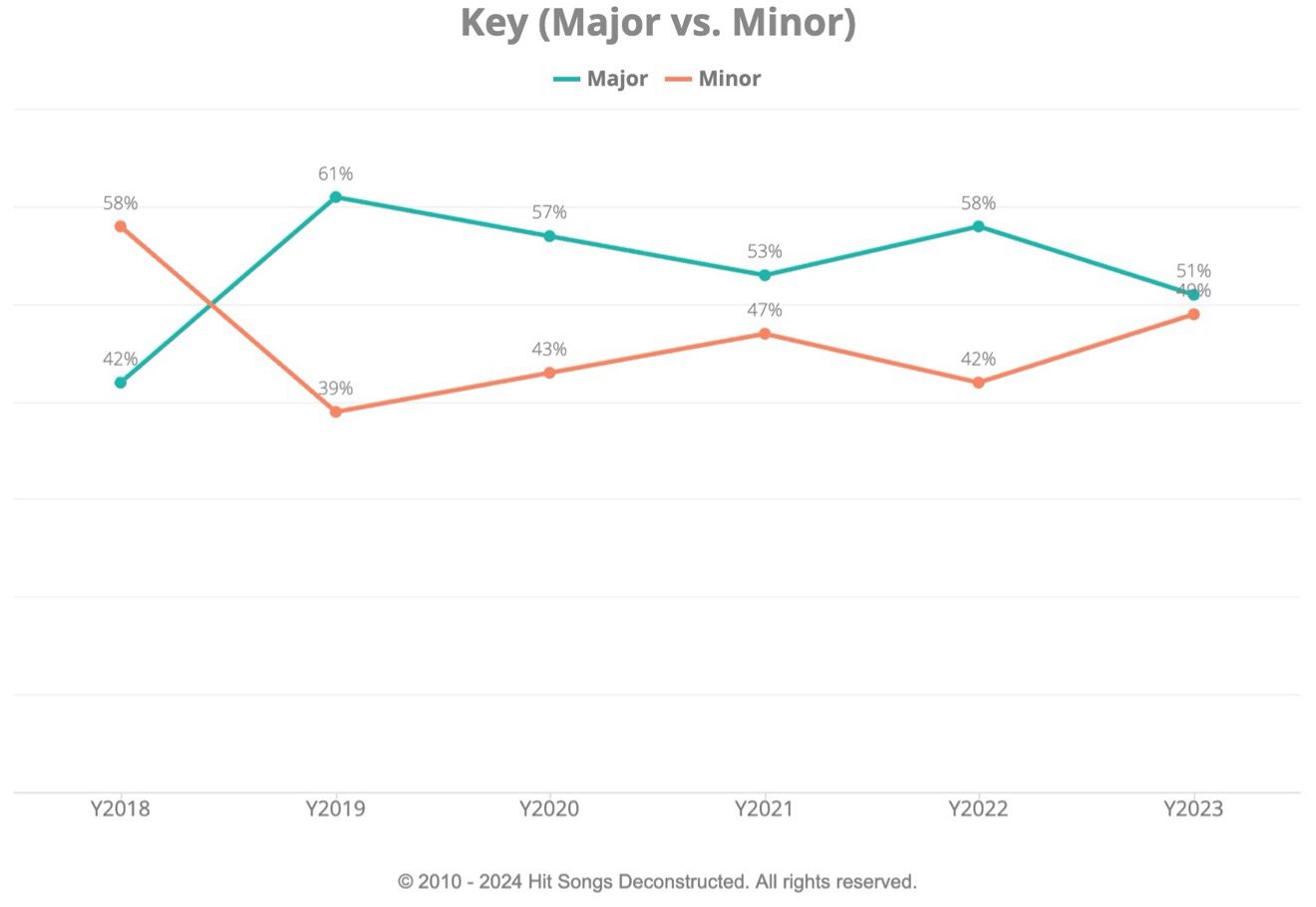

Genres & Influences
Genres & Influence Blend
Key
x: The influence appears minimally within the stanza and/or section
-/-: Divides stanzas


“greedy” features a combination of pop, R&B, dance/club, electropop/synthpop, and alternative influences that are put into effect by the qualities of the vocals, instrumentation, lyrics, and overall production.
The song’s main influence and primary genre is pop. This is due in part to its catchy K.I.S.S. ME (Keep it Simple, Singable and Memorable) melodies, array of infectious hooks, familiar pop structure, relatable love/relationships and inspiration/empowerment-themed lyrics, and polished production, to name a few.
Complementing the song’s pop influence is a notable R&B influence. Vocally, it is put into effect by McRae’s combination of smooth, sultry, confident, and melismatic vocals, which are in line with the styles of other recent R&B and pop-influenced stars such as Ariana Grande, Dua Lipa, and SZA, among others. Instrumentally, the smooth synths contribute to the R&B vibe, which along with the vocals culminates in the third verse’s filtered production.
The song’s underlying dance influence is put into effect mainly by its danceable 111 BPM tempo and dance-ready drum groove. It is featured notably throughout the entire song save for the first stanza of verse 3, which features a more simplified drum pattern.
Working hand-in-hand with the song’s overarching pop and dance influences is electropop/synthpop. It is put into effect mainly by the ample of use of synths - both bass and non-bass – and featured in varying degrees of prominence throughout the song save for the intro and turnaround, where it’s omitted. The influence is prominently featured in the chorus and outro sections due to their dense, synth-heavy qualities; moderately prominent in the second and third verses; and is least prominent in the sparser first verse.
Lastly, “greedy” possesses an underlying alternative influence that is present throughout the entire song. Contributing to it are the atypical handpan percussion hook, the dark, foreboding melodic synth in the chorus, the unique drum timbres, and left-of-center vocal production qualities.
Blending In & Standing Out in the Hot 100 Top 10
“greedy’s” expert balance of genres and influences enabled it to both blend in and stand out in the Hot 100 top 10. While individually all its influences are familiar to mainstream ears due to their varying degrees of prominence over the years, it’s their unique combination that is far more atypical.
Over the past decade, only six other Hot 100 top 10 hits have possessed all these influences under one roof in varying degrees of prominence, most of which stem from 2018 or earlier:
- “Beauty And A Beat” (Justin Bieber featuring Nicki Minaj – 2013)
- “Roses” (The Chainsmokers featuring Roses – 2016)
- “Closer” (The Chainsmokers featuring Halsey – 2016)
- “Bad At Love” (Halsey – 2017)
- “Happier” (Marshmello, Bastille – 2018)
- “Lavender Haze” (Taylor Swift – 2022)
Pop as a Primary Genre in the Hot 100 Top 10: 2018 – Q3 2023
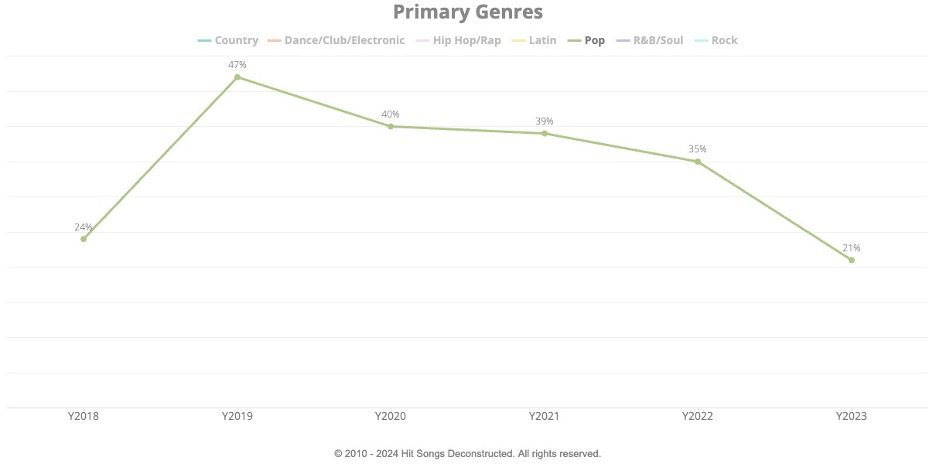

“greedy’s” Influences in the Hot 100 Top 10: 2018 – Q3 2023 (Outside the Hip Hop/Rap Primary Genre)
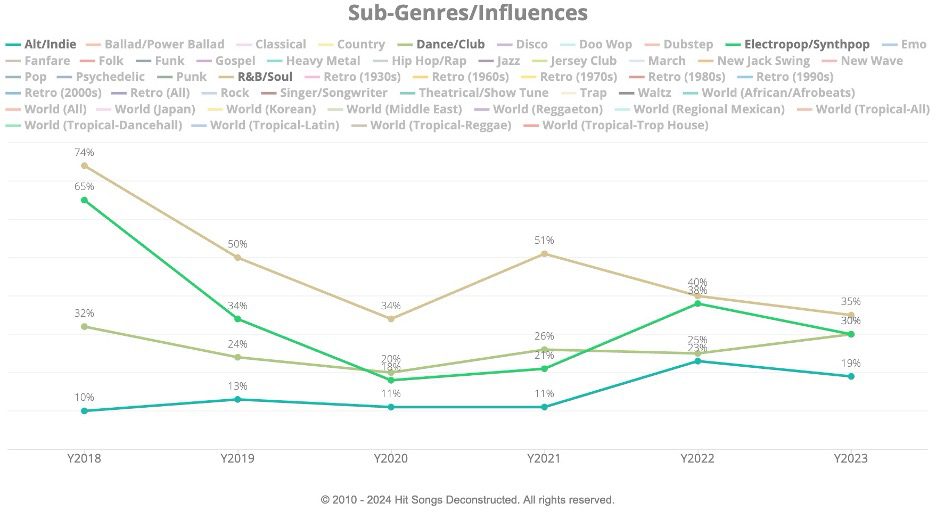

Energy & Dynamics
Energy Arrangement
S.I.A. (Section Impact Accentuator) Key
Downward Red S.I.A.: The full accompaniment is removed from the mix, resulting in a brief reduction in energy
Downward Yellow S.I.A.: A part of the accompaniment is removed from the mix, resulting in a brief reduction in energy


Loudness
“greedy’s” loudness levels generally match the song’s three energy “waves,” progressing from low to high across each sectional progression. Levels range from -12.5 in the turnaround (quietest) to -7.5 in the chorus “hook centers” and outro (loudest). Note that the higher loudness levels in these song-defining sections allows them to further stand out, connect, and bolster the listener’s emotional connection with the song.
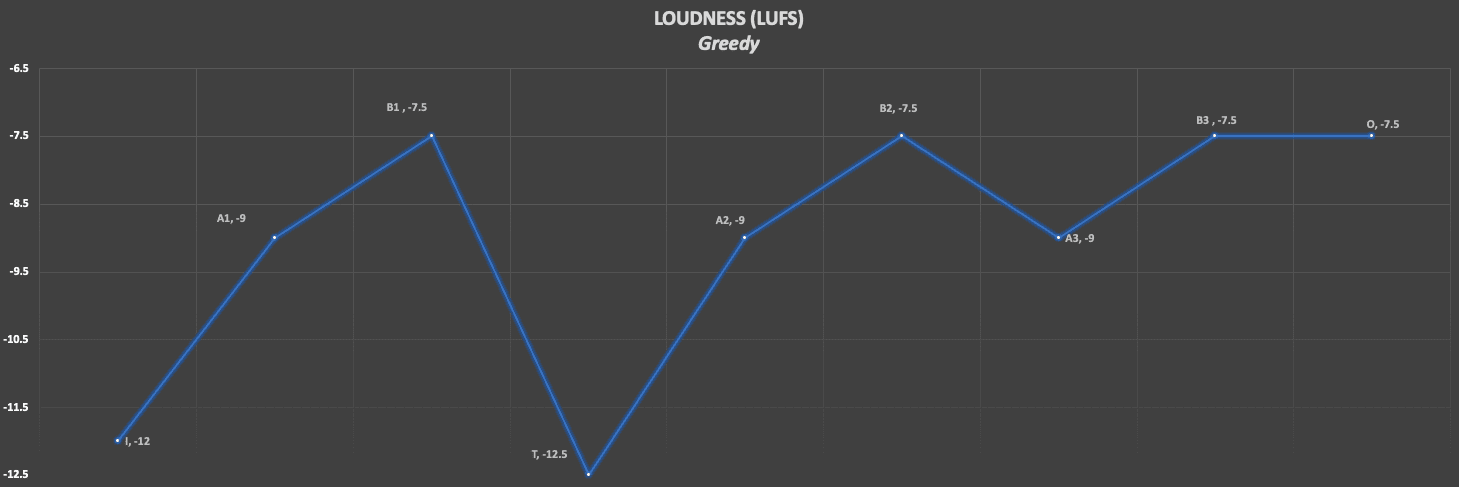

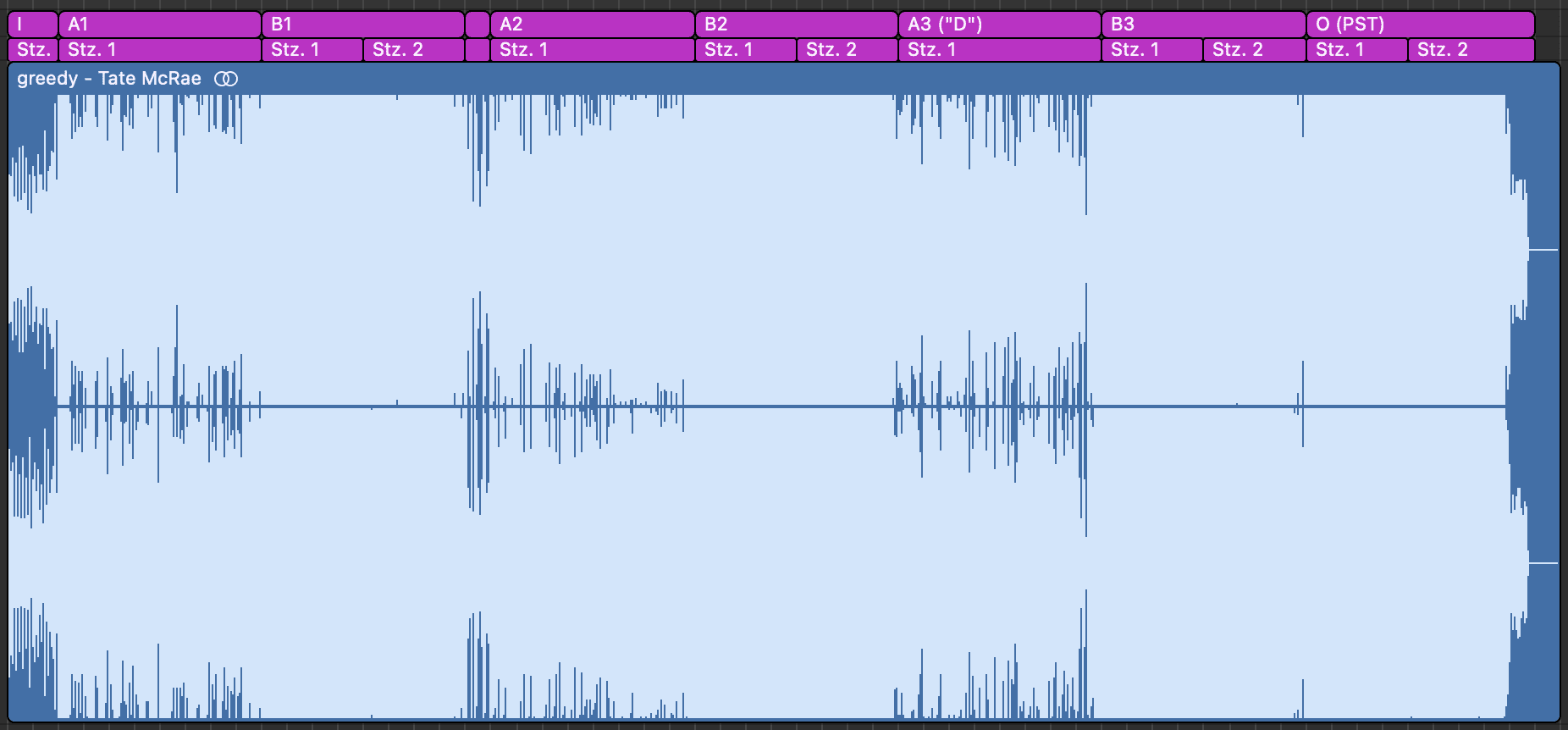

Energy: Section-By-Section
Wave 1: Intro (I) – Vocal Break 1 (VB1)
Intro (I)
“greedy’s” intro features the lowest energy in the song, as is commonplace in Hot 100 top 10 hits. Consisting mainly of the percussive handpan hook, the sparseness of the arrangement provides room for energy and density growth in subsequent sections while the hook’s vibrant rhythm puts the song into motion.
Midway through the section a reverse swell effect enters the mix, followed by a brief electronic drum roll, full accompaniment pull and high-pitched “whoo” at the end. Together, this S.I.A. (section impact accentuator) technique serves to heighten tension and anticipation leading into the verse and maximize its impact upon arrival.
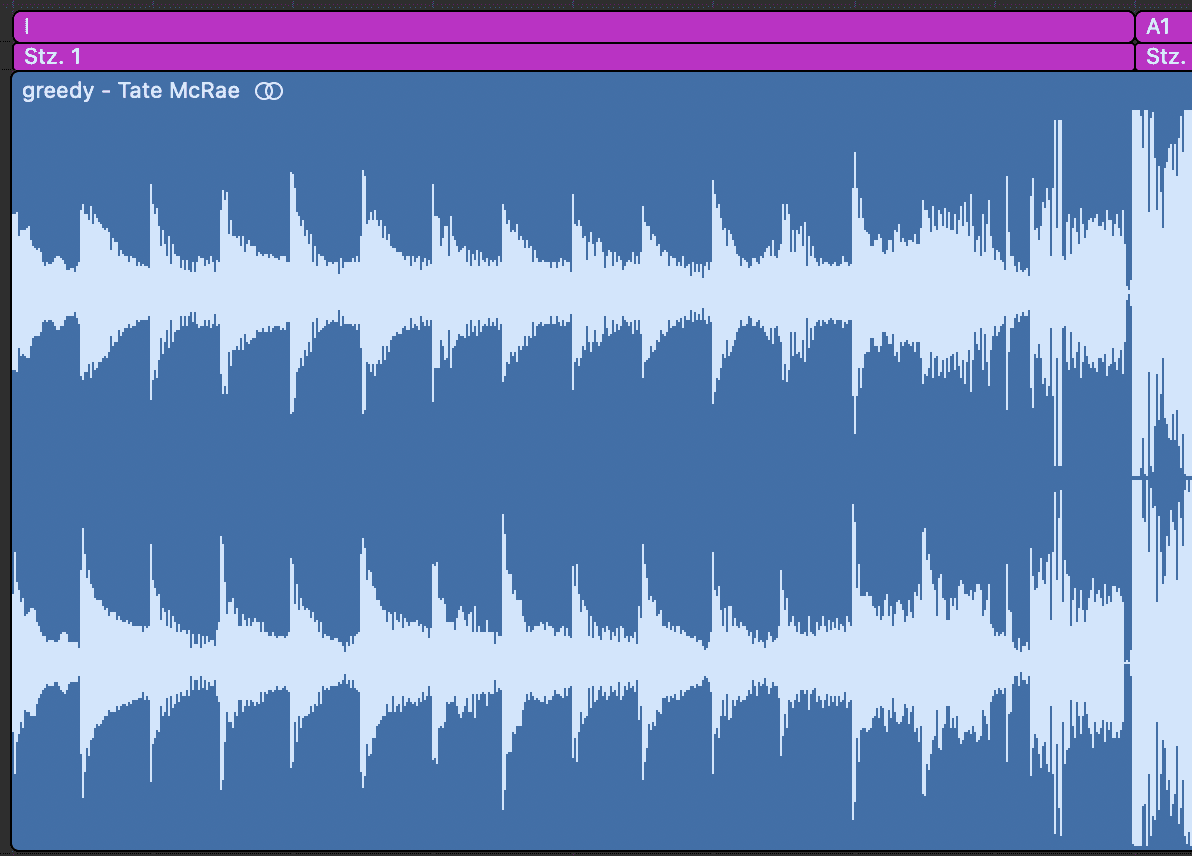

Verse 1 (A1)
Verse 1 begins with prominent glide bass on beat 1, which amplifies its impact following the S.I.A. at the end of the intro. Along with the continuation of the handpan hook, the section adds a steady drum/percussion beat into the mix that supports McRae’s eight-note driven vocals. The denser arrangement provides the verse with a greater degree of intensity compared to the intro, while McRae’s rhythmic vocals provides heightened forward motion.
At the end of the section, a brief partial accompaniment pull S.I.A. is implemented through the omission of the handpan hook. This creates a brief lull in energy that allows the chorus to hit with increased perceived impact.
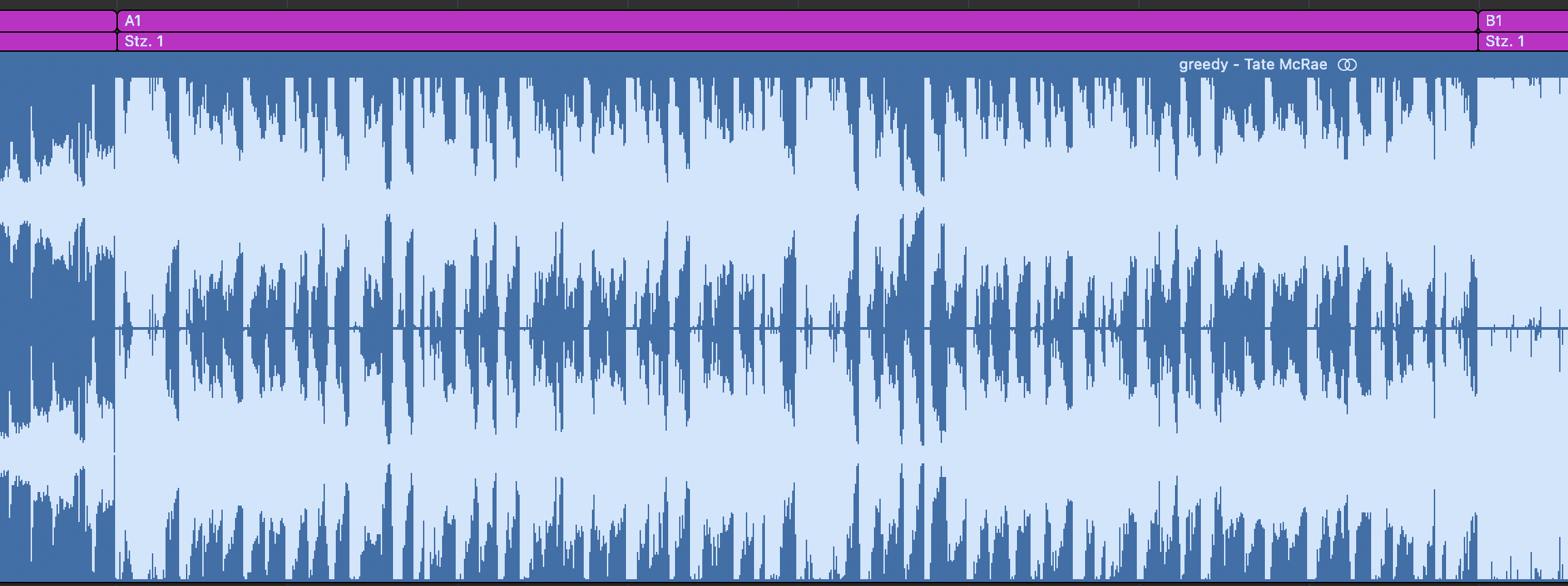

Chorus 1 (B1)
Following the partial accompaniment pull S.I.A., the chorus brings “greedy’s” energy up to its first peak through changeups in the instrumental arrangement and McRae’s vocals. Instrumentally, the arrangement is notably denser compared to the verse, adding sub bass, a lead synth hook and synth pad into the mix. Vocally, McRae’s vocals are in a higher register and delivered with a greater sense of urgency and passion. These changeups also take the song’s emotional intensity to an apex in support of the lyrics.
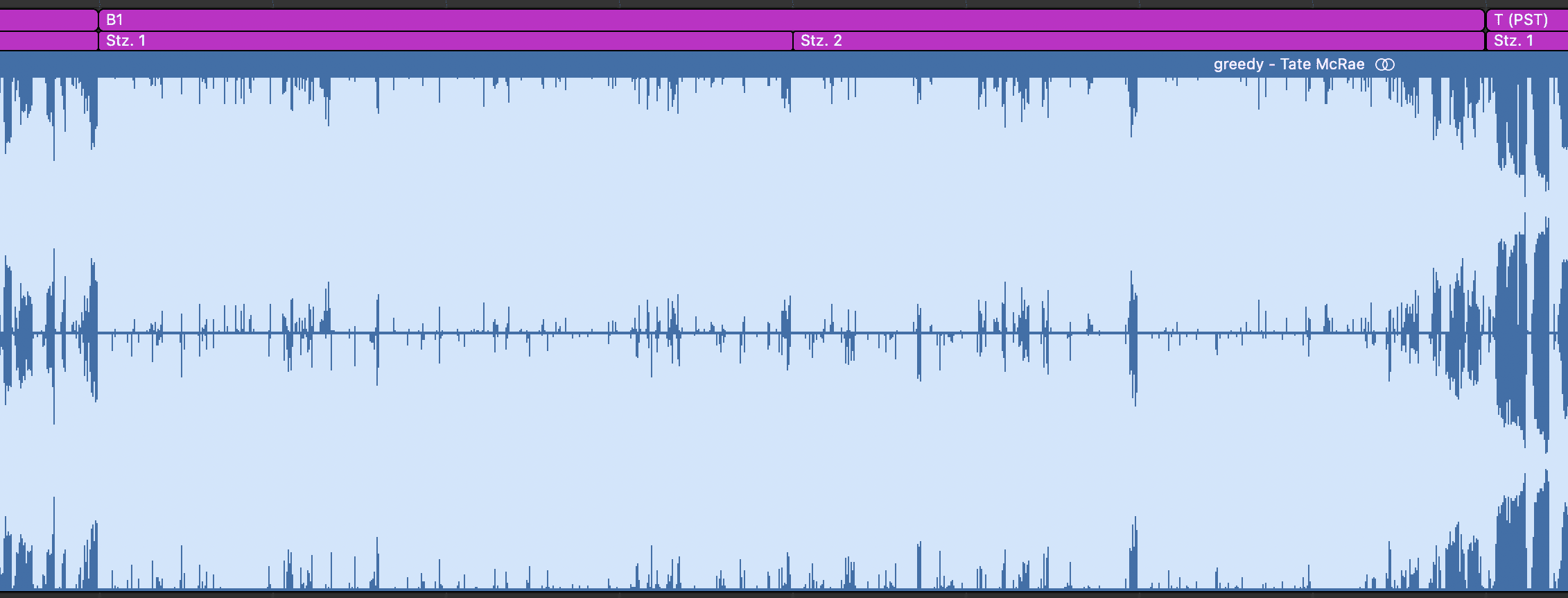

Turnaround (T)
Following the intense chorus, energy “wave” 2 begins with a notable reduction in energy in the brief one-bar turnaround. This is achieved through its thinned-out arrangement, where all the elements are removed save for the drums/percussion and McRrae’s hummed delivery of the handpan hook melody. This brief changeup serves to heighten listener engagement while providing room for energy and arrangement growth in subsequent sections.
Wave 2: Verse 2 (A2) – Outro (O)
Verse 2 (A2)
Verse 2 provides a significant rise in energy over the preceding turnaround, just as verse 1 rose in energy over the intro. However, just as the turnaround’s energy is higher than the intro due to the additional elements in the mix, the same is the case between verses. While they are similar, verse 2 adds sub bass and synth pad, which provides it with a denser, more intense feel.
Additionally, verse 2 uniquely adds a S.I.A. midway through the section, as opposed to exclusively at the end. The combination of the reverse swell effect and omission of the synth bass and pad creates a brief lull that both heightens in-section interest and provides additional like-section contrast.
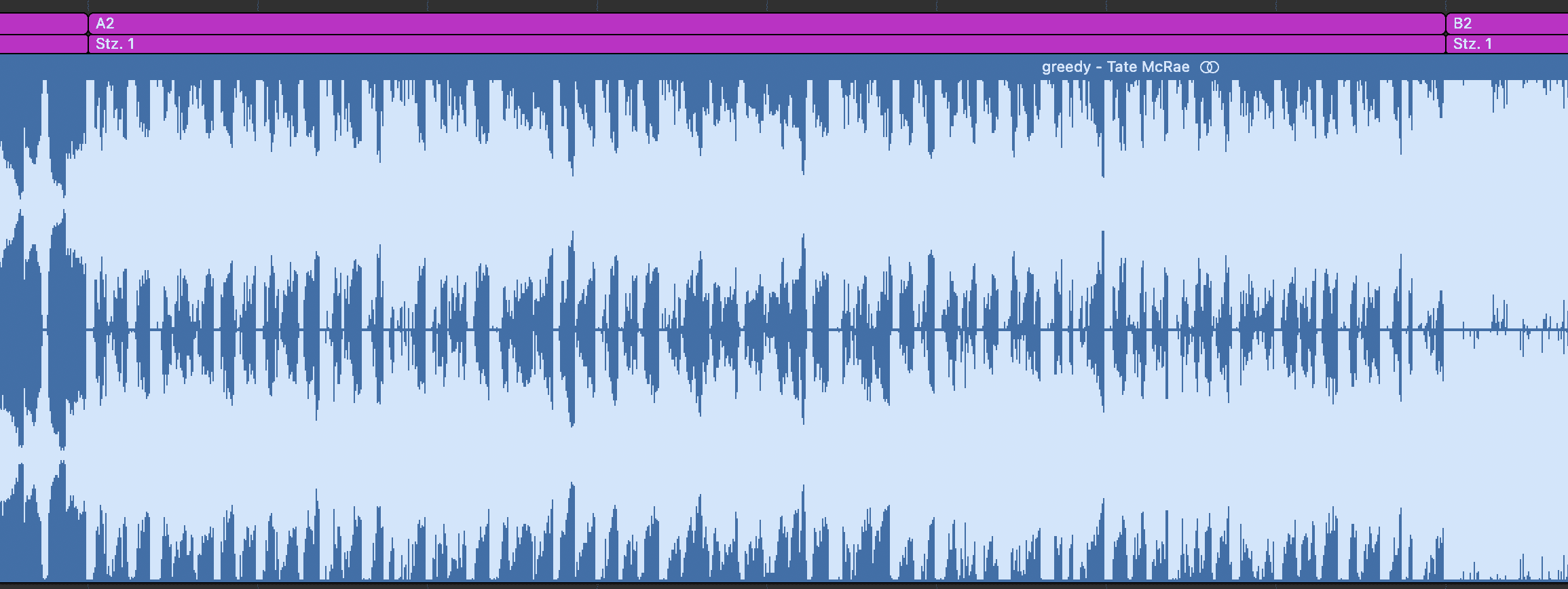

Chorus 2 (B2)
Following the S.I.A., “greedy’s” energy leaps back up to a peak in chorus 2. While it features the same qualities as its chorus 1 counterpart, the degree of energy contrast against the preceding verse isn’t as great this time around due to the denser verse 2 arrangement. However, the implementation of the same S.I.A. technique at the end of the section allows chorus 2 to hit with a comparable degree of impact.
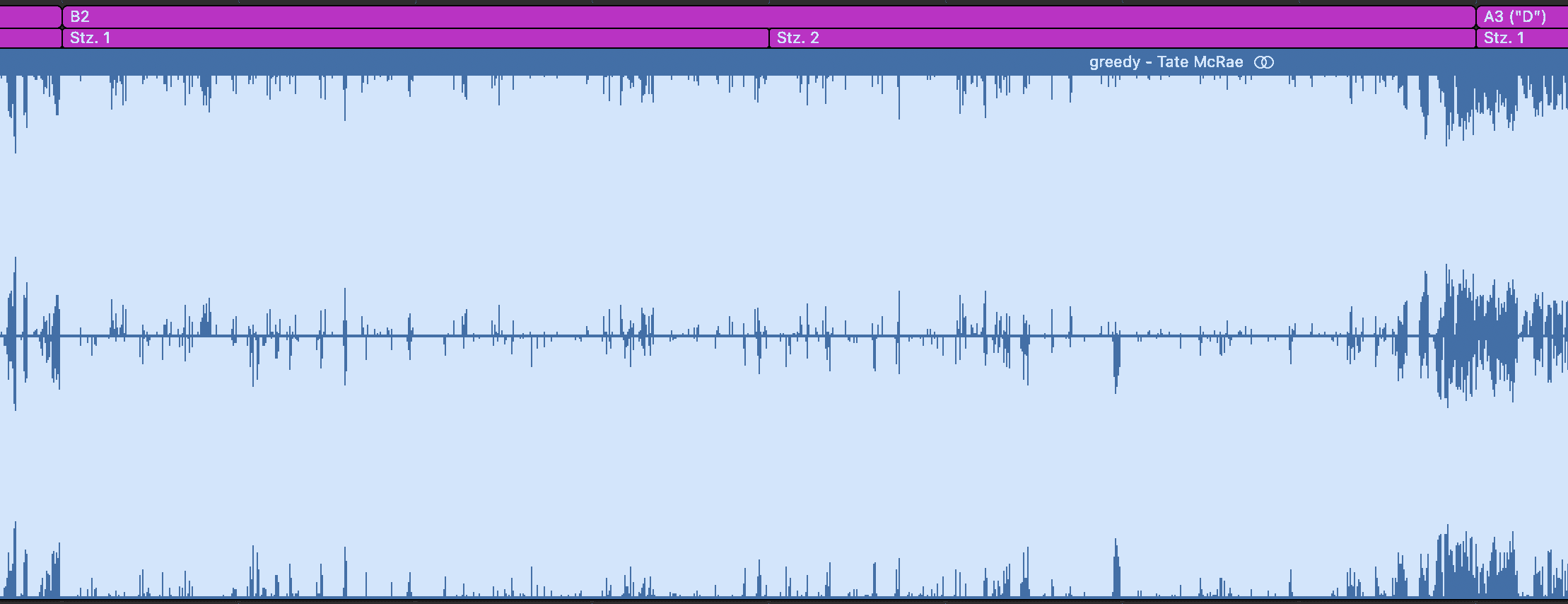

Verse 3 (A3)
Stanza 1 of the verse 3 “D” (departure) section provides a notable reduction in energy compared to the chorus through its stripped back, filtered arrangement. For the first time, the percussive handpan hook is omitted from the mix, and the drums consist of a sparse, filtered kick/snare and perc. pattern. In addition, a dark synth pad is introduced, which provides the mix with a more serene vibe while McRae’s familiar rhythmic verse melody and hummed double provides forward motion. At the end of the stanza, a partial accompaniment pull S.I.A. is once again implemented to heighten engagement leading into the second stanza.
With the elements of stanza 1 remaining in effect, stanza 2 raises energy through the reintroduction of the full drum/perc. beat and handpan hook. The section culminates in a unique, brief, full accompaniment pull S.I.A. along with two kicks that usher in the third and final chorus in an impactful manner.
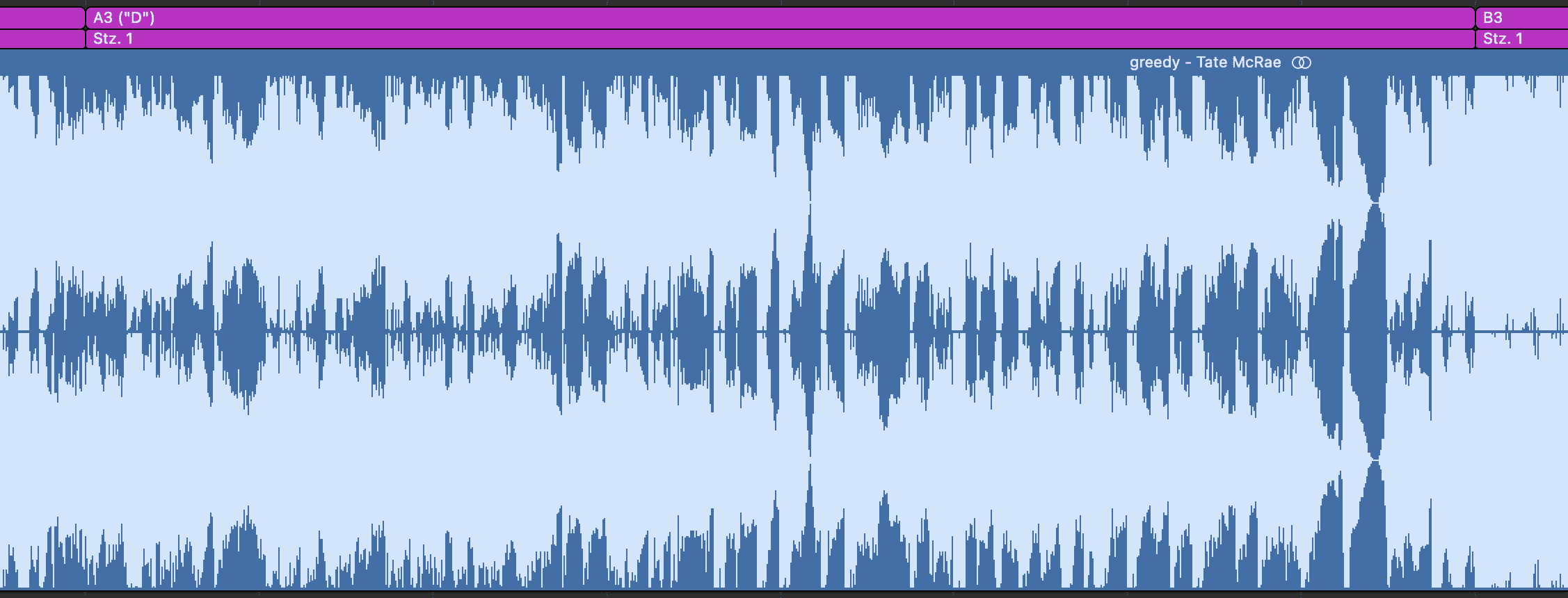

Chorus 3 (B3)
The third and final chorus thrusts “greedy’s” energy back up to a peak that is on par with choruses 1 and 2 due to the similar instrumental arrangements and vocal qualities.
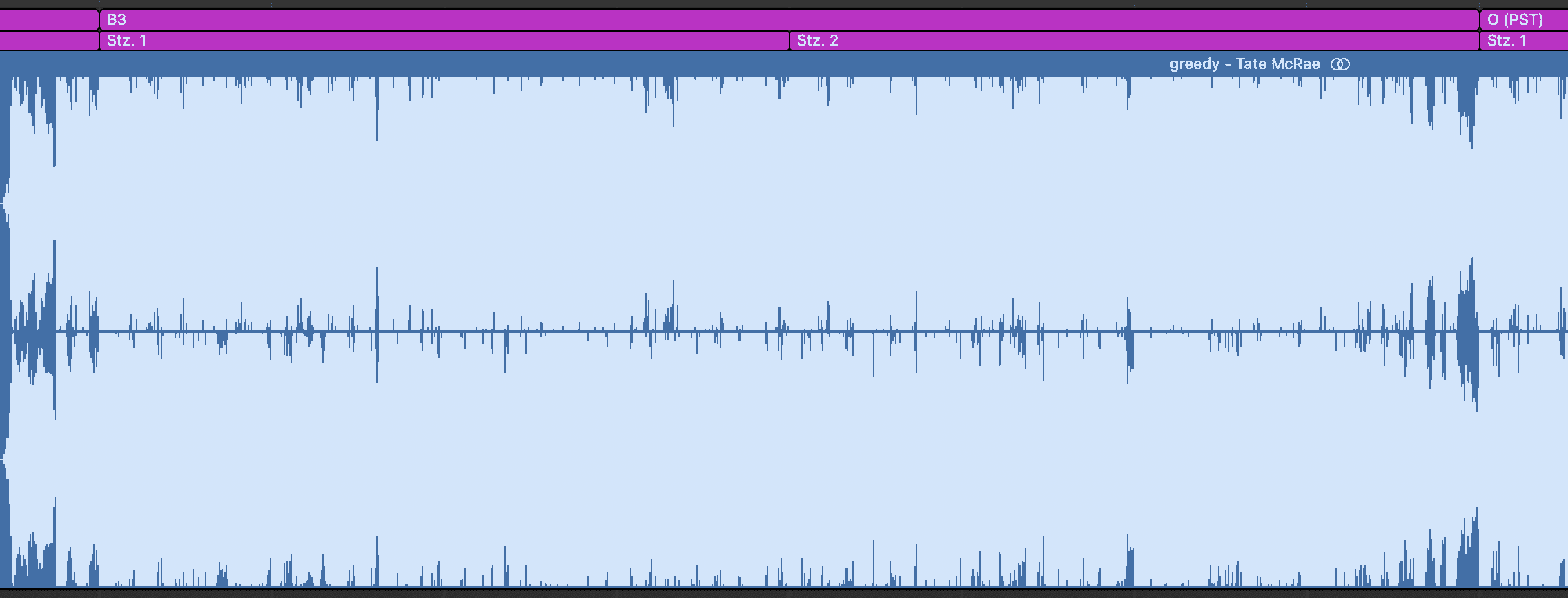

Outro (O)
The outro rides the listener out on an energetic high as the song comes to a conclusion. However, its energy is a notch below that of the chorus due to changeups in the vocals. While the outro maintains the chorus’s dense and powerful instrumental arrangement, the repetition of the “I would want myself” vocal is sung in a breathier, less dramatic manner compared to the chorus vocal and treated with ample reverb as it traverses the stereo field.
In terms of the outro’s two S.I.A.s, the first is implemented midway through the section to heighten engagement and spotlight the all-important “self” lyric. At the end of the section, a final full accompaniment pull S.I.A. is implemented to spotlight the hummed hook as the song concludes.
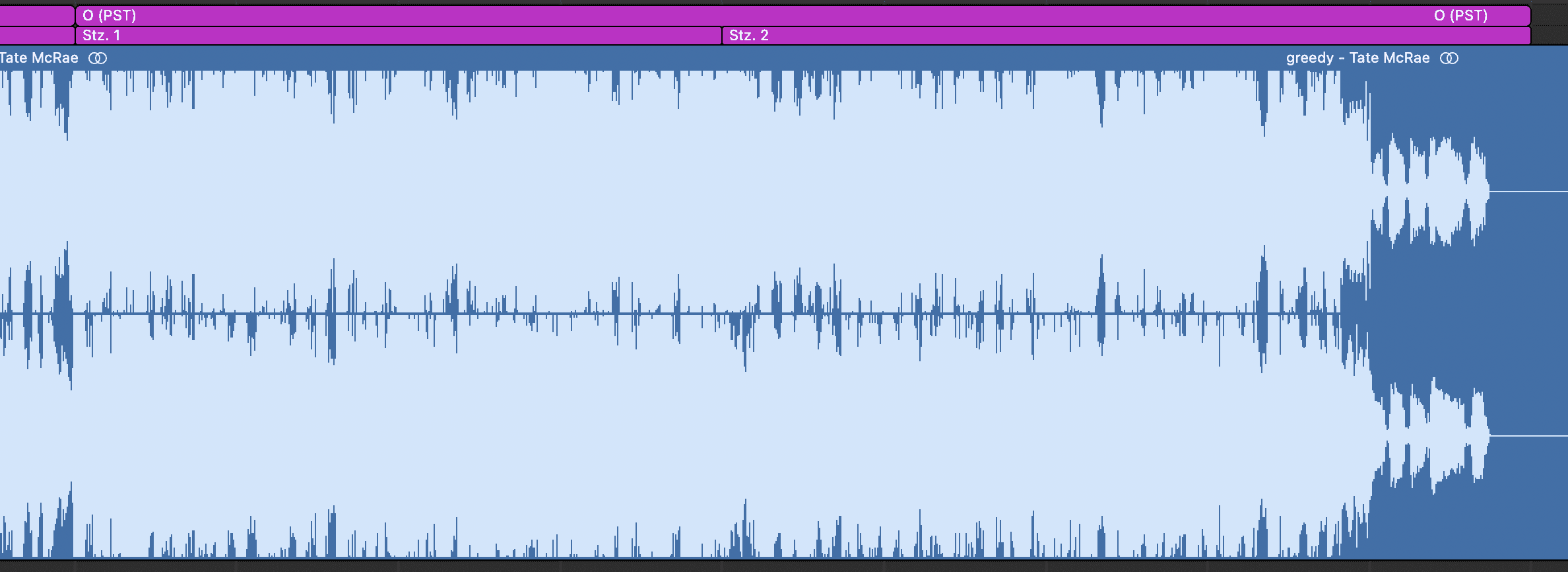

Instrumental Arrangement
Overview
“greedy” features an expertly crafted instrumental arrangement that keeps the listener engaged from start to finish while working in concert with the vocals and lyrics to establish a unified vibe and heighten emotional connection.
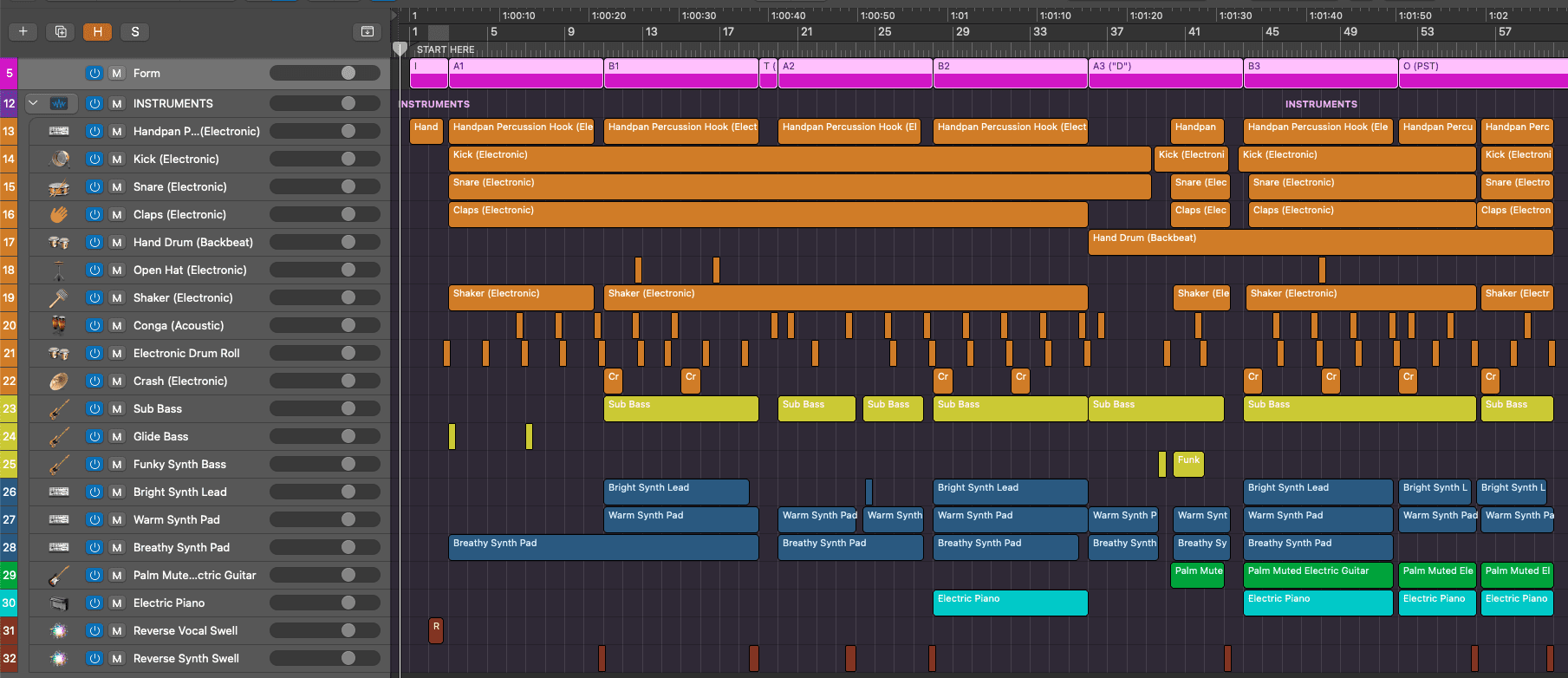

Primary Instruments
Drums/Percussion
Handpan Percussion Hook (Electronic)
Handpan percussion plays the main melodic hook heard throughout the majority of the song. It was created using an Omnisphere patch of sugar packets hitting a handpan, providing a rattling tone overtop the pitches.
Kick (Electronic)
The electronic kick is introduced in the first verse and remains in effect throughout the song. It is processed with compression and features a strong, punchy quality that allows it to cut through the mix. The accented off-beats and 808 timbre provides it with a quality found in both hip hop and electropop productions.
A low-pass filter is used on the kick in the first half of verse 3, removing the high end. This provides it with a subtler quality that jibes with the more serene accompaniment.
Snare (Electronic)
The electronic snare is introduced in verse 1 and remains in effect throughout the song. It provides a steady backbeat on beats 2 and 4 and possesses a bright and dry timbre that allows it to cut through the mix. Like the kick, it is processed with low-pass filtering in verse 3 to reduce its prominence in the mix.
Claps (Electronic)
The electronic claps are introduced in verse 1 and remain in effect across sections except for the first half of verse 3. Made up of several claps layered together, they appear one sixteenth note before beat 2, as well as directly on beat 2. The anticipated note and the depth of the bright clap layers add to the snare sound, providing the backbeat with heightened punch, body, and definition.
Hand Drum (Backbeat)
A hand drum is introduced to the mix in verse 3 playing on beat 4, and for the remainder of the song on beats 2 and 4. Functioning similarly to the snare, its organic timbre provides a subtle additional texture and helps punctuate the backbeat.
Open Hat (Electronic)
The electronic open hi-hat is heard briefly in the choruses 1 and 3, subtly contributing to the groove while providing additional high frequency information.
Shaker (Electronic)
The electronic shaker is introduced in verse 1 and remains in effect throughout the song save for the first half of verse 3. It functions as a low-level percussive embellishment, playing a repeated groove throughout the first two beats of each measure.
Conga (Acoustic)
The acoustic conga is introduced in verse 1 and is featured sparsely across sections. It subtly contributes to the groove while providing the mainly electronic mix with acoustic color and texture.
Electronic Drum Roll
The electronic drum roll, a rapid fill with a clicky, synthetic timbre, is heard on the last beat of every two-bar phrase throughout the song. It is moved to the upbeat of beat 1 in the first chorus, then shifted to beat 4 in subsequent choruses and is reversed in bar 4 of verse 2 to complement the reversed synth lead.
Crash (Electronic)
The electronic crash possesses a sizzle-y timbre and is used to subtly punctuate the arrival of each four-bar phrase during choruses and the outro.
Bass
Sub Bass
The sub bass enters in the first chorus and remains in effect in each section save for the brief turnaround. It is a rich, legato bass that provides low-end power and depth within the otherwise mid and high-frequency range dominant mix.
Glide Bass
The glide bass is featured exclusively in the drums/percussion-driven first verse, punctuating the section’s arrival and midway points.
Funky Synth Bass
The funky synth bass enters in verse 3, providing a classic 1980s funky embellishment leading into the second half of the section.
Synths
Bright Synth Lead
The bright lead synth is heard in each chorus as well as the outro. It plays a high-pitched sustained melody that functions as one of the song’s main hooks while contributing to vibe through its tense and tremolo-processed quality.
Warm Synth Pad
The warm synth pad is introduced in the first chorus and remains in effect throughout the song save for the turnaround. It is layered on top of the sub bass, providing the bottom end with additional color and texture. In verse 3, the timbre is tweaked to provide the pad with a fuller tone within the sparse arrangement.
Breathy Synth Pad
The breathy synth pad is introduced in the first verse and remains in effect across sections save for the turnaround. It is heard most notably within the sparser arrangements (i.e., verse 1), and possesses an airy, breathy timbre that pairs with heavy reverb to add low-level atmosphere to the mix.
Guitars
Palm Muted Electric Guitar
The palm muted electric guitar is first introduced in the second half of verse 3 and remains in effect for the duration of the song. Its primary function is to reinforce the handpan hook melody in a fresh manner while contributing a new texture to the mix.
Keys
Electric Piano
The electric piano enters in chorus 2 and is subsequently featured in chorus 3 and the outro. Its Fender Rhodes timbre contributes warmth to the mix while its arpeggiated pattern outlines the chord progression.
Effects
Reverse Vocal Swell
The reverse vocal swell is exclusively heard at the end of the intro leading into verse 1. Its primary function is to heighten tension and engagement leading into the first installment of the narrative.
Reverse Synth Swell
The reverse synth swell functions in a transitional capacity across most sections in the song. Similar to the vocal swell, its primary function is to heighten tension and engagement while imparting the mix with additional color and texture.
Instrumental Arrangement: Section By Section
Intro (0:00 – 0:04)
Chord Progression: N.C.
“greedy’s” 4-second intro features the sparsest arrangement in the song, consisting solely of the handpan hook and reverse swell effect. Within this short runtime, the section achieves a host of important things:
- The sparseness of the arrangement spotlights the handpan hook, allowing it to easily cut through airwave clutter, grab the listener’s attention and hook them in. In addition, its unique timbre functions as an instantly identifiable calling card for the song. As soon as one hears it, they know exactly what song it is.
- The sparseness of the arrangement leaves room for density and energy growth in subsequent sections, while the upper-mid frequency focus provides room for frequency expansion.
- The percussive quality of the handpan hook and its associated rhythm establish the song’s vibrant 111 BPM groove in lieu of drums.
- Aspects of the handpan hook’s melody and rhythm foreshadow and subsequently reinforce McRae’s lead vocal in the verse, turnaround, and outro sections.
- The qualities of the handpan hook and swell effect establish “greedy’s” pop influence and allude to the electropop direction the song takes.
- The reverse swell effect, which enters at the midway point, serves as a tension and anticipation heightening section impact accentuator (S.I.A.) leading into the verse. The S.I.A. is bolstered by the brief electronic drum roll, full accompaniment pull, and high-pitched “whoo” at the end.
Intro Arrangement: At-A-Glance
Verse 1 (0:04 – 0:21)
Chord Progression: F#m (F# minor: i)
With the handpan hook providing cross-section continuity, the verse adds drums/percussion into the mix, consisting primarily of electronic kick, layered snare and claps, and shaker. Together, they lock the listener into the song’s fully developed, vibrant groove in conjunction with McRae’s rhythmic eighth note-driven vocals. The instrumental groove remains constant throughout the section, keeping the listener’s full focus on McRae and the first installment of the narrative without distraction.
In addition to the drum/perc groove, sporadic sub bass and conga are introduced to the mix:
- A brief sub bass glide is implemented on beat 1 of measures 1 and 5 (the section’s starting and midway points). In measure 1 it introduces the section in an impactful manner following the anticipation heightening S.I.A. at the end of the intro. Its return in measure 5 serves as a familiar beacon while subtly heightening interest within the repetitive section.
- A single conga hit is employed on beat 3 of measures 4, 6 and 8. While subtle, it further defines the groove while providing an acoustic texture to the overt electronic mix.
Also, in terms of timbre and frequency, the layered snare and claps define and punctuate the backbeat (a highly common practice in electro-leaning hits) while contributing mid/high frequency information to the mix. The punchy kick covers the mid-low range and the sporadic sub bass covers the low end. However, its sporadic use allows for low-end expansion in the ensuing chorus. In addition, a low-level, breathy pad processed with copious reverb is featured throughout, providing the mix with additional depth and atmosphere.
At the end of the section, a brief partial accompaniment pull S.I.A. is implemented through the omission of the handpan hook. This creates a brief transitional lull that boosts engagement leading into the chorus while enabling it to hit with increased perceived impact.
Verse 1 Arrangement: At-A-Glance
Chorus 1 (0:21 – 0:38)
Chord Progression: D – Bm – F#m – E (F# minor: bVI-iv-i-bVII)
Following the S.I.A. at the end of the verse, the first chorus hits hard with the densest instrumental arrangement heard in the song thus far. It features both recycled and new elements, simultaneously adding familiarity and interest while accentuating the chorus’s vibe and emotional impact.
Familiarity
The continuation of the handpan hook, snare, claps, shaker, and conga keeps the listener locked in the infectious groove across sections. However, the handpan hook’s prominence is reduced within the denser arrangement. While it might seem counter intuitive to reduce a primary hook’s visibility, there are a few key reasons for it:
- It puts the listener’s full focus on the catchy chorus vocals and summative lyrics.
- It makes room for the new melodic synth hook (see below).
- It prevents the handpan hook from becoming overly redundant and waring out its welcome.
Interest
Along with low-level electronic crash, which subtly punctuates the start of both four-bar phrases, the chorus adds the following new and changed up elements to the mix:
- The sub bass now plays a continuous legato pattern as opposed to sporadic glides. This provides the mix with continuous bottom end power and low-frequency depth within the otherwise mid and high-frequency mix. It also contributes to the section’s dark vibe, which compliments the lyrics.
- A new warm synth pad is layered on top of the sub bass, providing additional color and texture that also compliments the vibe.
- A new bright lead synth plays two near-verbatim repetitions of a high-pitched, sustained melody that begins on the downbeats of measures 11 and 15. The pattern’s simplicity, unique timbre, and vibrato processing creates a recognizable instrumental hook that stands out while not overshadowing McRae’s lead vocal focus. Additionally, its timbre imparts a tense, somewhat ominous vibe that compliments the foreboding lyrics.
- Similarly to the entrance of the chorus, the exit uses a reverse synth swell to heighten the impact of the ensuing turnaround. This is achieved by likely subverting the listener’s expectations of a more intense section (i.e., a post-chorus) and instead going into breakdown mode in the turnaround.
Chorus 1 Arrangement: At-A-Glance
Turnaround (0:38 – 0:40)
Chord Progression: N.C.
Following the dense and energetic chorus, the 1-bar turnaround breaks the song down to the core drum/percussion groove, consisting of kick, snare, claps, shaker and conga. While brief, this pronounced shift serves a few key purposes within the song’s framework:
- It notably heightens the listener’s engagement following the arrangement build in the preceding sections.
- It provides room for arrangement, energy, and frequency growth in the ensuing sections.
- It puts the listener’s focus on McRae’s new hummed delivery of the handpan hook melody. This creatively keeps the hook melody in the listener’s head while heightening interest and preventing the handpan from becoming overly redundant.
- It keeps the listener locked in the song’s core groove while all the above is achieved.
Turnaround Arrangement: At-A-Glance
Verse 2 (0:40 – 0:58)
Chord Progression: D – Bm – F#m – E (F# minor: bVI-iv-i-bVII)
Following the brief transitional turnaround, verse 2 engages the listener at a heightened level through a return to the core verse 1 arrangement. The main differences between like-sections are the addition of sub bass and warm synth pad, which weren’t present the first time around. These elements provide verse 2 with a comparatively denser and more energetic quality that enhances both like-section and cross-section interest while maintaining familiarity in the scope of the song.
In addition, a reverse swell effect is uniquely implemented at the midway point. While subtle, it serves to further heighten in-section interest while providing additional like-section variation. In the second half of the verse, the tone subtly shifts, introducing a more pronounced sub-bass and warmer synth sound.
At the end of the section, the same breakdown S.I.A. technique that was used to transition into chorus 1 is used to transition into chorus 2. However, this time around its impact is more pronounced due to the denser arrangement that precedes it.
Verse 2 Arrangement: At-A-Glance
Chorus 2 (0:58 – 1:15)
Chord Progression: D – Bm – F#m – E (F# minor: bVI-iv-i-bVII)
The chorus 2 arrangement is essentially the same as its chorus 1 counterpart, which strengthens the song’s familiarity factor. However, to prevent cookie-cutter redundancy, arpeggiated electric piano chords are added to the mix. Their addition serves a variety of purposes, including providing subtle like-section contrast, contributing to density, and providing additional color, texture, and harmonic support. Furthermore, the warm Fender Rhodes-inspired timbre contributes to the vibe while seamlessly blending in with the other elements in the mix.
Chorus 2 Arrangement: At-A-Glance
Verse 3 (1:15 – 1:32)
Chord Progression: D – Bm – F#m – E (F# minor: bVI-iv-i-bVII)
Verse 3 serves as “greedy’s” main “D” (departure) section in lieu of a much more common bridge. While most of its instrumental elements have been featured in previous sections, their unique context heightens interest while supporting the familiar verse melody.
Segment 1 (Bars 1-4)
The first half of the section strips back to kick, snare, conga, and two synth pads – the warm synth pad and breathy synth pad – all of which were present in verse 2. Together, these elements, along with the notable omission of the handpan hook, achieve the following:
- The sparseness of the arrangement notably heightens interest and engagement coming out of the dense and intense chorus while putting the full focus on McRae’s vocals and narrative development.
- The filtered processing of several instruments and synth pads creates a melancholic vibe that frames the vocals and lyrics in a unique context.
- The stripped back drum/perc pattern prevents the familiar vibrant groove from becoming redundant while keeping the listener locked in and leaving room for development.
- The omission of the handpan hook is important for a few key reasons, including preventing it from becoming overly redundant, providing a reduction in energy, and leaving room for higher frequency growth (also achieved through the filtering). In its absence, McRae subtly hums the hook melody, further reinforcing it while contributing to forward motion and groove (her vocal is essentially functioning in an instrumental capacity).
- In bar 4, a partial accompaniment pull S.I.A. is implemented leading into the second segment. Along with heightening in-section interest, it emphasizes the lyric “never met someone like that” through its breakdown quality, locks the kick in with the vocal, and provides a brief funky flourish through the funky synth bass embellishment.
Segment 2 (Bars 5-8)
The second half of the section adds the other verse 2 elements back into the mix, which ramps up density and intensity while heightening both like-section familiarity and in-section interest. However, the filtering remains in effect, which both maintains the section’s vibe and provides room for frequency development in the ensuing chorus.
The main new element added to the mix is a palm muted electric guitar, which delivers the familiar handpan hook melody. Its addition further defines and reinforces the hook melody while the handpan hook is relegated towards the back of the mix due to the filtering. It also provides the section with unique color and texture not heard before.
At the end of the verse, a unique full accompaniment pull S.I.A. and two kick drum hits usher in the third and final chorus in an impactful manner.
Verse 3 Arrangement: At-A-Glance
Chorus 3 (1:32 – 1:50)
Chord Progression: D – Bm – F#m – E (F# minor: bVI-iv-i-bVII)
Following the pronounced S.I.A., the third and final chorus hits with high impact, returning to the chorus 2 accompaniment along with the continuation of the palm muted electric guitar hook from verse 3. This dense instrumental arrangement takes the song’s intensity to a grand climax in conjunction with McRae’s impassioned vocals while maintaining strong familiarity with the other choruses.
Chorus 3 Arrangement: At-A-Glance
Outro (1:50 – 2:09)
Chord Progression: D – Bm – F#m – E (F# minor: bVI-iv-i-bVII)
The outro maintains the intense chorus 3 arrangement, with the sole variation being a brief mid-section S.I.A. that captures attention within the repetitive section. The cross-section continuity keeps the listener locked into the intense groove while placing their main focus on the repetition of the vocal hooks without distraction.
At the end of the section, a full accompaniment pull S.I.A. is implemented to create a jarring moment that spotlights McRae’s hummed delivery of the hook as the song comes to a conclusion.
Outro Arrangement: At-A-Glance
Vocals
Vocal Production
Lead Vocal Gender
“greedy” features a solo female lead vocal from Tate McRae. Over the past five years, solo female and solo male-led non-hip hop hits essentially ran neck-and-neck in the Hot 100 top 10. However, the gap widened in the first three quarters of 2023, with solo male outperforming solo female 40% to 28%.
Lead Vocal Gender in Hot 100 Top 10 (Non-Hip Hop Hits): 2018 – Q3 2023
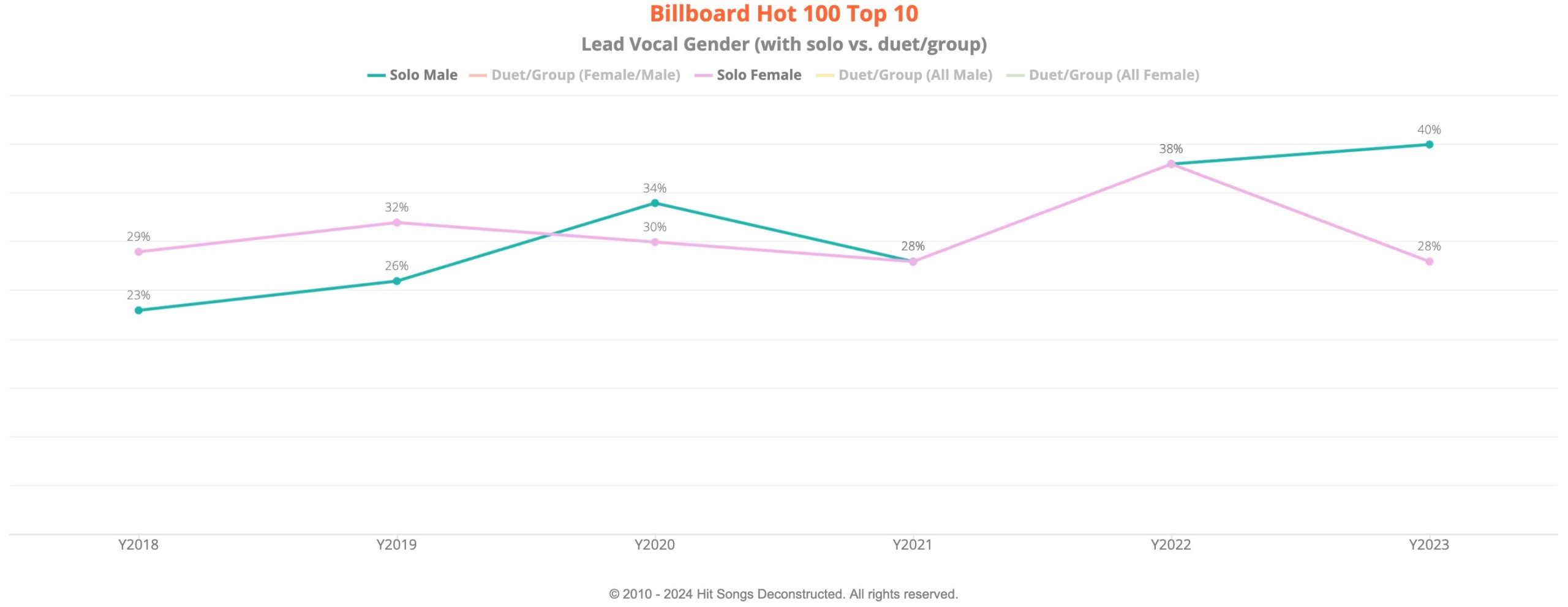

Lead Vocal Delivery
“greedy” features sung lead vocals from Tate McRae. While sung vocals are unsurprisingly most common among non-hip hop hits, they have recently been in decline, dropping from 79% of songs in 2019 down to 65% in the first three quarters of 2023. Conversely, songs with a combination of sung and rapped vocal qualities have been on the rise.
Lead Vocal Delivery in Hot 100 Top 10 (Non-Hip Hop Hits): 2018 – Q3 2023


Background Vocals
“greedy” features a host of background vocals that heightens its impact and engagement value. They include unison and low-octave doubles that enhance McRae’s lead; low-level hummed vocals that double the instrumental handpan hook; sung vocals that reinforce the “I would want myself” chorus hook in a fresh manner in the outro; and independent of the lead sung and shouted adlibs that serve as catchy embellishments.
Effects & Processing
An array of vocal effects and processing are used throughout the song to heighten its engagement and emotional impact. They include varying degrees of reverb, delay, compression, and Auto-Tune, as well as formant shifting and autopan.
Vocal Delivery Arrangement Overview
Lead: Female (Tate McRae): Tate McRae’s lead vocal
BGV 1: Female (Unison Double): Background vocal doubles in unison with the lead
BGV 2: Female (Low Octave Double): Background vocal doubles an octave below the lead
BGV 3: Female (Instrumental Hoo Double): Filtered background vocal doubling the handpan hook
BGV 4: Female (Sung Vocal Hook): Background vocals that sing the “I would want myself” hook in the outro
BGV 5: Adlibs: Independent of the lead sung and shouted adlibs.
Key
S: Sung
SH: Shouted
W: Whispered
hm: Hummed, low level in the mix
BGV: Background vocals
Underlined Lyrics: Denotes unison and octave doubles with the lead; one underline denotes unison double(s), and double underlines denote additional octave double(s)
Color-Coded Lyrics: Denotes lyrics sung in unison with the lead (light green), octaves with the lead (dark green), and independent of the lead (orange). Note that this matches the color-coding of the above vocal arrangement overview table.
Italicized Lyrics: Denotes a unique production quality.
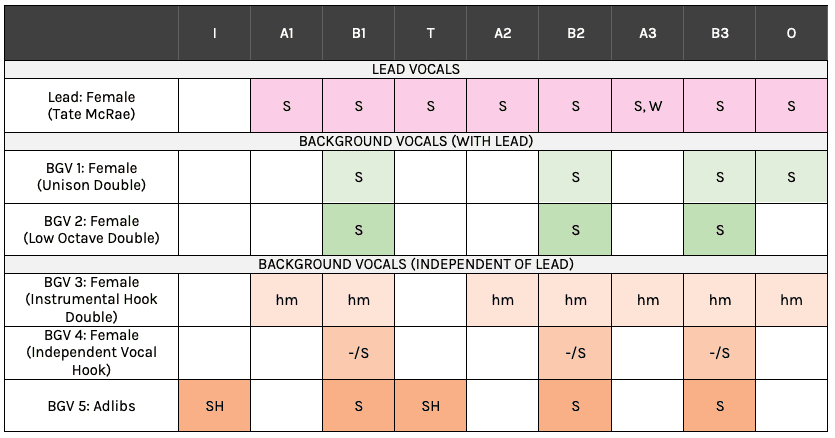

Vocal Production: Section-By-Section Detail
Intro


The first vocal heard in the song is a high-pitched, sampled “woo.” Appearing at the end of the intro, it serves as engaging lead in to the ensuing verse while fitting with the song’s overt mainstream pop qualities.
Verse 1
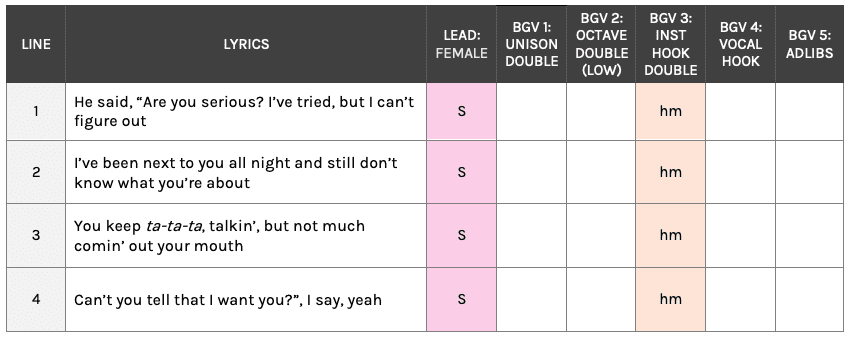

Verse 1 introduces McRae’s solo lead vocal into the mix. Her voice is processed with compression, minimal Auto-Tune, and ample reverb, seamlessly blending her vocal into the mix while providing heightened space, depth, and vibe. In addition, her breaths are left in the mix both here and throughout the song, further humanizing her performance and providing additional nuances to the mix.
At the section’s midway point, formant shifting is used on the “ta-ta-ta” vocal that precedes “talking.” This unique production effect provides mid-section interest and ear candy, bolsters the song’s electropop vibe, and accentuates the impact of the “you keep talking” lyric through its ping-ponging repetition across the stereo field.
In addition, a hummed vocal outlines the handpan hook and aspects of the lead vocal at a very low level in the mix throughout the section, providing additional subtle texture and hook definition.
Chorus 1
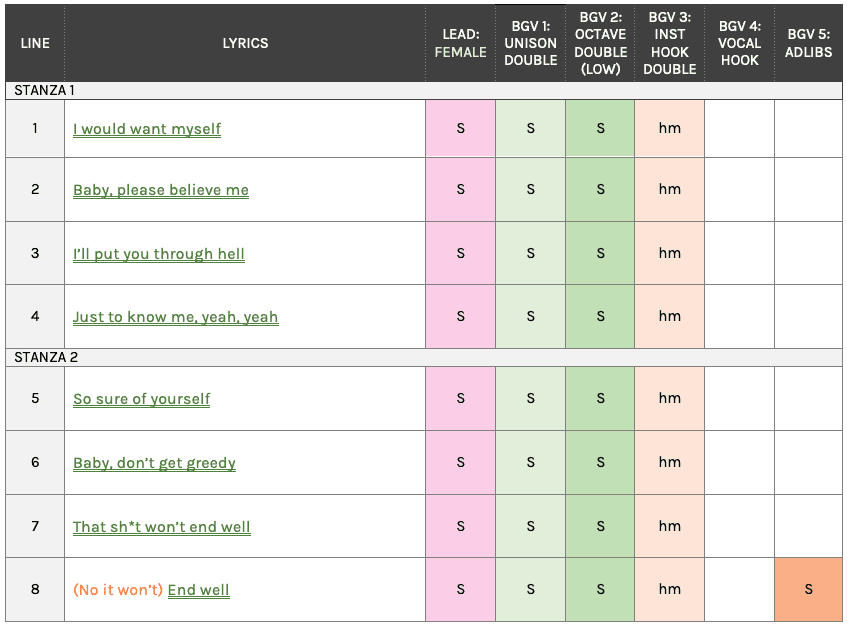

With vocal qualities from the verse providing continuity, the chorus adds additional vocal layers, adlibs, and effects to the mix, enhancing its ability to stand out and heightening the song’s emotional impact.
- A low octave double of McRae’s lead provides it with increased texture, weight, and impact.
- More pronounced use of Auto-Tune provides her voice with a unique texture while further accentuating the song’s electropop vibe.
- Delay, which is heard most notably at the end of line 4, further fills out the mix.
- A high register “no it won’t” adlib at the beginning of line 8 cleverly intertwines with McRae’s lead, further heightening interest and emotion as the section concludes.
Turnaround


Following the robust vocal production of the chorus, the brief turnaround strips it back along with the instrumental arrangement. Here, McRae’s vocal is simply treated with minimal reverb, providing it with a more direct, intimate quality. This helps draw attention to the first iteration of the nonsensical “uh” hook while providing room for vocal production growth in subsequent sections.
At the end of the turnaround, the background “woo” from the intro is reprised, providing a familiar, engaging lead in to the ensuing verse.
Verse 2


Verse 2 features essentially the same vocal production as its verse 1 counterpart, including the engaging mid-section formant processing on “loo-loo-loo-, lookin’,” which was initially used on “talk” in verse 1.
The production development compared to the preceding turnaround heightens cross-section interest, while the similarities with verse 1 creates like-section familiarity and aids in the listener’s ability to easily lock in with the next installment of the story.
Chorus 2
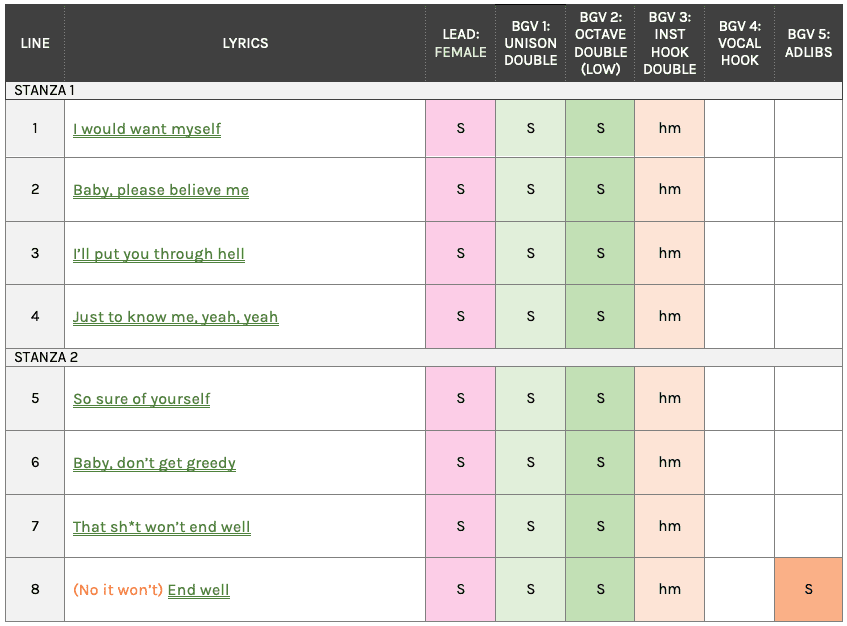

Like the relation between verses 1 and 2, chorus 2 features essentially the same vocal production qualities as chorus 1, maintaining familiarity while heightening interest.
Verse 3
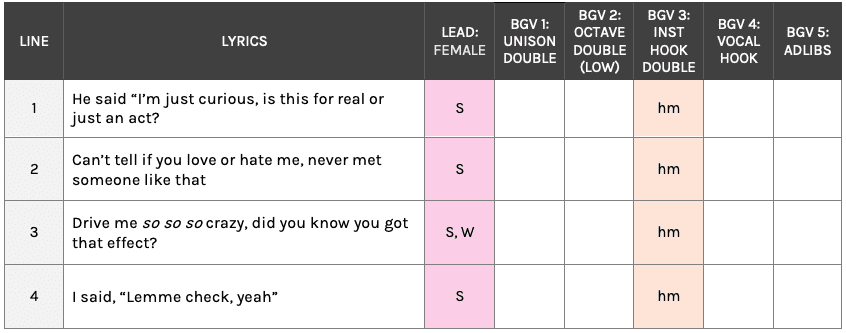

Verse 3 features the same core vocal production qualities as verses 1 and 2. The main difference is the whispered delivery of the ping-ponging “so” in line 3, which jibes with the more restrained qualities of the arrangement.
Chorus 3
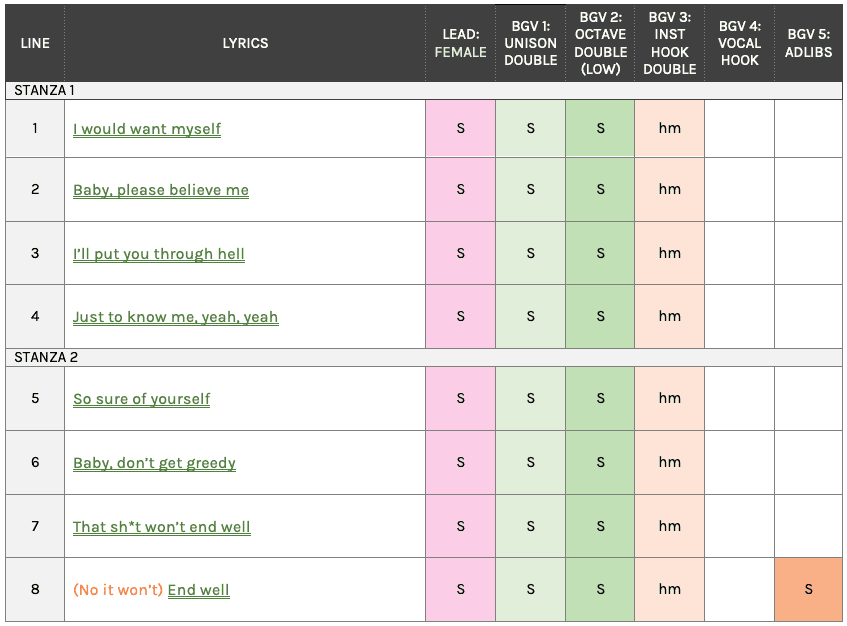

Chorus 3 features the same vocal production qualities as choruses 1 and 2, achieving the same like-section and cross-section results.
Outro
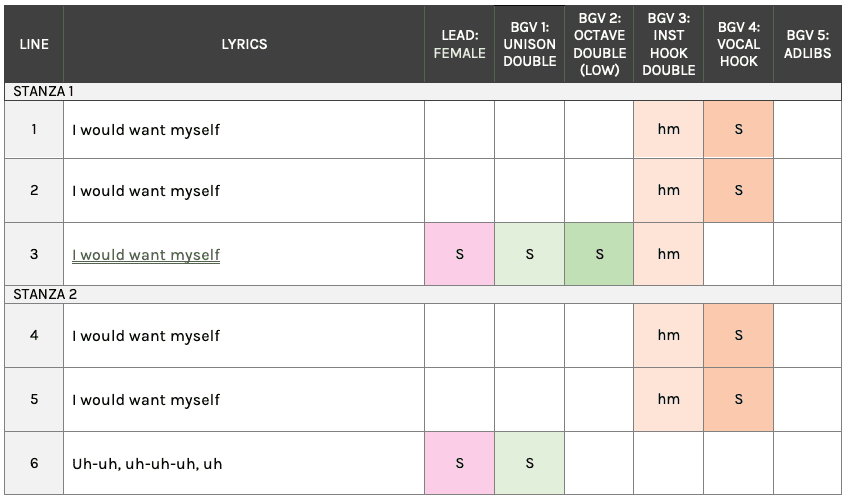

The outro features the most varied vocal production in the song, which notably heightens engagement as the song draws to a close. However, its qualities are also familiar, which helps ensure that the listener remains locked in while reinforcing key hooks.
Following the vocally dense chorus, the first two lines of the outro reprise the “I would want myself” hook, but now as a breathy background vocal. Processed with copious reverb and autopan that traverses the stereo field, this provides engaging variation against the continuity of the chorus’s energetic instrumental arrangement. Interest is then further heightened in line 3, where McRae belts the vocal out in a similar fashion to the chorus, followed by a reversion to the background vocal deliveries in lines 4 and 5.
Interest is then further heightened at the tail end of the song in line 6 through a reprise of the turnaround’s more direct and intimate nonsense hook. Here, it’s presence is further amplified by its solo featuring in the mix.
Vocal Melody


Numbers in the graphs: Depict the scale degree of each note
Curved Line: Slur across two or more pitches
Melodic subparts, such as lower-case a, b, c, reflect melodic structure both within and across lines.
The vocal melody part classifications in each section are specific to that particular section type (i.e., verses, pre-choruses, etc.) and do not relate to other section types (i.e., part A classification in verse 1 does not relate to part A in the chorus, but part A in verse 1 does relate to part A in verse 2).
Vocal melody parts are determined by pitches, rhythms, and melodic pattern commonalities.
Underlined lyrics in the vocal melody tables represent E.O.L.A. (end-of-line accentuator) nano hooks and are explained in their respective sections.
Verses
Overview
Like most hit song melodies, all three of “greedy’s” verse sections are rooted in the Hit Songs Deconstructed K.I.S.S. ME principle, an acronym for keep it simple, singable, and memorable:
- The melodies generally reside in an easy-to-sing range.
- There is abundant stepwise and stagnant motion.
- The melodic patterns logically unfold and are easy to follow.
- The rhythms are highly simplistic and easy-to-lock into.
- The relatively lengthy lines are broken into two shorter, easier-to-digest segments through the melodic contrast between phrases.
- There is ample repetition between melodies with just enough contrast to prevent a monotonous listening experience.
E.O.L A. Nano Hooks
Lines 1-3 conclude with an E.O.L.A. (end-of-line accentuator) nano hook, which is comprised of a descending 4-3-1pattern. Its inclusion heightens catchiness, connectability, and provides a familiar base for which the listener to land following subtle melodic variation in the preceding melodies.
Melodic Structure Overview & Detail
Verse 1 Melodic Direction: At-A-Glance


Verse 2 Melodic Direction: At-A-Glance


Verse 3 Melodic Direction: At-A-Glance


Verse 1 Melodic Part Structure: At-A-Glance


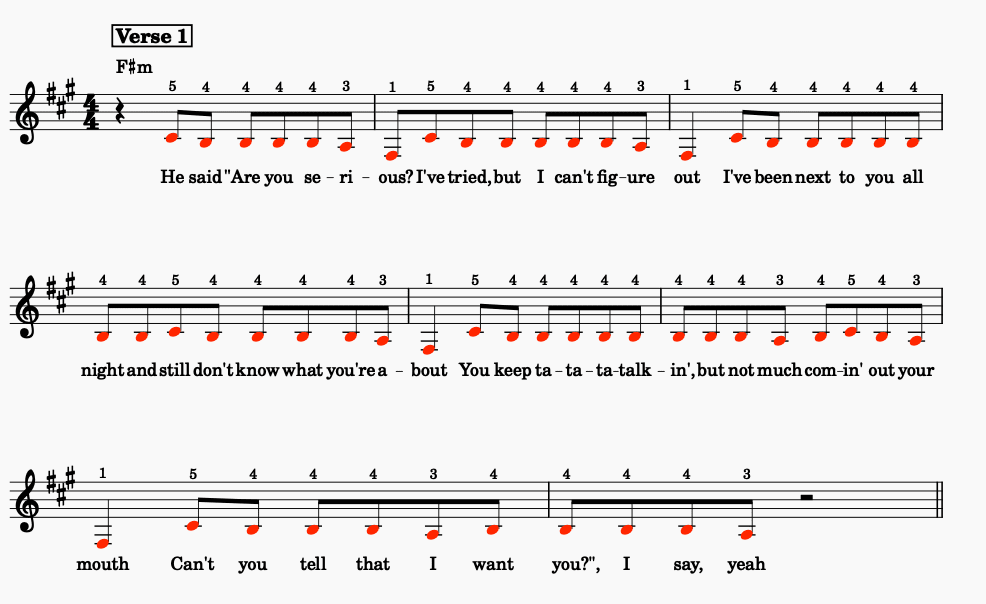

Verse 2 Melodic Part Structure: At-A-Glance


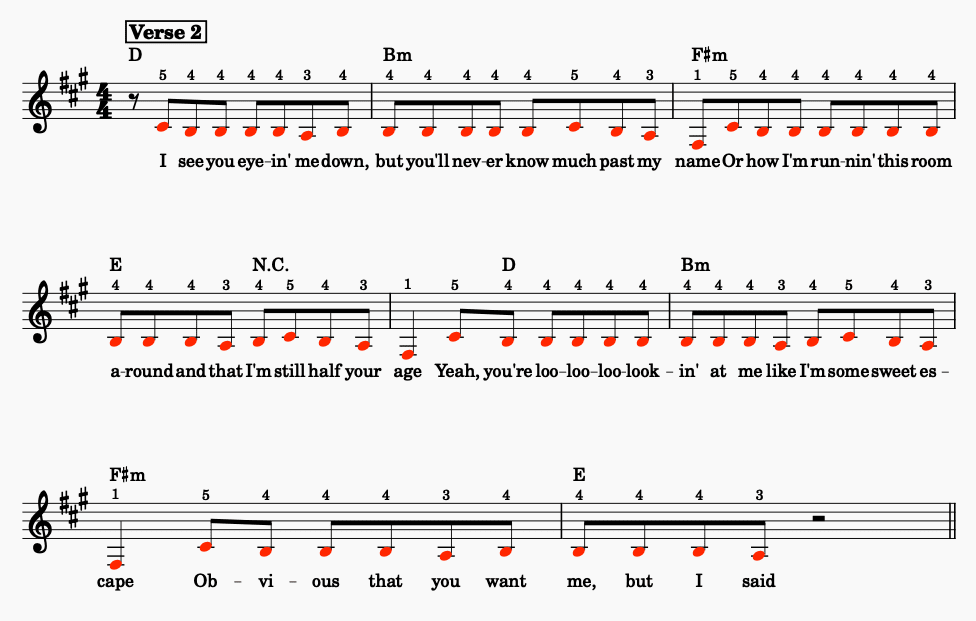

Verse 3 Melodic Part Structure: At-A-Glance


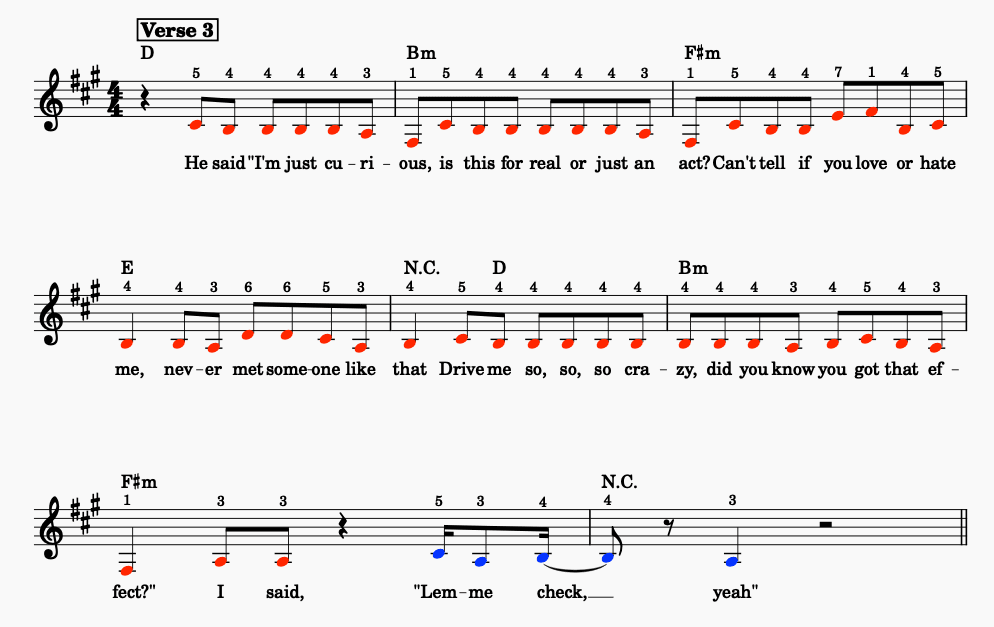

Melodic Structure Detail
Lines 1 & 2


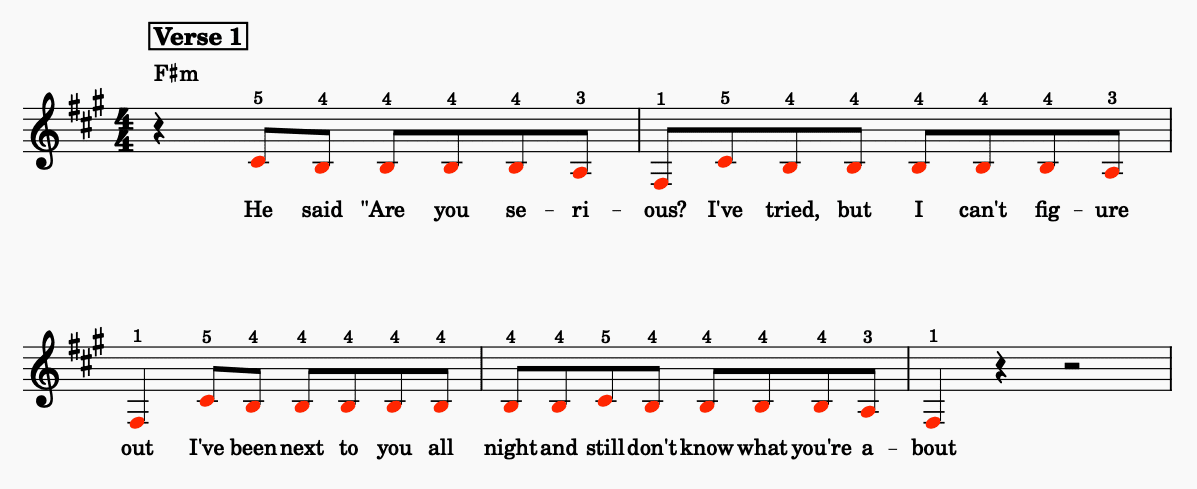

Line 1
Part a1: He said “Are you se-ri-ous?
Part a1: I’ve tried, but I can’t fig-ure out
Line 1 is composed of two back-to-back subpart a1 melodies. They are highly simplistic patterns, both starting on scale degree 5 and traversing down to the root by way of scale degrees 4 and 3 (see above for details). This, along with the mainly eighth note driven rhythms, achieves the following at the top of the song.
- It allows the listener to easily connect with and sing along to the song’s opening line.
- The directness and resolve of the pattern amplify the emotion behind the lyric, “he said ‘are you serious?’”
- The conclusion on the root provides subtle melodic segmentation against the nearly identical subpart a1 melody that follows, which begins with a leap back up to scale degree 5. This breaks the relatively lengthy 15 syllable line into two shorter, easier to digest 7 and 8 syllable segments while maintaining the driving eighth note rhythm.
Line 2
Part a2: I’ve been next to you all night
Part a1: And still don’t know what you’re a-bout
Line 2 is composed of subparts a2 and a1. It is highly similar to line 1 except for the continuation on scale degree 4 at the end of the first segment (a2) as opposed to descending to the root. This subtle variation melodically bridges the related lyrical phrases and subtly heightens interest against the otherwise repetitive melodies. The line concludes on the root in the familiar a1 melody that follows.
Verse 2 and 3 Variations
Lines 1 and 2 in all three verse sections possess a combination of melodic similarities and differences along with nearly identical rhythms. This helps to foster familiarity, memorability, and ease of connection as the song progresses, while simultaneously keeping things interesting and preventing monotony.
- Verse 2: The most notable difference in verse 2 compared to verse 1 occurs in line 1. Instead of concluding on the root in its first segment, it continues on scale degree 4, providing continuity across the lyrically unresolved phrases similar to line 2 in verse 1.
- Verse 3: In contrast to verse 2, which features a more pronounced changeup in its first line compared to verse 1, verse 3 begins with a return to the familiar a1 melodies that began verse 1. Along with heightening familiarity within the song’s main “D” (departure) section, they allow the listener to easily connect before being introduced to the more pronounced melodic changeups that that follow in line 2 (subparts a7 and a8).
Lines 3 & 4


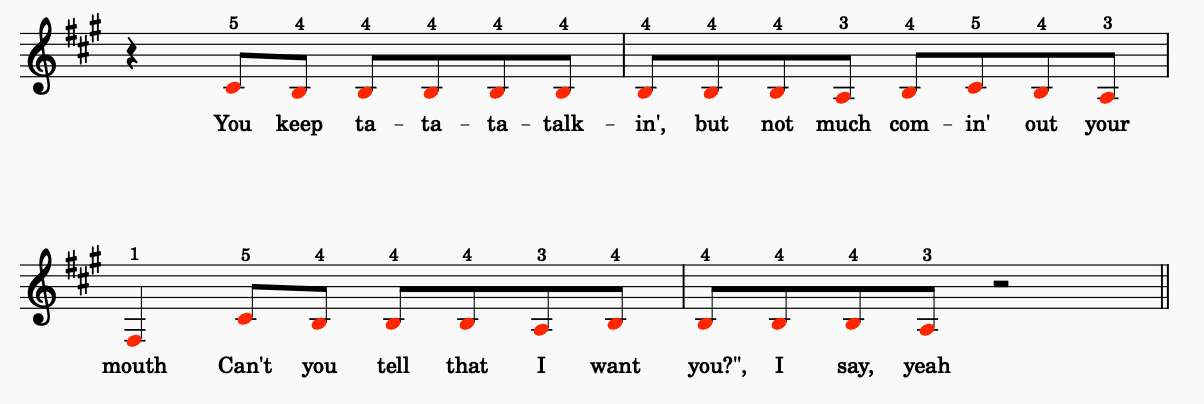

Line 3
Part a2: You keep ta-ta-ta-talk-in’
Part a3: But not much com-in’ out your mouth
Line 3 is composed of subparts a2 and a3. While subpart a2 features essentially the same melody as the first segment of line 2 that precedes it, it is kept interesting through its unique vocal production (see the vocal production segment of the report for details).
Subpart a3 possesses a more differentiated pattern compared to the subparts heard thus far in the section. However, it shares essentially the same rhythm and familiar 4-3-1 E.O.L.A. descent at the end, which brings the lyrical statement to a resolved conclusion.
Line 4
Part a4: Can’t you tell that I want you?”
Part a5: I say, yeah
Line 4 is composed of subparts a4 and a5. Subpart a4 is highly similar to subpart a2 at the beginning of lines 2 and 3, with the main difference being a brief dip down to scale degree 3 as opposed to continuity on scale degree 4.
Subpart a5 that follows is a short 4-4-3 melodic fragment. While it begins in the same manner as many of the other concluding melodies, by keeping it short and ending on scale degree 3 as opposed to the root, it creates tension, anticipation, and room for the chorus vocal pickup that follows.
Verse 2 and 3 Variations
The melodies of lines 3 and 4 are nearly identical across verse sections save for line 4 in verse 3. These commonalities are important on two key levels:
- They return the listener to familiar territory following the more pronounced variations that occur in their respective line 2’s.
- They provide a familiar lead in to the ensuing chorus in lieu of a pre-chorus.
Line 4 of verse 3 features a more pronounced melodic and rhythmic changeup compared to its preceding section counterparts. This creates a unique moment that further heightens engagement leading into the final chorus of the song by breaking the listener’s likely expectations while spotlighting the lyrical statement, “let me check.”
Choruses
Overview
K.I.S.S. ME Construction
Like the verses, the chorus is also largely rooted in the K.I.S.S. ME principle to ensure that the listener easily connects with and remembers the song’s primary “hook center”:
- There is abundant stepwise motion and generally short intervallic leaps (save for the scale degree 1-6 leap in the song title hook melody).
- The melodic patterns logically unfold and are easy to follow. In addition, the section features A.M.P.s (alternating melodic patterns), which are two nearby pitches that alternate in a stepwise or intervallic manner. Along with subtly heightening catchiness, these patterns create mainstream familiarity on a subconscious level due to their widespread use in hits throughout the ages.
- The rhythms, while more varied than the verse, are easy-to-lock into.
- The lines are short, ranging from 2 to 6 syllables in length.
- There is an effective balance of repetition and contrast.
However, the chorus also deviates from the K.I.S.S. ME principle in one key area – it resides in a high range, generally an octave above the verse. While this makes the section a bit more difficult for the average listener to sing along to, there are a few important reasons for it:
- It enables the chorus to notably stand out against the preceding verse.
- It spotlights key vocal hooks.
- It bolsters the emotional impact of the lyrics along with the melodic patterns and rhythms.
Chorus-Verse Commonalities
While not identical, the chorus and verse sections share melodic commonalities that make the song more cohesive and memorable on a subconscious level for the listener:
Chorus line 1 / Verse subpart a3 melodies
The similarities subtly foreshadow and subsequently reinforce the song’s primary vocal hook, “I would want myself.” Note that the chorus iteration concludes with a variation of the verse E.O.L.A. nano hook (5-3-1 and 4-3-1, respectively).
Chorus line 4 / General Verse Melodies
Line 4 of the chorus resides largely on scale degree 4 with an eighth note rhythm. This is a commonality shared with the melodies and rhythms throughout the verse sections.
Melodic Structure Overview & Detail
Chorus Melodic Direction: At-A-Glance


Verse 1 Melodic Direction: At-A-Glance


Verse 2 Melodic Direction: At-A-Glance


Verse 3 Melodic Direction: At-A-Glance


Chorus Melodic Part Structure: At-A-Glance
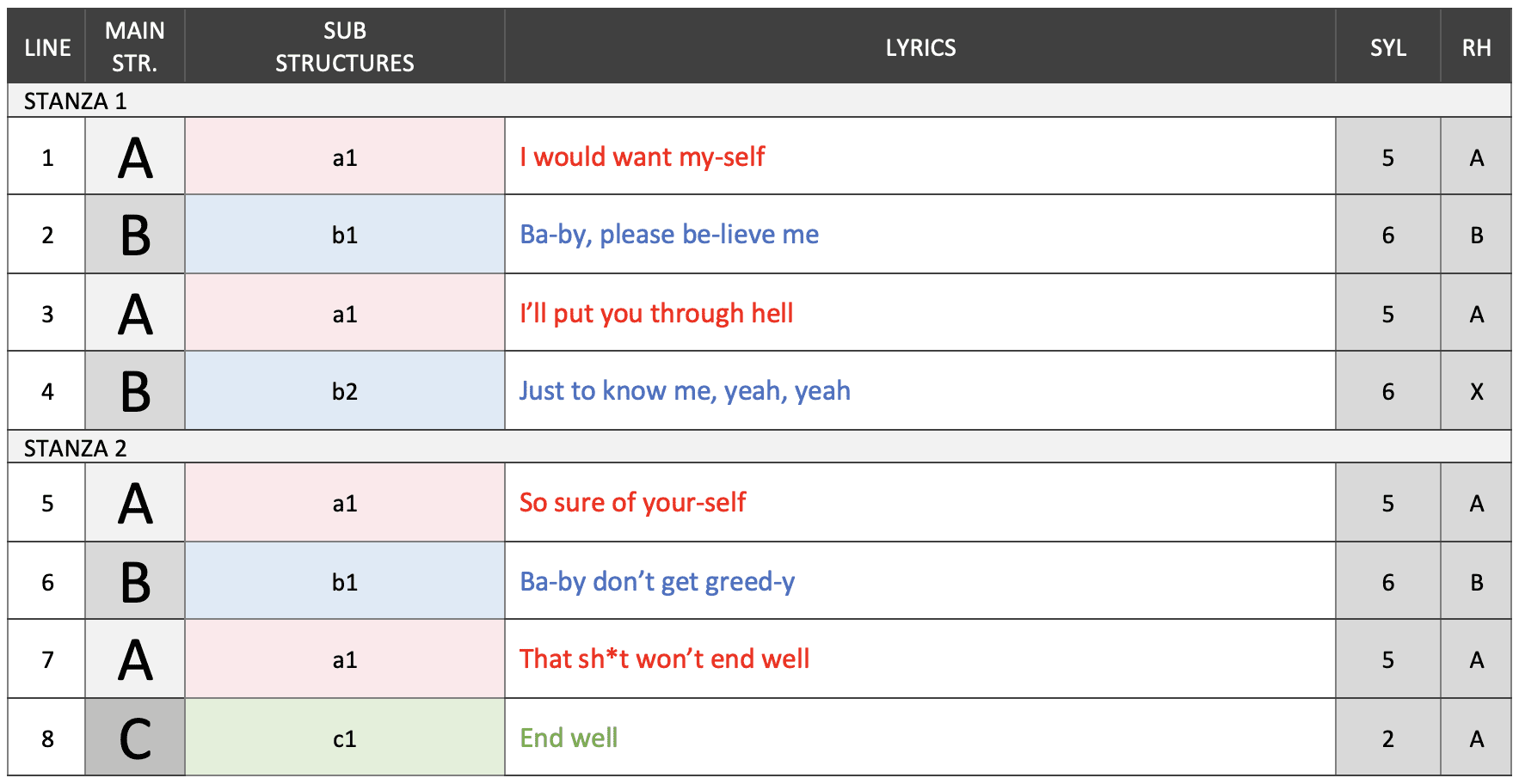

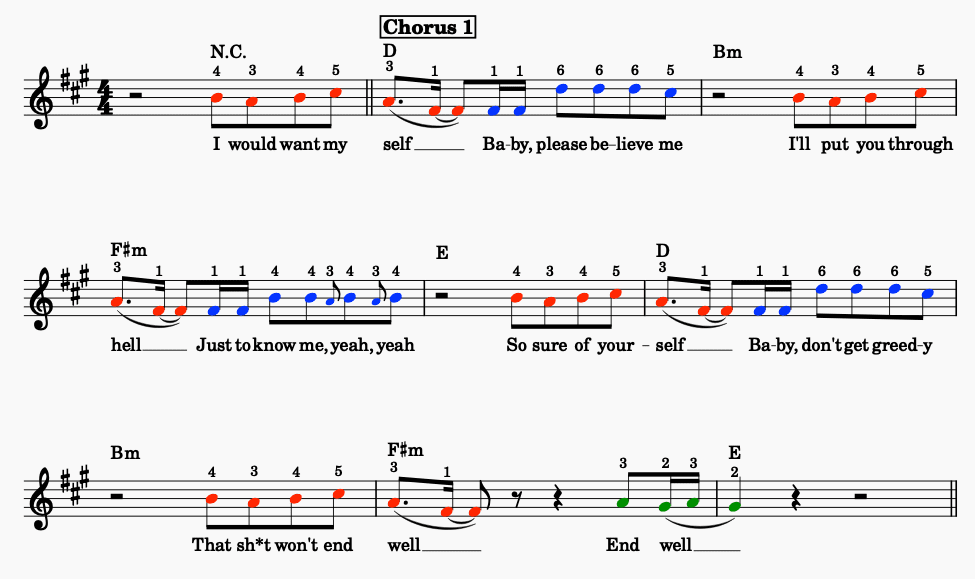

Melodic Structure Detail
Lines 1 & 2




Line 1
Part a1: I would want my-self
Chorus 1 is composed of subpart a1 and enters as a pickup at the end of the pre-chorus. Its melodic shape is highly similar to subpart a3 in the verses (4-3-4-5-3-1 vs. 4-4-3-4-5-4-3-1) but resides an octave higher and concludes with a sustained slur as opposed to individual eighth notes. Together, these commonalities and differences achieve the following:
- The pronounced ascending leap from the verse to the chorus immediately grabs the listener’s attention and ushers them into the section.
- The melody’s higher register notably calls attention to and accentuates the emotional impact of the song defining lyrical hook, “I would want myself.” In addition, the slurred sustained ending further spotlights the key lyric, “self,” while the conclusion on the root hammers it home in a definitive, resolute manner.
- The melodic shape and rhythmic commonalities shared with the verse makes the song even more cohesive and memorable. However, this is likely on a subconscious level with the listener since it is not very overt.
Line 2
Part b1: Ba-by, please be-lieve me
Line 2 is composed of subpart b1. It picks up where line 1 left off, on the root across two sixteenth notes, which are the fastest rhythms heard in the song thus far. This effectively sets up the engaging leap to scale degree 6 on the lyric “please be-lieve” before descending to scale degree 5 to conclude on the lyric “me.” Like line 1 that precedes it, these qualities serve a variety of purposes, including heightening listener engagement, spotlighting a lyric, and bolstering emotional impact, along with melodically foreshadowing the song title hook that follows in line 5 of stanza 2. The conclusion on scale degree 5 heightens tension and anticipation for the line that follows.
Lines 3 & 4




Line 3
Part a1: I’ll put you through hell
Line 3 returns to subpart a1. It melodically reinforces the “I would want myself” hook from line 1 but with different lyrics, which simultaneously heightens interest.
Line 4
Part b2: Just to know me, yeah, yeah
Line 4 is composed of subpart b2. After beginning with two sixteenth notes on the root, a commonality shared with its line 2 counterpart, it diverts through an alternation between scale degrees 4 and 3, which is the Hit Songs Deconstructed A.M.P. technique (see the overview for details). Here, it subtly bolsters the catchiness of the “yeah, yeah” lyric while heightening tension leading into line 5 that follows. In addition, the concentration on scale degree 4 is another commonality shared with lines in the verse, again subtly heightening familiarity on a subconscious level.
Stanza 2
Lines 5 & 6




Lines 7 & 8




Lines 5-7
Part a1: So sure of your-self
Part b1: Ba-by don’t get greed-y
Part a1: That sh*t won’t end well
Lines 5-7 reinforce the melodies of their lines 1-3 stanza 1 counterparts while the lyrical changeups serve to heighten interest. Here, the song title hook, “baby don’t get greedy,” stands out through its high register placement against the surrounding melodies, while the impactful statement that follows, “that sh*t won’t end well,” is delivered in a more intimidating, resolute manner with its descent down to the root.
Lines 8
Part c: End well
Line 8 is composed of subpart c. It features a unique, slurred, 3-2-3-2 A.M.P. melody, which heightens interest of the repeated lyric while providing tension leading into the hummed vocal hook that follows in the ensuing turnaround.
Turnaround
The brief turnaround reinforces aspects of both the verse melody and handpan instrumental hook in a fresh but familiar manner. Keeping it fresh and interesting in the scope of the song is McRae’s hummed delivery and nonsensical lyric.
Note that because of the familiar 4-3-1 E.O.L.A. nano hook at the end of the turnaround, the following verse (2) doesn’t repeat the nano hook at the end of its first segment. Instead, it resides mainly on scale degree 4. Had both melodies been similar, it could have resulted in melodic redundancy across sections.






Outro
Overview
The outro reprises two of the song’s main vocal hooks in fresh and familiar ways. It’s centered around the repetition of the “I would want myself” hook from the chorus, which is presented both as a unique sounding background vocal and in its familiar lead vocal form.
The section ends with the hummed vocal hook from the turnaround. This leaves the song’s main hook melody lingering in the listener’s head as the song comes to a conclusion.
Melodic Structure Overview & Detail
Outro Melodic Direction: At-A-Glance


Turnaround Melodic Direction: At-A-Glance


Chorus Melodic Direction: At-A-Glance


Verse 1 Melodic Direction: At-A-Glance


Verse 2 Melodic Direction: At-A-Glance


Verse 3 Melodic Direction: At-A-Glance


Outro Melodic Part Structure: At-A-Glance
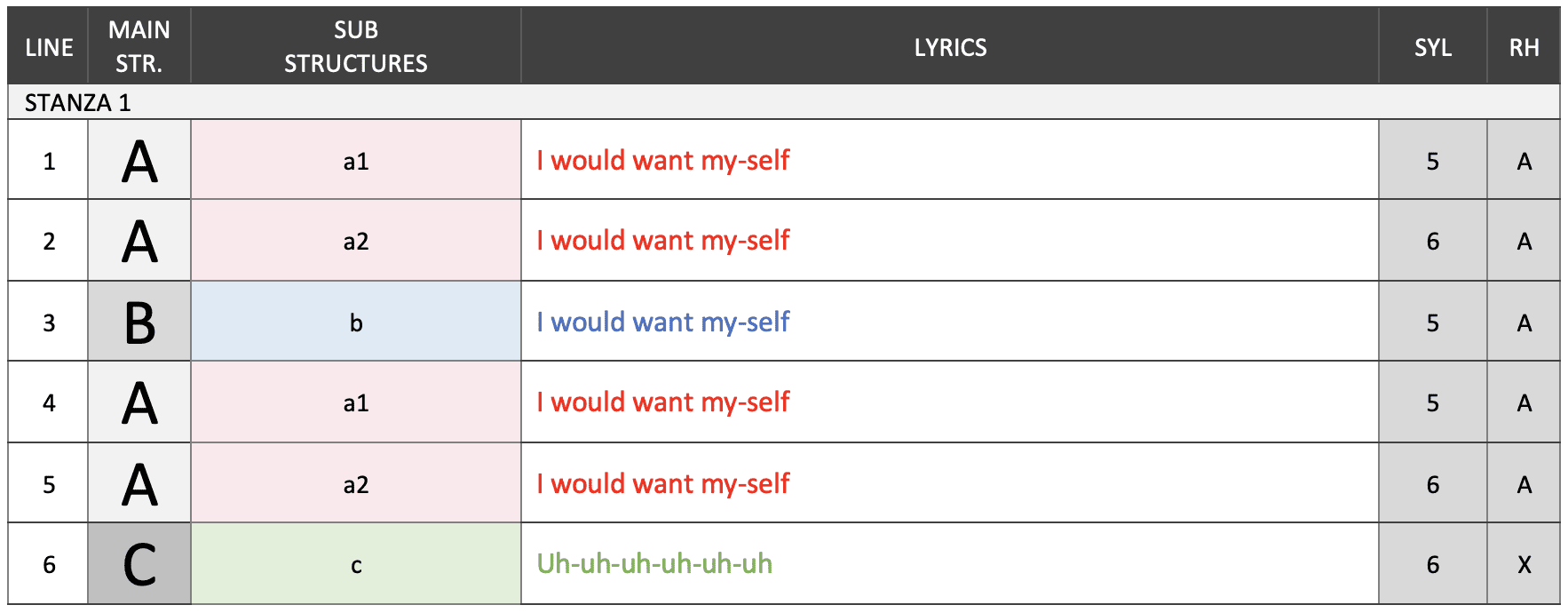

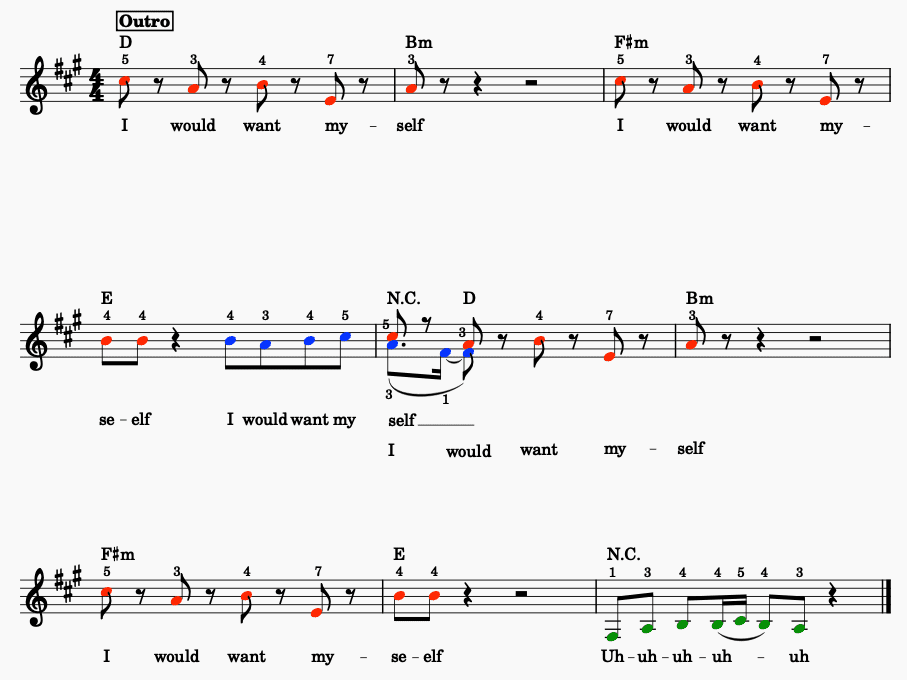

Melodic Structure Detail
Lines 1 – 3


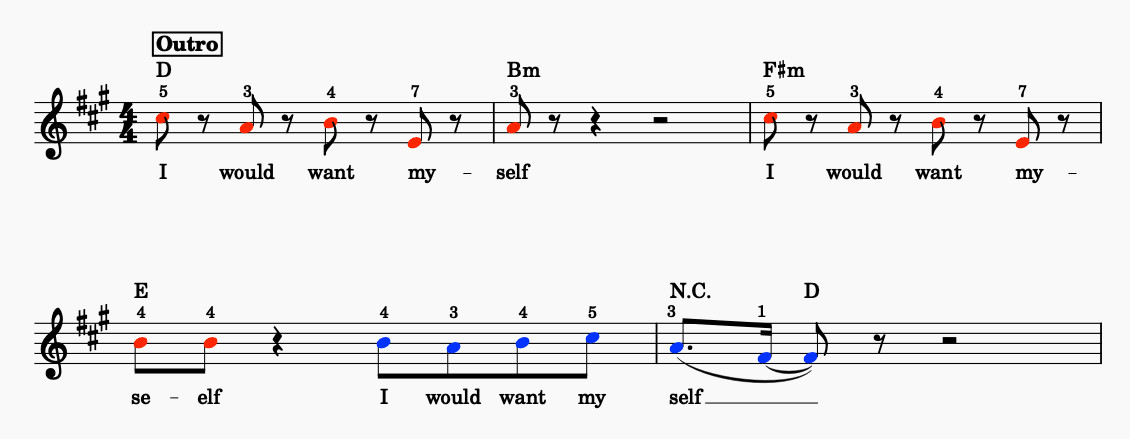

Line 1
Part a1: I would want my-self
Line 1 is composed of subpart a1. It features stepwise and intervallic A.M.P. motion across scale degrees 5-3-4-7-3, providing the “I would want myself” hook from the chorus with a unique, catchy quality along with its staccato rhythm, breathy background vocal delivery, and ping-ponging production.
Line 2
Part a2: I would want my-self
Line 2 is composed of subpart a2. It is the same as its line 1 counterpart except for the conclusion on two scale degree 4 eighth notes on the creatively segmented single syllable lyric, “se-elf.” This subtly heightens interest against the otherwise melodically and lyrically repetitive lines while heightening tension and anticipation for the chorus variation that follows in line 3.
Line 3
Part b: I would want my-self
Line 3 is composed of subpart b. It is a melodic and lyrical repetition of its featuring at the top of the chorus, hammering home the key lyric in a direct, impassioned, and resolute manner.
Lines 4 – 6


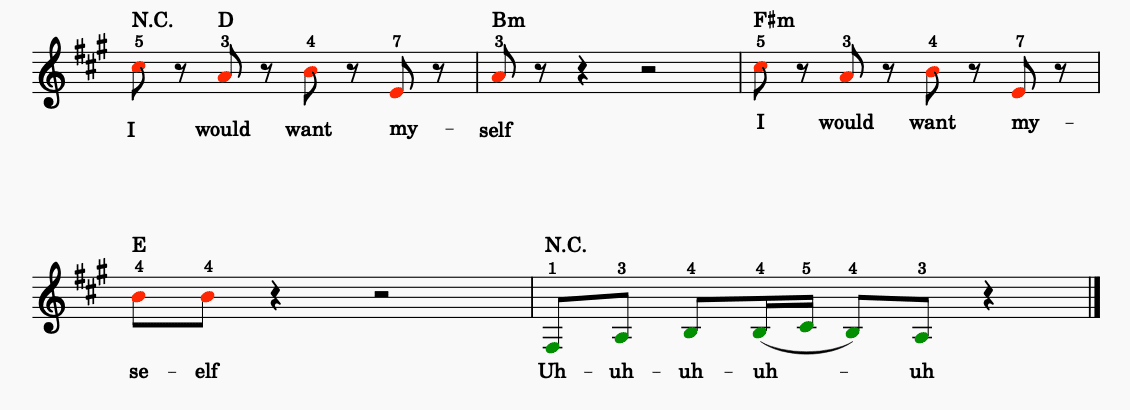

Line 4
Part a1: I would want my-self
Line 4 repeats the a1 melody and lyric that defines line 1. However, here it overlaps the line 3 lead at the beginning, albeit at a lower level in the mix. This demonstrates the complimentary qualities of the a1 and b melodies.
Line 5
Part a2: I would want my-self
Line 5 is composed of subpart a2, and is identical to its line 2 counterpart.
Line 6
Part c: Uh-uh-uh-uh-uh-uh
Line 6 is composed of subpart c. It is a return to the hummed hook melody of the turnaround, which breaks the listener’s expectation of another iteration of the “I would want myself” hook, further heightening their engagement at the end of the song along with an additional hook reinforcement.
The main difference between this iteration and the turnaround is that it ends on scale degree 3 as opposed to the root, leaving the phrase with an unfinished quality. This serves two purposes: to subvert expectations and allow the listener to fill in the “missing” note, and to leave the listener wanting more, encouraging repeat listens of the song.
Lyrics & Rhymes
Rhyme Schemes
Overview
“greedy” features an abundance of expertly crafted rhymes and other lyrical connection accentuators that bolsters the song’s ability to connect and resonate. Among them are logically unfolding end-of-line rhyme schemes and a host of strategically placed internal rhymes, double rhymes, alliterations, lyrical repetitions, and cross-section commonalities.
Key
A & B: End-of-line rhymes
X: Non-rhymes
Lyrics: The primary rhyme at the end of each line
Underline: Repetitive lyrics
Colors and rhyme schemes are unique to each section
Analysis reflects the most notable commonalities within each section
At-A-Glance: End-Of-Line Rhymes Section-By-Section


Verse 1


End-Of-Line Rhymes
Verse 1 features an AAAX end-of-line rhyme scheme across its four lines. Lines 1-3 are comprised of the A-scheme and are connected by the “OW”-sounding commonality in the lyrics “out,” “a-BOUT,” and “mouth.” Line 4 breaks this familiar pattern through its conclusion on the lyric, “I say yeah.” This serves to further heighten listener engagement leading into the ensuing chorus.
Internal Rhymes, Alliteration & Other Connection Accentuators
In addition to its end-of-line rhymes, verse 1 features a host of other lyrical connection accentuators that bolsters its connection value and memorability. Some of the most notable are:
- The internal “EYE” sounding rhymes across lines 1 and 2, including their similar placement at each line’s midway points.
- The repetition and alliteration featured in the creatively stuttered “ta-ta-ta, talk-in.’”
- The double end-of-line rhymes in the lyrics “fig-URE OUT,” “YOU’RE a-BOUT,” and “YOUR MOUTH.”
Verse 2


End-Of-Line Rhymes
Like verse 1, verse 2 features an AAAX end-of-line rhyme scheme across its four lines, creating structural familiarity across like-sections. However, the sound of the rhymes differs, which simultaneously heightens interest as the song progresses. In contrast to verse 1’s “OW”-sounding rhyme, verse 2 features the “AY”-sounding commonality in the lyrics “name,” “age,” and “es-CAPE.”
Internal Rhymes, Alliteration & Other Connection Accentuators
In addition to its end-of-line rhymes, verse 2 also features a host of other lyrical connection accentuators. Some of the most notable include:
- The similarly placed “IH”-sounding commonality across lines 1-3 in the lyrics “eye-IN,” “run-NIN’,” and “look-IN.”
- The repetition and alliteration featured in the creatively stuttered “loo-loo-loo, look-in,’” which is similar to “talk-in’” in verse 1.
- The similarly placed “past” and “half” internal rhymes in line 1 and 2, respectively, which create a near double end-of-line rhyme with “name” and “age,” respectively.
Verse 3


End-Of-Line Rhymes
Verse 3, which serves as “greedy’s” main “D” (departure) section in lieu of a bridge, deviates from verses 1 and 2 with its AABB end-of-line rhyme scheme. Lines 1 and 2 feature the A-scheme and are connected by the “AH”-sounding commonality in the lyrics, “act” and “that.” Lines 3 and 4 shift to the B-scheme through the “EH”-sounding commonality in the lyrics “ef-fect” and “check” (note that that the lyric “yeah” at the end of line 4 does not greatly affect the end-of-line rhyme connection).
Internal Rhymes, Alliteration & Other Connection Accentuators
Like verses 1 and 2, verse 3 features additional lyrical connection accentuators that serve to heighten cohesion and memorability. They include:
- The double end-of-line rhyme and alliteration featured in the lyrics “an act” in line 1.
- McRae’s pronunciation of the lyric “ef-FECT” at the end of line 3, which makes a subtle connection with the “act” and “that” end-of-line rhymes. Although this verse follows an AABB rhyme scheme, this pronunciation adjustment makes verse 3 echo back to the AAAB rhyme scheme in the preceding verses.
- The repetition and alliteration featured in the creatively stuttered “so, so, so,’” similar to the techniques used in verses 1 and 2.
- The similarly placed “EE”-sounding internal rhyme at the end of the first segment in lines 2 and 3 (“me” and “cra-ZY”).
- The string of “EH”-sounding commonalities in the lyrics “ef-FECT,” “said,” “LEM-me,” and “check,” at the end of the section. Note that the line 4 connection is bolstered by its rhythmic qualities.
Choruses
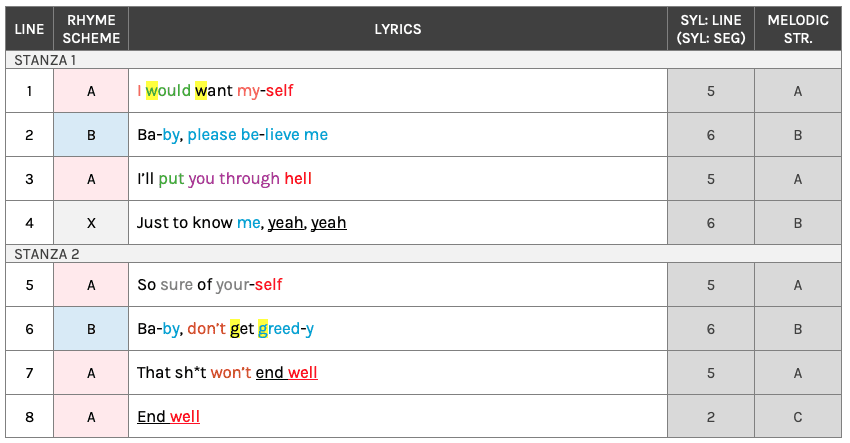

End-Of-Line Rhymes
The chorus features an ABAX/ABAA end-of-line rhyme scheme across its two four-line stanzas. The A scheme is comprised of the “EH”-sounding commonality in the lyrics “my-SELF,” “hell,” “your-SELF,” and “well.” The B scheme is comprised of the “EE”-sounding commonality in the lyrics “me” and “greed-y.” Line 4 breaks the familiar ABA pattern across stanzas through its conclusion on the non-rhyming lyric, “yeah, yeah.”
Internal Rhymes, Alliteration & Other Connection Accentuators
The chorus features a plethora of other lyrical connection accentuators that bolsters its ability to connect and resonate. Some of the most notable include:
- The repetition of the “EE”-sound in line 2’s “Ba-BY, please be-lieve me.” This, along with the reinforcement in line 4, accentuates the connection value and memorability of the song title hook, “”ba-BY don’t get greed-y.”
- The lyric “me” in line 4, which internally connects the line to the “EE”-sounding B-scheme despite the non-rhyming “yeah, yeah” lyrics that follow.
- The use of alliteration in lines 1 and 6 (“would want” and “get greedy,” respectively).
- The lyrical repetition at the end of both stanzas (“yeah, yeah” and “end well, end well”).
- The similarly placed internal rhymes across lines 1 and 3 (“would” and “put”) and lines 6 and 7 (“don’t” and “won’t”).
- The double rhymes in lines 3 and 5 (“you”/ “through” and “sure”/ “your,” respectively).
Outro
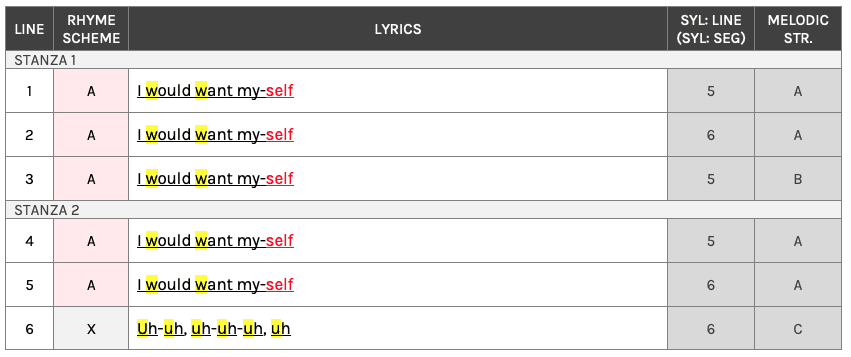

The outro simply features the repetition of the “I would want my-self” hook across its first five lines, followed by the engaging shift in the repetitive “uh-uh” hook at the end.
Narrative
Overview
"greedy" is a love/relationship and inspiration/empowerment-themed song about a confident female protagonist (Tate McRae) standing her ground against an objectifying suitor. The protagonist narrates the story, recounting the conversation between the two characters. The song’s conversational tone is enhanced by its use of mainly common lyricism, interspersed with standout statements and idioms that heighten its impact and engagement.
Above all, "greedy's" narrative appeals to a wide audience due to its themes of empowerment and self-worth. The allusion to a bar or club scene specifically targets McRae’s teen and young adult fanbase, strengthening its connection potential.
Lyrical Theme Trends
“greedy” is an inspiration/empowerment and love/relationships-themed song with romantic subject matter. Over the past five years, love/relationships has consistently been the most popular lyrical theme in non-hip hop Hot 100 top 10 hits, fluctuating between 77% and 84% of songs. However, romantic subject matter has been in decline, dropping from 38% of songs in 2021 down to 21% in the first three quarters of 2023. Conversely, songs about breakups and love lost have been on the rise.
The theme of inspiration/empowerment is even less common, accounting for just one-fifth of songs or less since 2019. A few notable high-charting representatives in the first three-quarters of 2023 include Miley Cyrus’ “Flowers” (#1), Taylor Swift’s “Karma” (#2), and Luke Combs’ “Fast Car” (#2).
Lyrical Themes In Non-Hip Hop Hot 100 Top 10 Hits: 2018 – Q3 2023
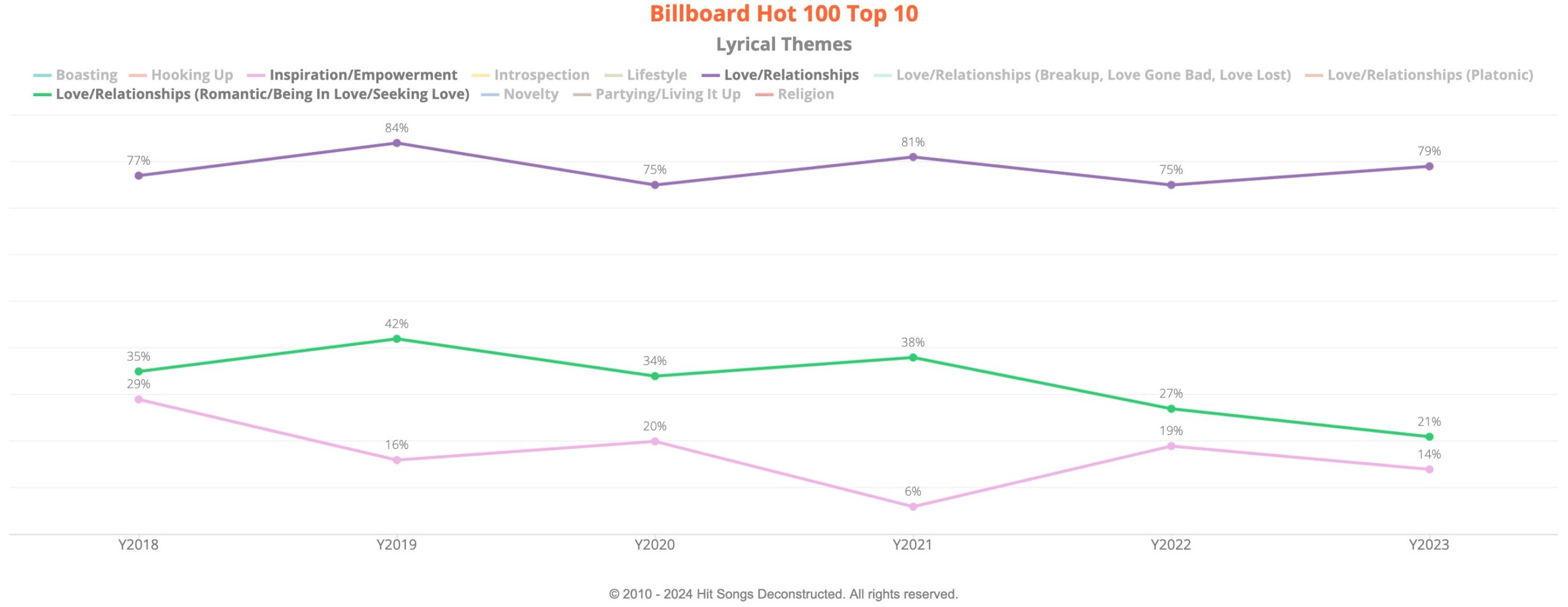

Narrative Charts Key
COM. (Communicator): The character who is doing the communicating, independent of McRae’s overarching narration
PRO: Protagonist (McRae)
ANT: Antagonist (McRae’s pursuer)
Outward: Character to character dialogue
Inward: Internal character dialog (i.e., inner voice)
Tone: The tone of the line, either positive (P) or negative (N), as it pertains to a specific character or characters noted in the analysis.
Focus: Details each line’s main character focus. In “greedy,” it pertains to Tate McRae and her love interest
A.I.D.E.: Action, imagery, detail device (metaphor, idiom, etc.), emotion. These qualities can be direct or implied.
Narrative Communication Direction: At-A-Glance
Verse 1




Opening Line
“greedy’s” narrative begins with the impactful opening line, “He said, ‘Are you serious? I’ve tried, but I can’t figure out.’” This intriguing lyric instantly draws the listener into the story through the protagonist’s recounting of a past event communicated from the antagonist’s perspective in a conversational manner. Furthermore, the line’s frustrated tone and open-endedness piques the listener’s curiosity to find out more.
Lines 2-4
The three lines that follow continue the conversational tone, with developments unfolding in a logical and cohesive manner that maintains engagement from start to finish. Here, the listener gains further insight into the backstory, namely that the antagonist is romantically interested in McRae but can’t seem to get anywhere due to her elusive qualities.
- Line 2: The verse’s second line sets the scene with a depiction of the antagonist sitting next to the protagonist for a long period of time during the night. Because specific details about the scene are left out, it leaves it to the listener’s imagination, which deepens their engagement. However, when considering McRae’s teen and young adult fanbase, the likely scenario is a bar, lounge, or club, which further heightens the story’s relatability and connection potential. Furthermore, the line conveys the antagonist’s frustration in trying to get acquainted with the elusive McRae. While the lyric reflects the antagonist’s point-of-view, it is also providing insight into the protagonist’s psyche (i.e., her elusive quality) and the dynamic between the two characters.
- Line 3: Building off line 2, line 3 depicts the protagonist’s frivolous conversation with the antagonist, which further highlights his frustration. The creatively stuttered, “ta-ta-ta-talkin’,” in addition to providing the section with additional ear candy, also cleverly infers the nonstop frivolous rambling on the part of the protagonist.
- Line 4: The last line in the section provides a couple of important developments. The lyric “can’t you tell I want you,” substantiates the antagonist’s intentions, which was intimated in the preceding lines. The following lyric, “I say, yeah,” shifts to the protagonist’s perspective for the first time in the story, effectively setting up the chorus summation and payoff that follows in lieu of a pre-chorus.
Lyricism
The verse is comprised mainly of common, basic lyricism that supports the section’s conversational structure. Each line is action-based due to the conversational dialogue between the two characters. Emotion is a core component as well, with the first three lines possessing a negative tone through the depiction of the antagonist’s frustration with the situation. Line 4 then breaks this pattern with a shift to the positive, both on the part of the antagonist (“can’t you tell that I want you”) and the protagonist (“I say, yeah”) as it relates both to the verse and the ensuing chorus.
Chorus 1
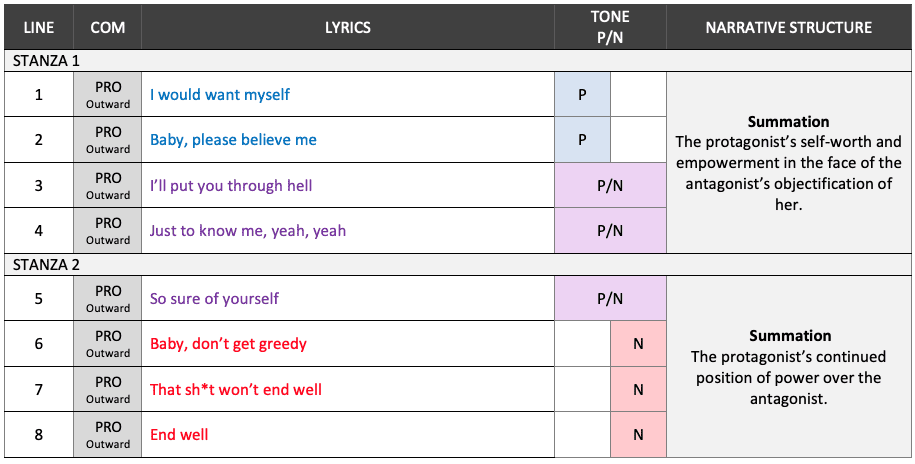

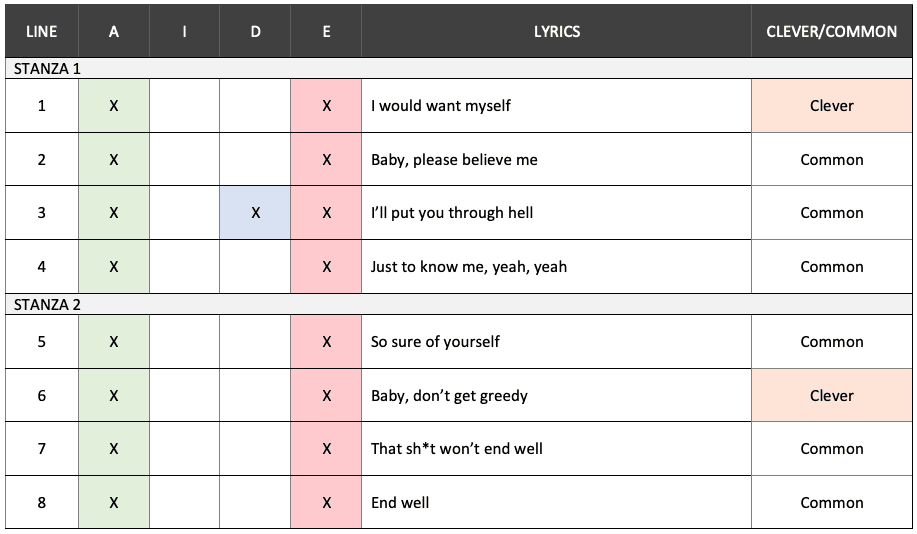

Lines 1 & 2
The chorus’s opening line, “I would want myself,” serves as “greedy’s” definitive lyrical hook. Conveyed by the protagonist to the antagonist, its egocentric, confident, and self-empowering connotation provides a powerful response to the objectification she faces from the antagonist.
The hook is effectively set up at the end of each verse that precedes it:
- Verse 1: “Can’t you tell that I want you?”, I say, “yeah…” / “I would want myself”
- Verse 2: Obvious that you want me, but I said… / “I would want myself”
- Verse 3: “Drive me so so so crazy, did you know you got that effect?” I said, “Lemme check, yeah…” / “I would want myself”
In addition to its function within the narrative, the lyric is also highly relatable to the listener and McRae herself through the sense of self-worth and empowerment it provides. Complementing this lyric is line 2’s “baby, please believe me,” which further heightens its emotional impact.
Lines 3 & 4
Lines 3 and 4 shift the protagonist’s focus from herself to the antagonist, where she states in a confident, definitive manner that she’s not going to make it easy for him to get to know her. This impactfully expands on the self-empowerment hook that precedes it, providing her with a greater sense of power over her objectifying suitor.
Furthermore, these lines summarize the following verse developments:
Chorus: “I’ll put you through hell, just to know me”
- Verse 1: “I’ve been next to you all night and still don’t know what you’re about”
- Verse 2: “I see you eyein’ me down, but you’ll never know much past my name”
- Verse 3: “Can’t tell if you love or hate me, never met someone like that”
Lines 5 & 6
Lines 5 & 6 at the top of the second stanza provide an interest-heightening development by focusing on the antagonist’s qualities as conveyed by the protagonist. Line 5, “so sure of yourself,” depicts him as cocky and arrogant. While this is alluded to throughout the song, in the chorus it’s outright stated. However, what is ironic is that while the protagonist faults him for this, she displays the same quality as depicted in line 1, “I would want myself.” This contradiction of her “wanting herself” and him being “sure of himself” puts McRae in a further position of power within the story.
Line 5 also effectively sets up and leads into the impactful song title hook, “baby don’t get greedy,” which sums up his arrogant, self-serving essence.
Lines 7 & 8
The last two lines of the chorus build off lines 5 and 6, culminating in the summative standout statement, “that sh*t won’t end well, end well.” This brings the section to a conclusion on a powerful and definitive note, capping off the protagonist’s position of power over the antagonist.
Lyricism
The continued dialogue between characters provides the chorus with a sense of action, which is set in motion at the end of each preceding verse (i.e., “I say…”, “I said”). The section is highly emotive as well, with tones varying as follows:
- Lines 1 and 2 feature a positive tone as they pertain to McRae’s empowerment and self-worth.
- Lines 3 and 4 possess both negative and positive tones based on their relation to both characters in the story. For the antagonist, these lines possess a negative connotation because McRae is going to “put him through hell just to know him.” However, for McRae there is a positive empowering connotation because she is the one in control.
- Line 5 can also be construed in both a negative and positive light. While the antagonist being “so sure of himself” is a turnoff for McRae, in his eyes, it’s likely an attribute.
- Lines 6, 7, and 8 all possess a negative tone, as they reflect McRae’s warning to the antagonist that his pursuit of her will not end well should he remain “greedy.”
In terms of the sections balance of common and clever lyricism, it leans mostly common, which supports the conversational structure. The two exceptions are the “I’ll put you through hell” idiom and the clever/impactful song title hook, “baby don’t get greedy.”
Turnaround
The brief turnaround features the first of two nonsense hook iterations. While it does not possess a lyrical meaning, it provides the song with an additional fun, catchy quality while providing a brief break in the narrative.
Verse 2


Verse 2 develops the story while remaining in-line with the overarching theme. Whereas verse 1 focused on the antagonist’s frustration of not getting anywhere with the protagonist, verse 2 focuses on his objectifying actions towards the protagonist and her dismissive and empowering reaction.
Objectifying (Antagonist):
- Line 1: “I see you eyein’ me down”
- Line 3: “Yeah, you’re loo-loo-loo, lookin’ at me like I’m some sweet escape”
Dismissive/Empowering (Protagonist):
- Line 1: “but you’ll never know much past my name”
- Line 2: “Or how I’m runnin’ this room around and that I’m still half your age”
Verse 2 features a few key differences compared to the other sections of the song, which further heightens listener interest and engagement. One of the most notable is the shift in conversation direction. As opposed to continuing the external conversational dialog between the two characters, here the protagonist goes inward as she assesses the situation. Additionally, verse 2 makes greater use of non-specific, imagery invoking lyricism (lines 1 and 3) and clever-leaning lyrics:
- “I see you eying me down”: A clever way of detailing the antagonist’s objectifying and attraction towards the protagonist.
- “Or how I’m runnin’ this room around and that I’m still half your age”: A clever way of depicting McRae being in control while diminishing the antagonist.
- “Yeah, you’re loo-loo-loo, lookin’ at me like I’m some sweet escape”: Another clever way to depict the antagonist objectifying the protagonist and wanting to use her for his own “greedy” purposes.
Verse 3




Verse 3 provides the final lyrical development in the song. It returns to the core structure of verse 1, which depicts the protagonist’s retelling of the antagonist’s conversation with her. It essentially reiterates the confusion he feels along with his desire for her while setting up the third and final chorus.
Also like verse 1, verse 2 features one clever-leaning lyric, “Drive me so so so crazy.” What’s clever about it is possible dual meaning in the context of the story. On one end, “crazy” can be interpreted as the antagonist’s intense desire for the protagonist. However, it can also be interpreted as him being driven “crazy” by the protagonist due to the mixed messages he’s getting.
Outro
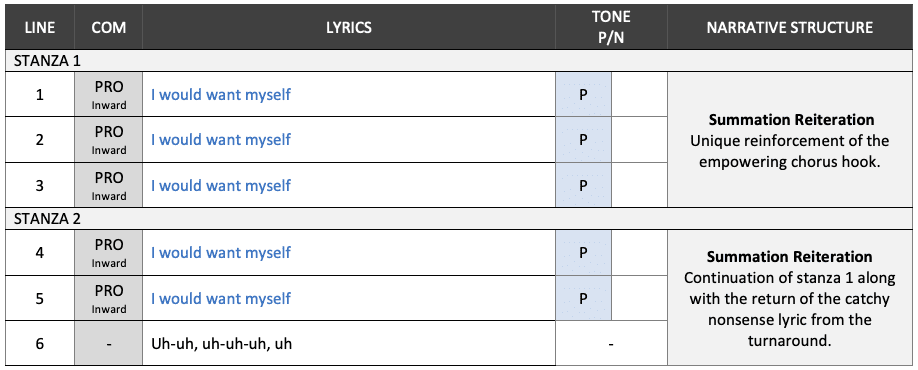

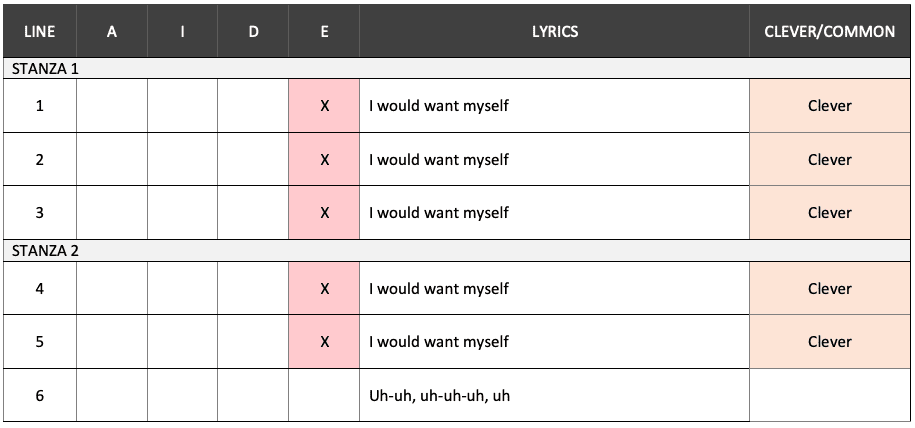

Following the third and final chorus, the outro repeats the chorus’s main lyrical hook, “I would want myself,” in a fresh new context. While the chorus features the hook as part of the external dialog between the protagonist and antagonist, here it is mainly communicated with the protagonist’s inner voice, which further accentuates her sense of empowerment and self-worth. Putting this into effect is the hook’s background vocal delivery across lines, with the exception the temporary shift back to lead in line 3, which further heightens its emotional impact and engagement.
At the tail end of the section, the nonsense hook from the turnaround returns, concluding the song on a lighter, catchy note.
Hooks
McRae and her team of hitmakers masterfully transformed catchy melodies into standout hooks using tried-and-true "hook dressing" techniques. These techniques include melodic spotlighting; leveraging the song title; incorporating two standout statements; infusing fun, nonsense lyrics; employing repetition (the HSD "say it again" technique); and integrating unique timbres.
In addition to their skillful deployment, the song's catchiness and memorability are heightened further through clever hook foreshadowing and creative reinforcement techniques, ensuring that "greedy" not only leaves a lasting impression but also avoids overstaying its welcome.
“greedy’s” Hook Arrangement
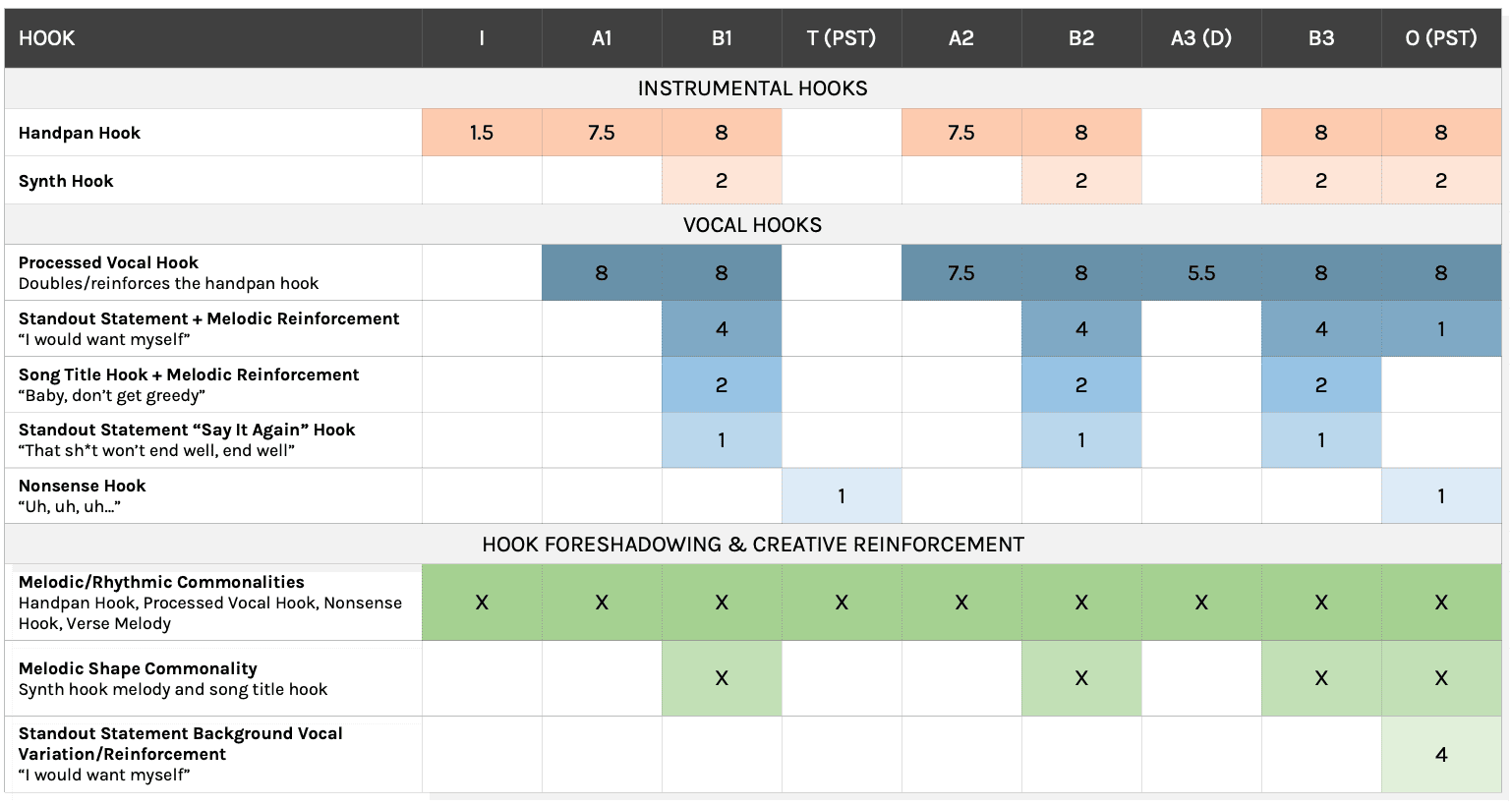

The leaping, melodically spotlighted second line in the chorus, "baby, please believe me," may seem lyrically unremarkable, yet it plays a vital role in melodically and rhymingly foreshadowing the song title hook, "baby, don't get greedy," which emerges later in line 6. Complementing this is the newly added synth “nano hook,” which provides the section with a catchy, atmospheric embellishment, and foreshadows and subsequently reinforces the song title hook’s melodic shape.
Lastly, the chorus concludes with the lyric, "that sh*t won't end well, end well," another standout statement that employs the commonly used "say it again" repetitive "hook dressing" technique.
All-in-all, the chorus is a bonified hook fest, strategically introducing and reinforcing hooks as it progresses to ensure that the song’s primary “hook center” gets firmly ingrained in the listener’s head.
With the handpan hook providing familiar accompaniment, the chorus standout statement, "I would want myself," is cleverly echoed as a background vocal. Compared to the chorus, it is uniquely delivered with a rhythmically displaced approach that traverses the stereo field, providing the outro with additional sonic interest as it is further reinforced with the listener. Midway through the section, a single instance of the proper "I would want myself" vocal from the chorus resurfaces, further reinforcing its presence and enhancing engagement within the otherwise repetitive section.
The final hook heard in "greedy" is the nonsensical "uh" hook, initially introduced during the brief turnaround. In the outro, it stands alone without any accompaniment, emphasizing its distinctiveness and connection with the listener. The hook cuts off abruptly at the tail end of the song, leaving the listener with a sense of anticipation and most notably, a likely longing for more.
Note this report is published in segments. Stay tuned for the next segment detailing the song’s lyrics and narrative.
Companion
Logic Project
This file includes the correct meter, tempo and song arrangement displayed as empty MIDI regions for each instrument. Load your copy of the song to see when each instrument enters and leaves the mix, how the arrangement of like and cross-sections compare, how energy and dynamics are working from an arrangement point of view, and more.
Skip To:

